Last reel tape recorder manufactured in the late 1960's
Telex was acquired by Memorex in 1988 and went out of business in the mid-1990's.
Click on brochure cover left above to view entire brochure in pdf
 On September 29, 2012 we were saddened to receive word from Dave Boyers, that his Dad John Boyers, the last Magnecord founder, had passed away.
On September 29, 2012 we were saddened to receive word from Dave Boyers, that his Dad John Boyers, the last Magnecord founder, had passed away.
Here is Dave Boyers' message.
"Gentlemen,
The last remaining founder of Magnecord, Inc. has now passed into history. Dad has wanted to go be with my mother for some time now, suffering the ravages of Alzheimer's for several years. His wishes were finally granted.
To the degree he could understand it, it has been no small measure of pride that so many people have come to know and appreciate the work he did half a century ago to further the art and science of audio recording.
Similarly, the work all of you do to keep the memory of those early pioneers alive is not only worthwhile, but also gives others like Dad a sense that the efforts they made are not forgotten.
Best wishes to you all, db"
Here is a wonderful summary about Magnecord written by John Boyers (seen to the left in 2012 looking at Phantom's DVD set) - view pdf
Dave Boyers, John Boyers son donated to our Museum the original prototype Magnecord PT-6 reel tape recorder and its companion amplifier given to him by his Dad. Read the full story at this link.






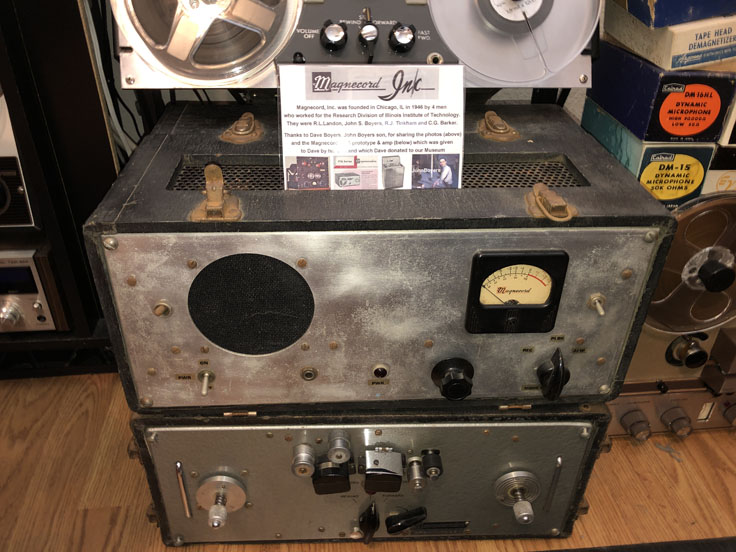
View copies of the Magnecord Newsletters - Click on the photos to view the full issue in pdf
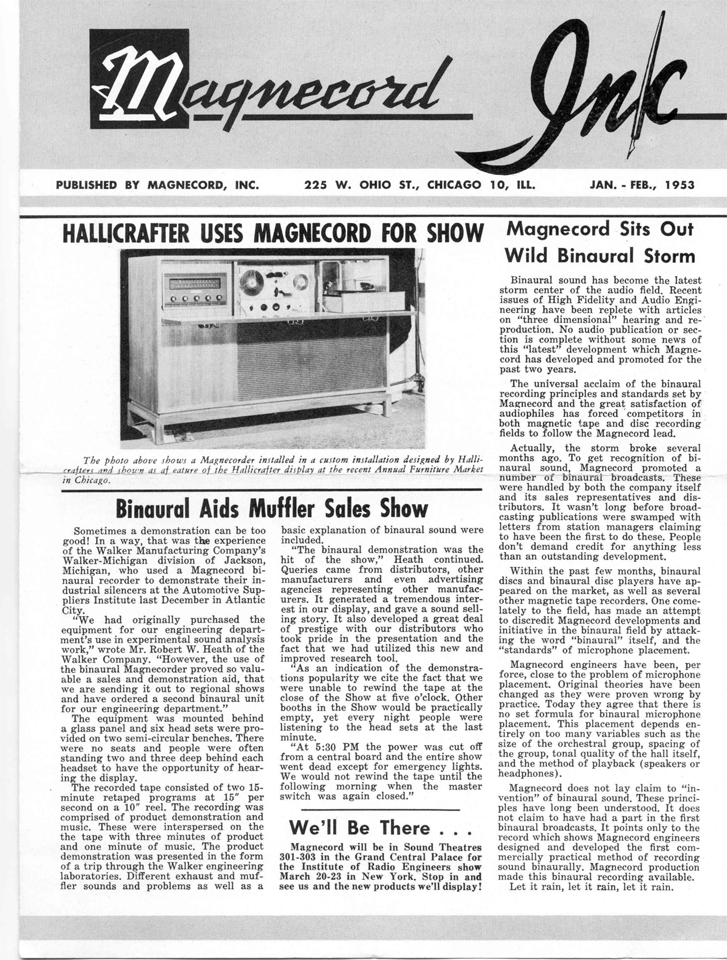
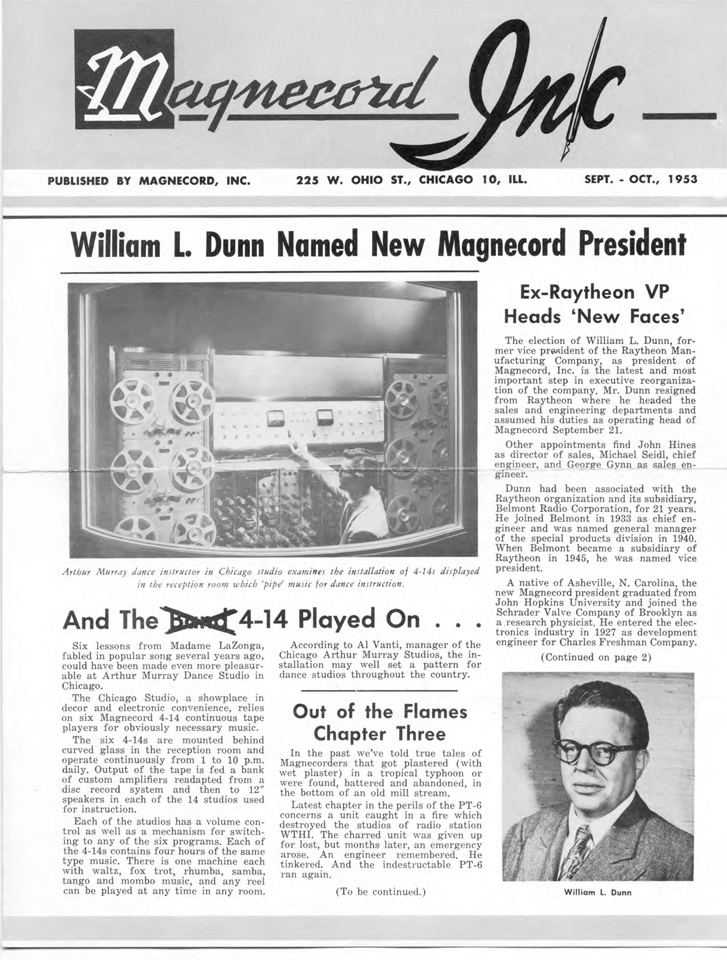


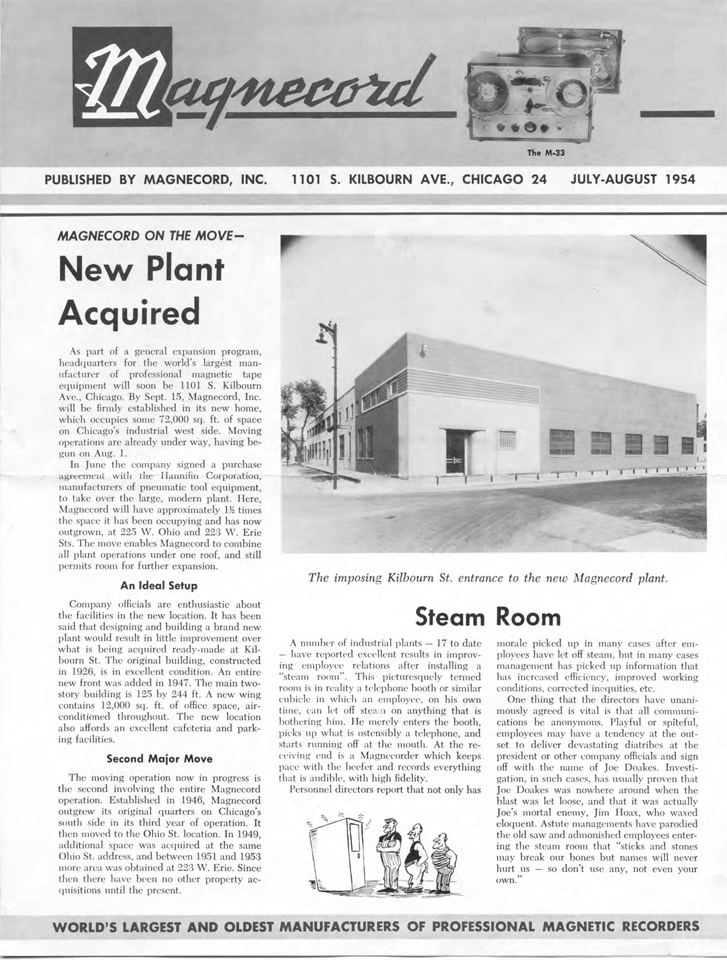
Please go to STORIES of Magnecord for much more information and background
Magnecord recorders in our collection
|
Prototype Magnecorder PT6 with amplifier.
|
 1949 ad |
|
- Freq Response50 -15,000
- Signal to Noise 65 db
- Speed 3.75, 7.5 & 15 ips
-
Motors 3
- Reels 7"
- Timing accuracy .3%
- Weight 74 lbs
- Price prototype proof of concept models
For more, please go to this link |
The Magnecord PT-6 and its amplifier (above) are early prototypes donated by Dave Boyers, son of one of Magnecord founders John Boyers
|
| |
Magnecorder PT6J-AH & PT6-J
|
Magnecorder M30, M33 |
Magnecorder M30, M33 |
|
|
|
|
|
|
| |
Magnecord P 63 Pro Deck with Magnecord P 60C amp 1956 |
Magnecord
S-36B |
Magnecord
1024 |
|
|
|
| |
|
|
|
|
|
Magnecord 1020/HeathKit AD-16
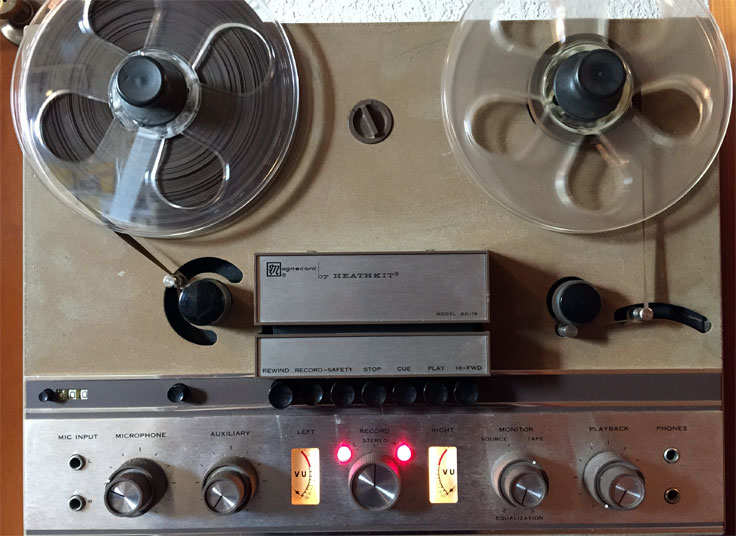
Magnecord 1020 / HeathKit AD-16 reel to reel tape recorder donated by Lawrence Grover to the Museum ofagnetic Sound Recording
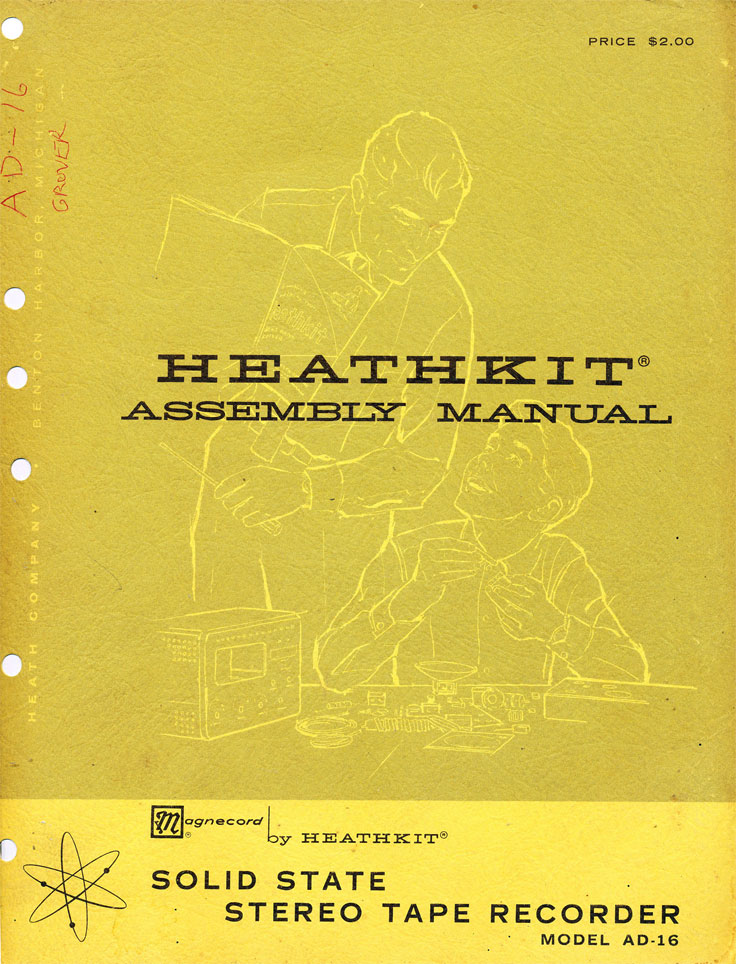 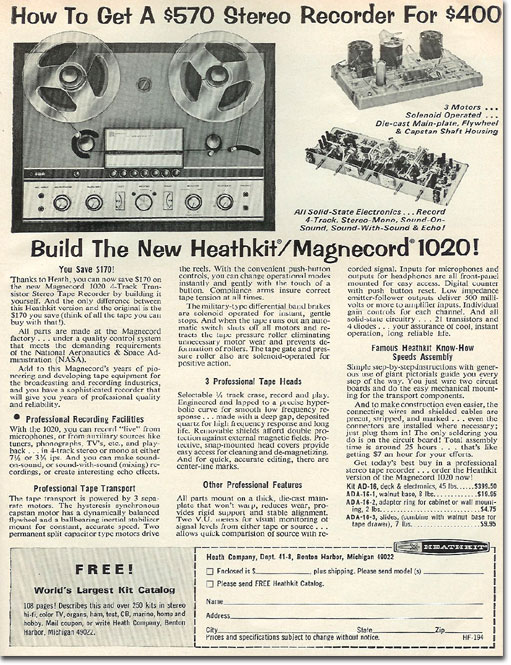
|
|
|
|
|
|
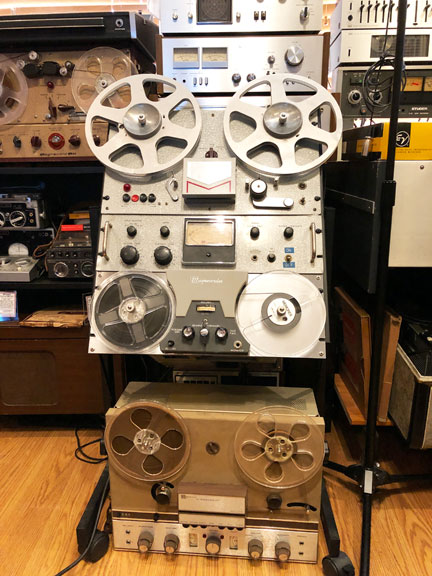
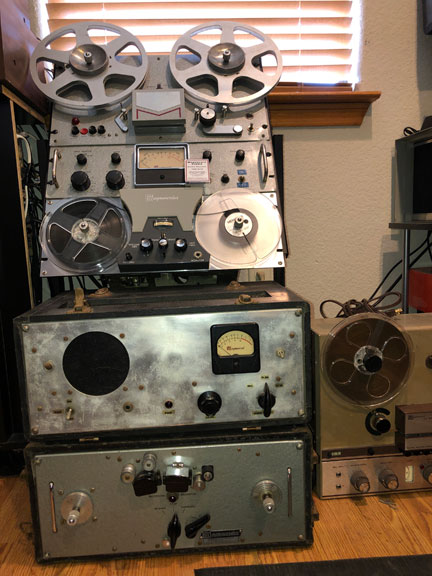

Dave Boyers, John Boyers son, donated the original prototype Magnecord PT-6 reel tape recorder and its companion amplifier given to him by his Dad. Read the full story at this link.

|
|
|
|


The Magnecord SD-1 Professional Wire Recorder 1947
view video converted from 16mm of the SD-1 being built
The Magnecord SD-1 was the only truly professional wire recorder manufactured. It never went into mass production as Magnecord followed the trend moving into magnetic tape reel to reel tape recorders.



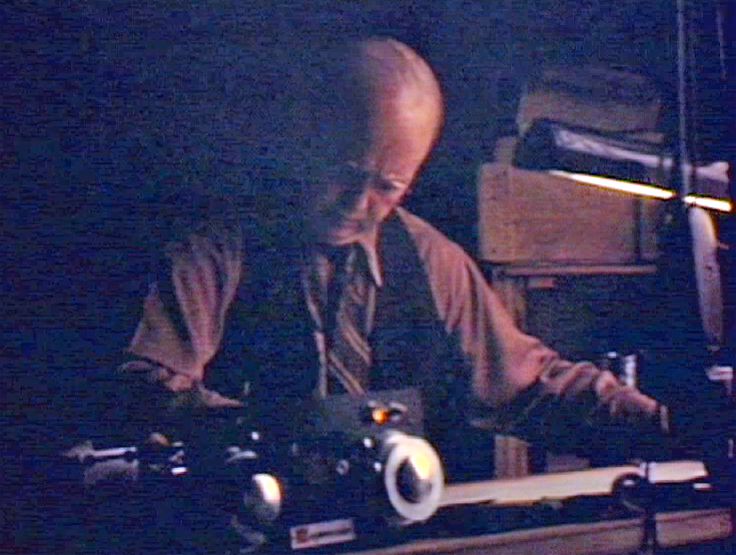
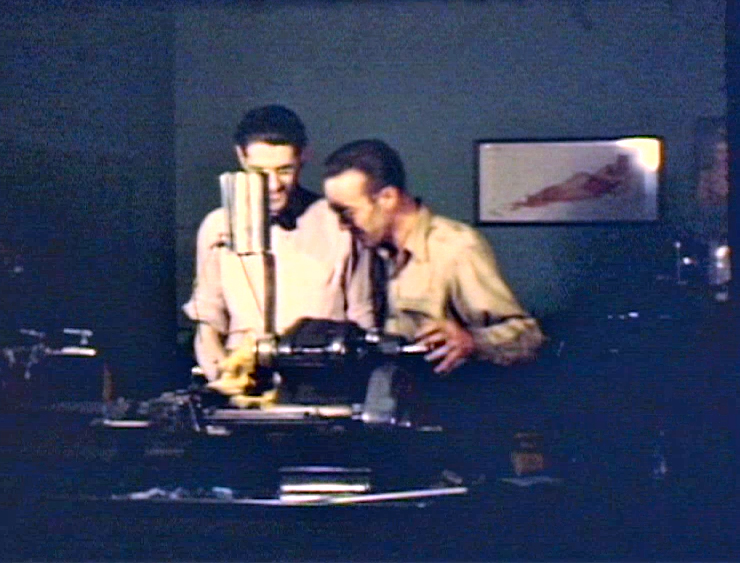
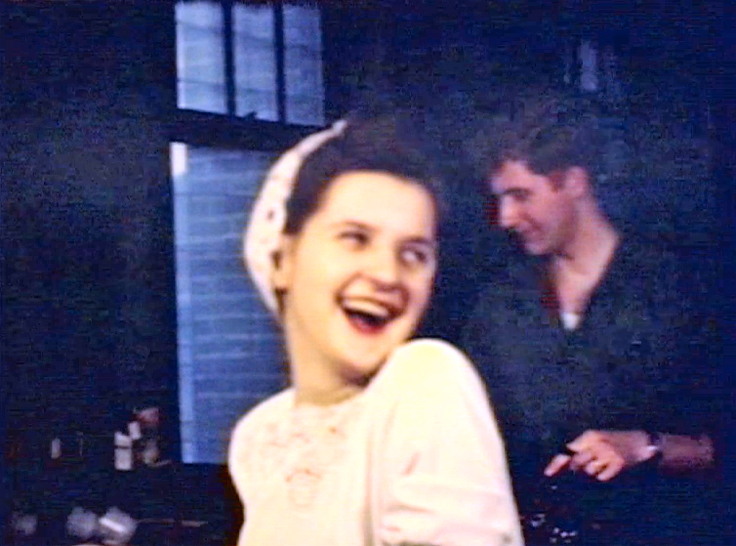
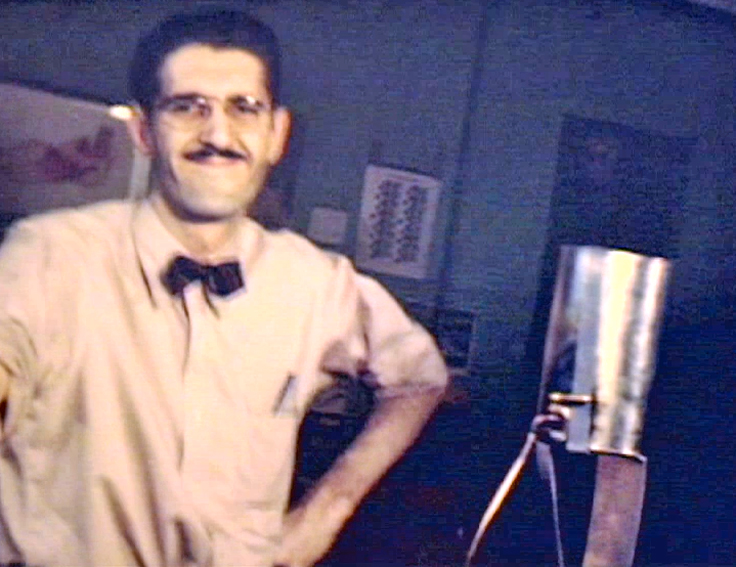
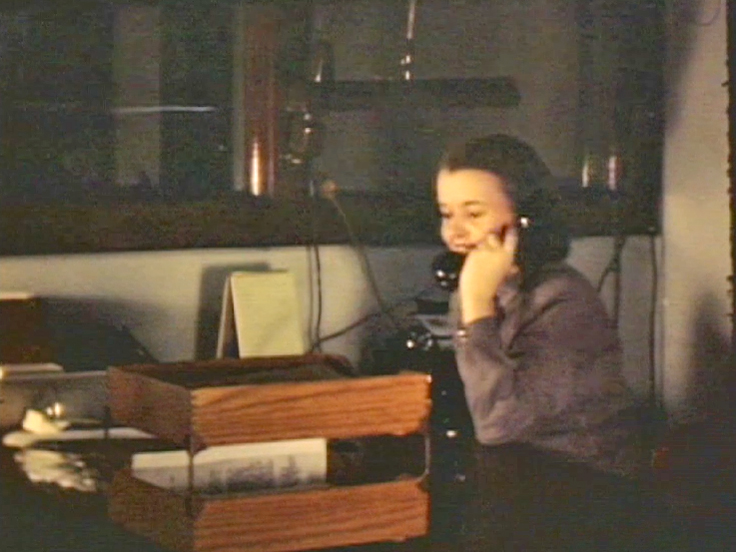

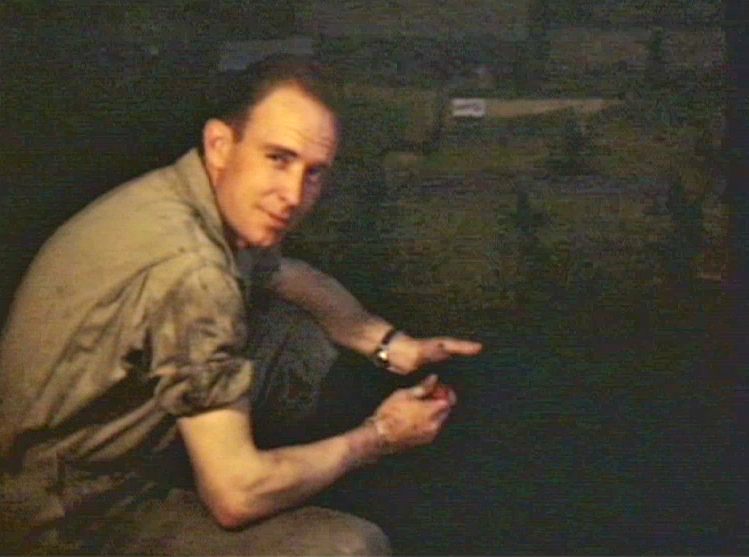
Hanna, Phil. "U. S. Youth Still Shows Courage and Ingenuity." Chicago Daily News, July 29, 1946, p. 22. 
"Those who think this generation of American youth has lost some of the traditional courage and ingenuity of the nation's builders ought to acquaint themselves with the five young 'partners' in Magnecord, Inc., 304 W.63rd st. Here one sees two former combat correspondents in the Pacific and three electronic technicians teamed up. They've started manufacturing special purpose high fidelity wire recording machines for radio station recording, motion picture producing and other scientific work. Among other products is an anti-wire tapping device. After a message is put on a wire recorder, the device 'scrambles' the message as it is being transmitted. That makes it unintelligible. At the receiving end the device 'unscrambles' the message, and the recording 'plays' the message properly.
Magnecord, Inc., is operating under a license from the Armour Research Foundation along with 30 other licensees. But the other licenses are devoting themselves to mass-produced wire recorders for home and office use, while these boys are looking toward demands from the technical and professional field. Their recorder is designed for special, high-grade work, such as recording unusual sound phenomena in research laboratories.
R. J. Tinkham, president, is an Armour Research man and a graduate of the University of Illinois. He is an acoustical engineer, did research work on wire recorders and other special devices for the Bureau of Ordnance, U.S.N., during the war. , John S. Boyer chief engineer, another Armour man, did research on underwater sound devices at the New London (Conn.) laboratory of Columbia University. He also did research work on radar at the radiation laboratory of Massachusetts Institute of Technology. Frederick A. Baxter, secretary, and C. G. Barker, sales manager, were war combat correspondents in the Pacific for three years; made the first combat wire recording at Mount Tapotachu on Saipan; made the first recordings for Army air shows. Their recordings were sent to the United States for use by radio stations and to Honolulu for conversion into wax records which were distributed over the United States. Barker worked at Armour Research Foundation prior to forming Magnecord. R. L. Landon, another Armour man, fifth member of the 'Five Horsemen,' is production manager. He worked on atomic bomb research at the University of Chicago and had war plant production experience. . . ."
Hanna, Phil. "Recorders Pay Off For 5 Young Men." Chicago Daily News, Nov. 30, 1949, p. 42.
"Back in July, 1946, I wrote about five young fellows who worked for the Research division of Illinois Institute of Technology. They set up shop at W. 63d st., to make a special purpose high-fidelity wire recorder. Their youthful enthusiasm for going into business on their own was notable. I had an idea they would succeed. So the other day I checked up to see what they had done in three and a half years on their own.
Like so many new firms, they altered their product in May, 1948. They are selling a tape recorder to broadcasting stations and other professional users. They tell me all national radio networks use their machines; that of a total of 3,000 professional users, they have 2,300 machines in use. They say they are doing special work for such firms as the Bell Telephone Laboratories.
The little firm, known as Magnecord Inc., has outgrown the 63d st. location with 2,000 square feet. It is now housed at 225 W. Ohio st. with 9,000 square feet. They have 90 employees compared with 12 at their former location, are doing $90,000 a month in sales. R. J. Tinkham, 38, is president. Their success is helped along by a vigorous sales policy. C. G. Barker, 28, sales manager, says that no matter how good your product, it has to be sold by intensive solicitation. He doesn't believe in the 'better mousetrap' theory. He set up 11 regional factory representatives and 106 distributors, and says business is especially good in the Southeast - that Georgia is booming. J. S. Boyer, 34, is chief engineer. He has four other young engineers constantly working to better the product. R. L. Landon, 32, is production manager, which rounds out about the most closely knit top organization I have recently seen. F. A. Baxter, the fifth of the original group, left the organization.
'Don't think we didn't have our troubles,' says Tinkham - 'we know what a 70-hour week is. But Chicago firms helped, the bank helped - and now we can see daylight.' A net worth of $121,000 seems to confirm."
Photos below from the Magnecord factory provided by Dave Boyers (son of founder John Boyers) with referral from Chris at Preservation Sound.
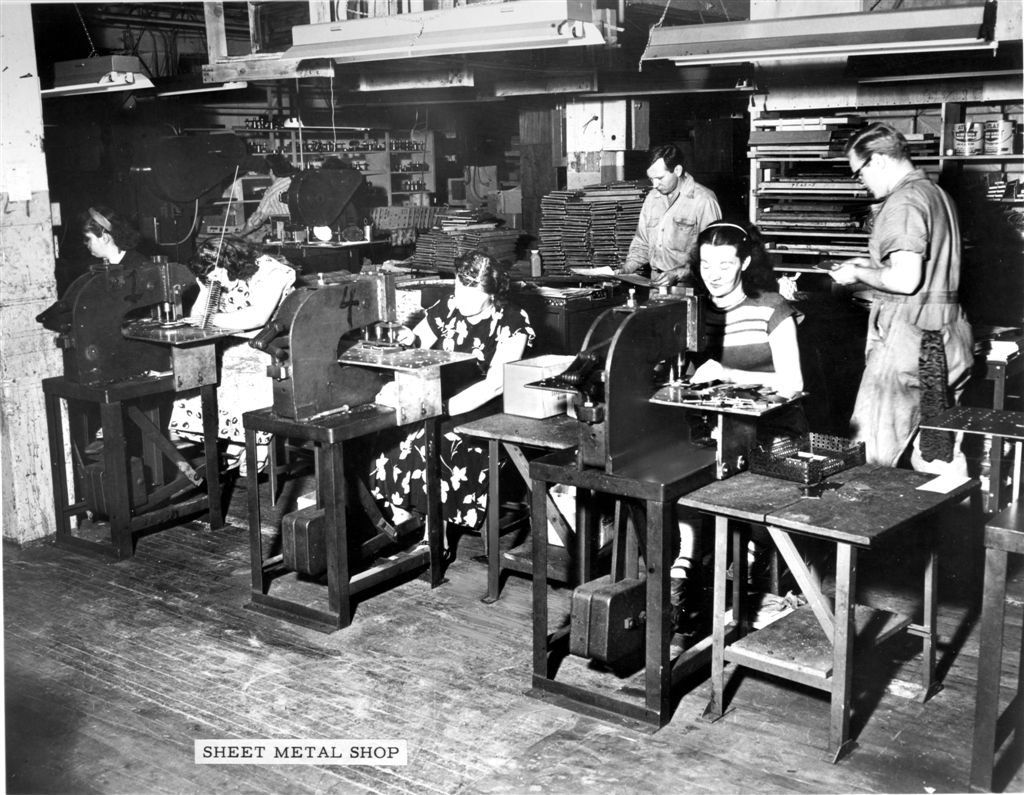

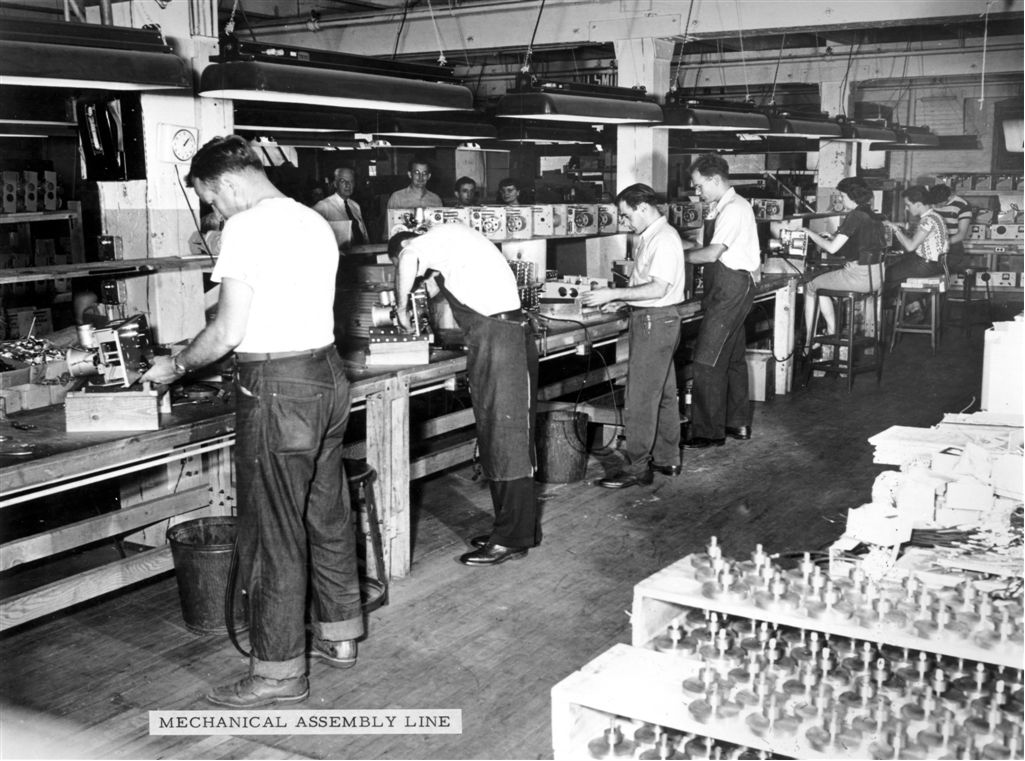
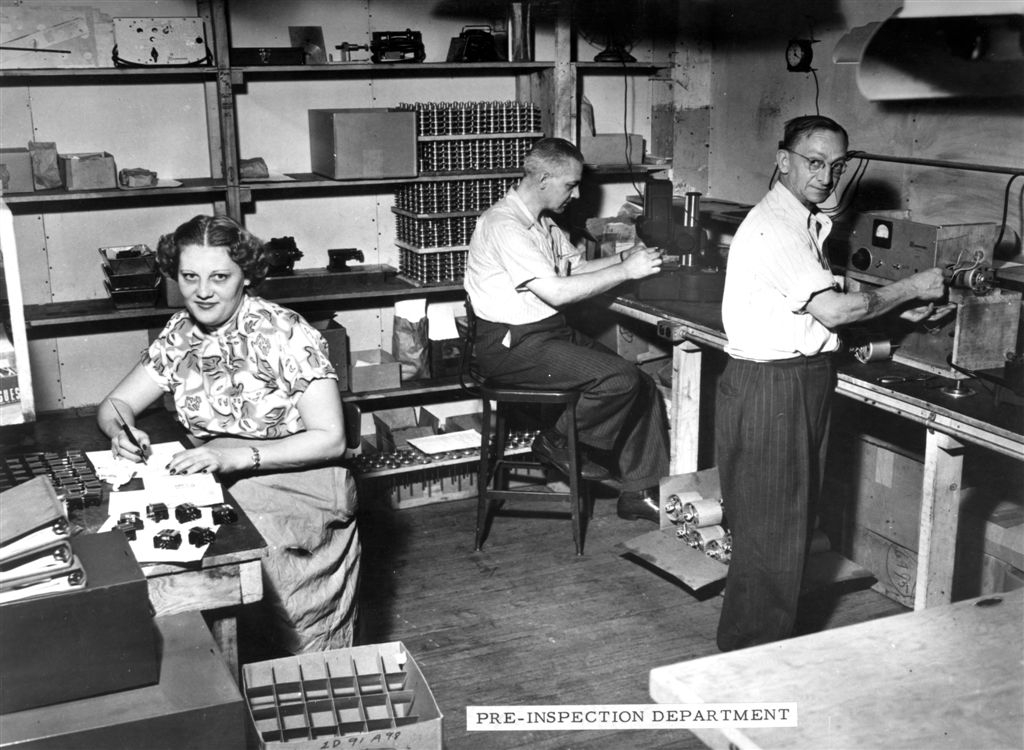
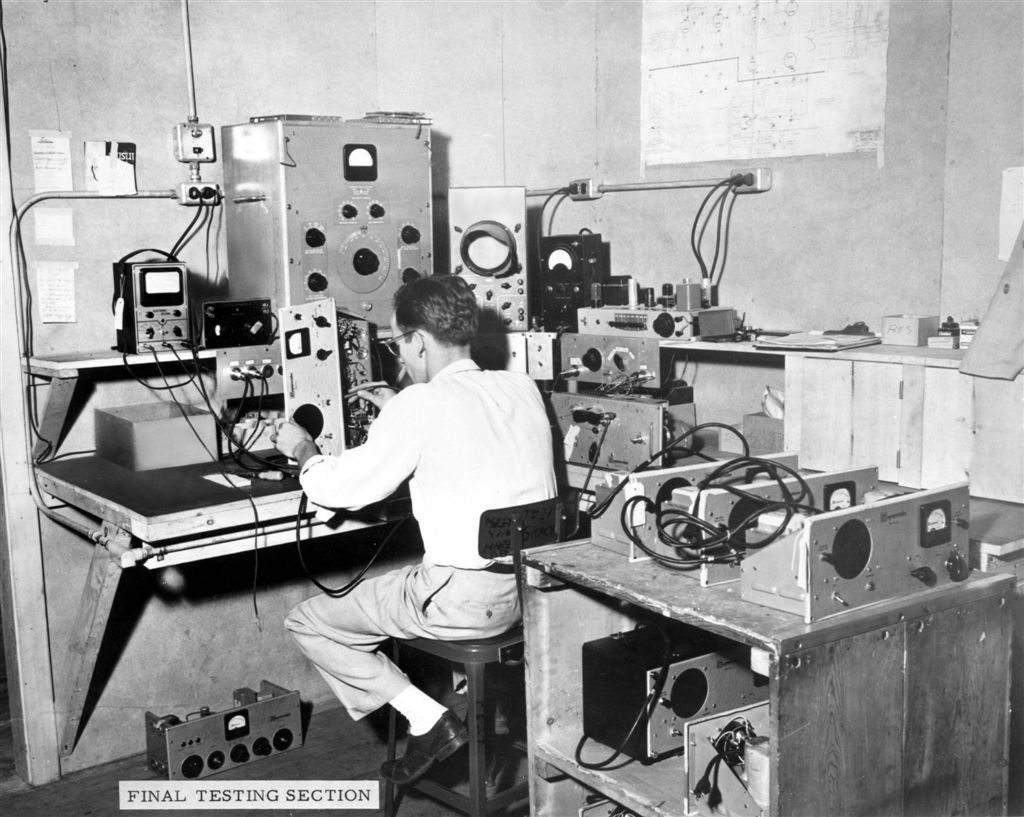


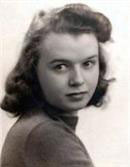 Ruth Werner Finlay -worked for Magnecord
Ruth Werner Finlay -worked for Magnecord
July 28, 2016 Name of sender: Cassie 0'Mara
Hello. I wanted to take a moment to send a deeply heartfelt thanks for the Magnecord website. My mother, Ruth Werner Finlay, worked as the secretary to the President in the late 40's and always spoke about her time at Magnecord so fondly. To find a photo of her today on the website was wonderful but to see the video was overwhelming. She passed away in February after a long and happy life. I can't tell you how much it means to our family to know this footage exists. Thank you so very, very much!
Cassie, I got cc’d by Martin T. on his reply to you.
My Father was John Boyers, one of the founding fathers of Magnecord. I have a large library of Magnecord documentation, and I will search through it to see if there’s anything about your Mom.
Like you, I am amazed that Martin has taken so much time and effort to recognize the work of all the Magnecord people. Before his death, Dad was very pleased to be so warmly remembered on Martin’s web site.
The presidency of Magnecord was sort of “passed around”, as I recall, so who was what when is a bit of a mystery. When my father was president, his secretary was a lady named Barbara Snapp. Perhaps you heard her name mentioned at some point? Everyone called her “Snappy”.
I’ll get back to you as soon as I have a chance to paw through all the old records.
Cheers, Dave
---------------
Dear Martin,
Thank you so much for responding! I've attached the thumbnail photo of my mom from your website. She was, I think, 23 at the time. Growing up, we heard stories of my dad waiting outside the gold doors at 360 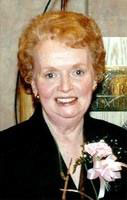 North Michigan Ave., the London Guarantee and Accident Building, for my mom before they were married. She always talked about what a happy time it was. She loved her boss (perhaps Tink Tinkham?) and meeting celebrities of the day. Like you, the first thing that struck me in the film was how much everyone genuinely enjoyed their work and each other!
North Michigan Ave., the London Guarantee and Accident Building, for my mom before they were married. She always talked about what a happy time it was. She loved her boss (perhaps Tink Tinkham?) and meeting celebrities of the day. Like you, the first thing that struck me in the film was how much everyone genuinely enjoyed their work and each other!
I wish I would have discovered the film before she passed away. She would have gotten such a kick out of it! And I would, of course, loved to have heard more about her time at Magnecord. Please give our very best to Dave Boyers and let him know what a wonderful impact he and his father had on my mother's life.
My sister, Karen, is the family archivist and may have more photos from that time. She is as excited as I am and will write to you shortly. (My aunt, Marianne Nord Werner, also worked for Magnecord from 1953-56!)
In case you're interested, here is a link to my mom's obit. While working for Magnecord, she went a blind date with my date and the rest, as they say, is history!
My mom was every bit as sweet and funny as she appears in the video. That moment captured her so beautifully. What an incredible gift you've given us! Thank you again, Martin, so much.
Yours,
Cassie
P.S. My sister posted the link to the MOMSR website on Facebook yesterday along with the video. So many people -- 100 so far -- have commented and have been as amazed as we are!
Martin,
Attached are two pictures from the late 1960’s showing the two-channel version of the PT-6. These were the workhorse voice recorders used by the Army Security Agency, the Naval Security Group, and the USAF Security Service. We were all NSA SIGINT activities.
I repaired these from 1967 until 1974 (Berlin, Germany; Sinop, Turkey; and Shu Linkou, Taiwan). They were very solid performers. The main problems I can remember were the tension on the reels had to be frequently adjusted because our operators would rewind with their fingers, and the pinch roller solenoid often lost its grip. This was solved in 1969 be putting a little graphite in the solenoid every 28 days. The only problems I remember with the amplifiers were an occasional tube going bad.
These records could also be operated with a foot switch.
I enjoyed repairing these and got lots of practice!
Anonymous
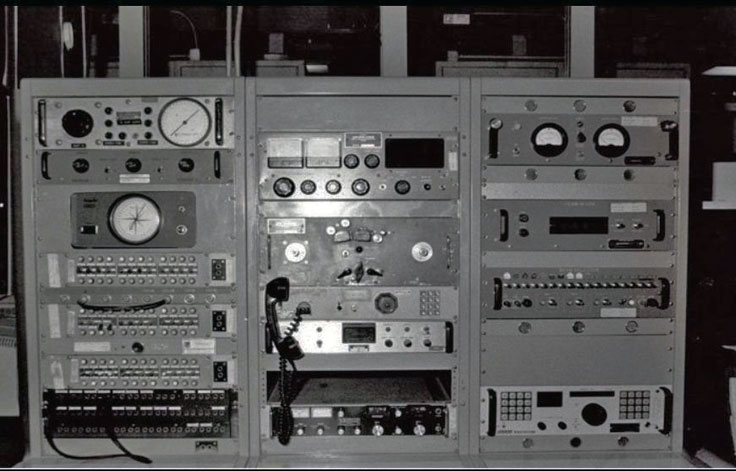
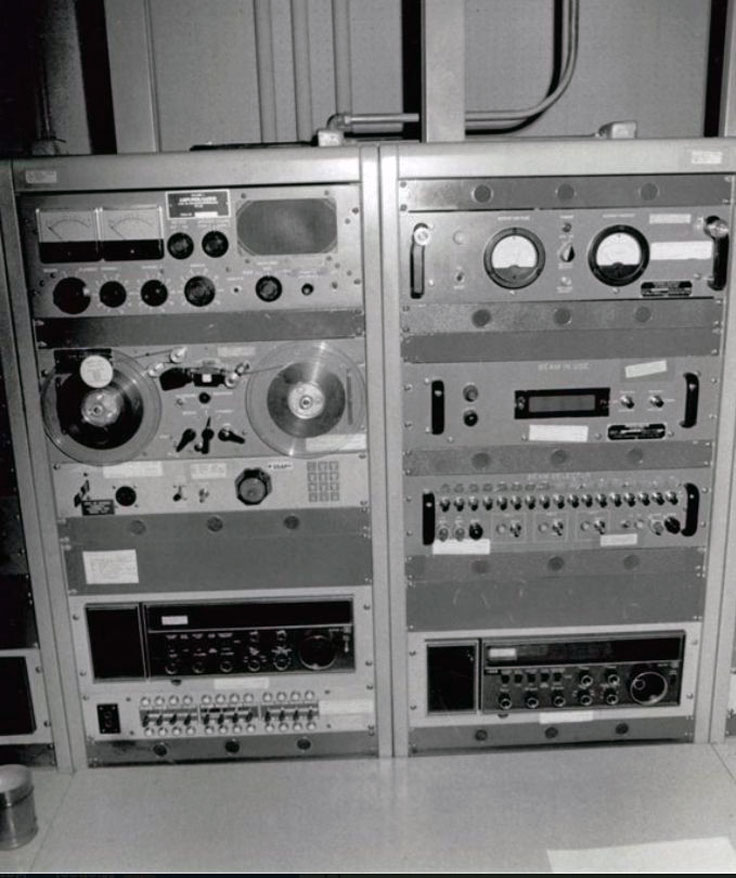
Subject: Magnecord
Date: 11/19/2019 at 10:01 PM (GMT -8) from 47.185.227.200
Name: Mark Hershey
subject: Incorrect date reference
content: A very minor observation: the two side by side pictures of rack mounted Magnecord recorders ( submitted by Anonymous) are incorrectly identified as being from the 1960s. The pictures show a Racal HF communications receiver ( picture on left) and two Collins 651s-1 HF receivers ( right) in the same rack. Both receivers are from the 1970s.
Magnecord tape recorders were also used in early radio broadcast automation and duplication installations (PT63-As and M90 in photo).
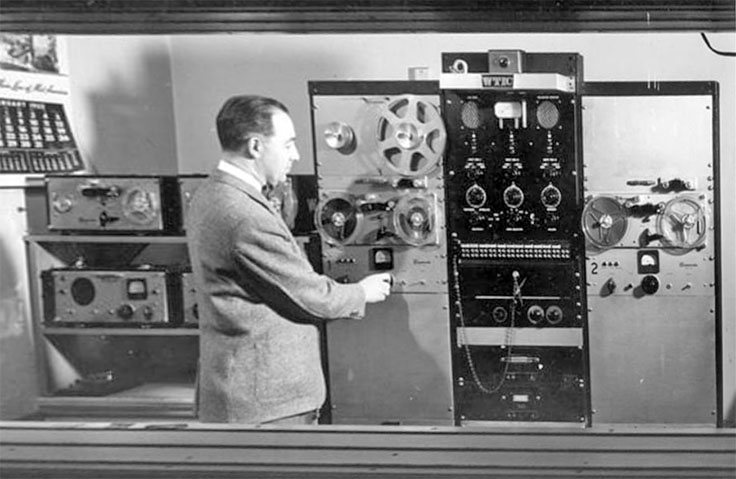
Mark Tipton (FB 090521)
You might find this interesting ….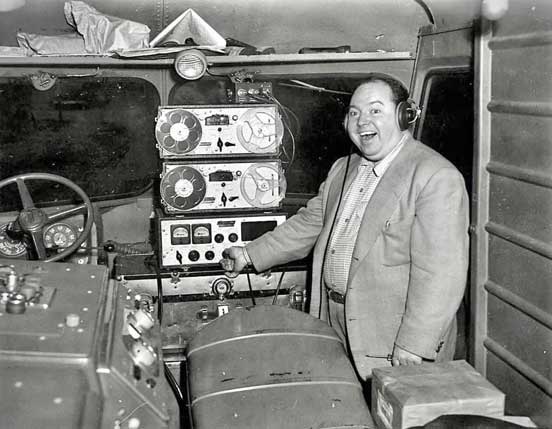
Ever heard true Binaural sound?
“Bert Whyte was an early Magnecorder dealer located on Long Island NY. He was also an early enthusiast for making 2-channel staggered-head binaural recordings. Whyte was a friend of Bob Fine, the engineer responsible for the Mercury Living Presence single-mic mono recordings in the early 1950’s. Fine and David Hall (Mercury’s recording director at the time) let Whyte tag along on several recording trips to Chicago and Minneapolis, where Whyte made experimental 2-mic binaural recordings for his own personal use and to demonstrate the abilities of the Magnecorder. This photo shows White and his binaural rig in the front of Bob Fine’s recording truck. In the foreground at left is a portion of one of the two Fairchild full-track mono recorders used to make the Mercury recordings. Photo date is likely 1952 or 1953.
Bert Whyte went on to write an influential record-review column for Radio & TV News, later Electronics magazine. He was also a founder of Everest Records, where he oversaw engineering and recording of the well-regarded Everest classical records. After Everest went out of business, Whyte returned to journalism, writing for Audio Magazine from the 1960’s until Audio ceased publication. Whyte also continued to engineer and produce records over the years. Probably his best-known later recordings were the direct-to-disc records made for Crystal Clear Records in the late 70’s. At the Crystal Clear D2D recording of Virgil Fox, a parallel recording was made using the prototype Soundstream digital recorder. Those recordings were later released on CD, titled “The Digital Fox.” Whyte was an early enthusiast of digital recording, praising the Sony PCM-F1 recorder in the pages of Audio Magazine. He ran PCM-F1 backups of his direct-to-disc recordings in London, also for Crystal Clear Records.”
Photos of Bob Fine's recording truck from Preservation Sound
Hi Martin!
Martin, you have my permission to use those photos on your website. Please include a link to the factual history at Chris's website so they are in proper context. So much BS and mythology out on the web and social media!
Regarding the photos of my father's truck, those are early days, when there were two Fairchild full-track recorders in it. I don't have much of any info on the Fairchild machines but I do have an old head-block. They had an isolated loop around the heads, somewhat akin to a Davis loop. Fairchild developed their machines independent of Ampex/Mullin and without a Magnetophone as their guide. I think they used as a model the early magnetic-film recorders from RCA and Western Electric.
-- Tom Fine
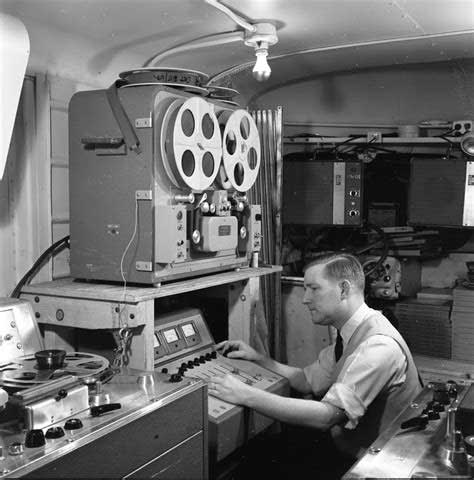


Wade Rice Jr
Whyte made a binaural/stereo recording alongside one of the Smetana tone poems recorded by Kubelik/CSO in the Mercury cycle. That binaural/stereo recording appears on a Music and Arts CD along with a Stokowski Tchaikovsky Fifth Symphony recording made with the Detroit SO in 1952.
Magnecord ads in our collection
1948

|
1949

|
1949

|
1949

|
1949

|
1949

|
1949

|
1949
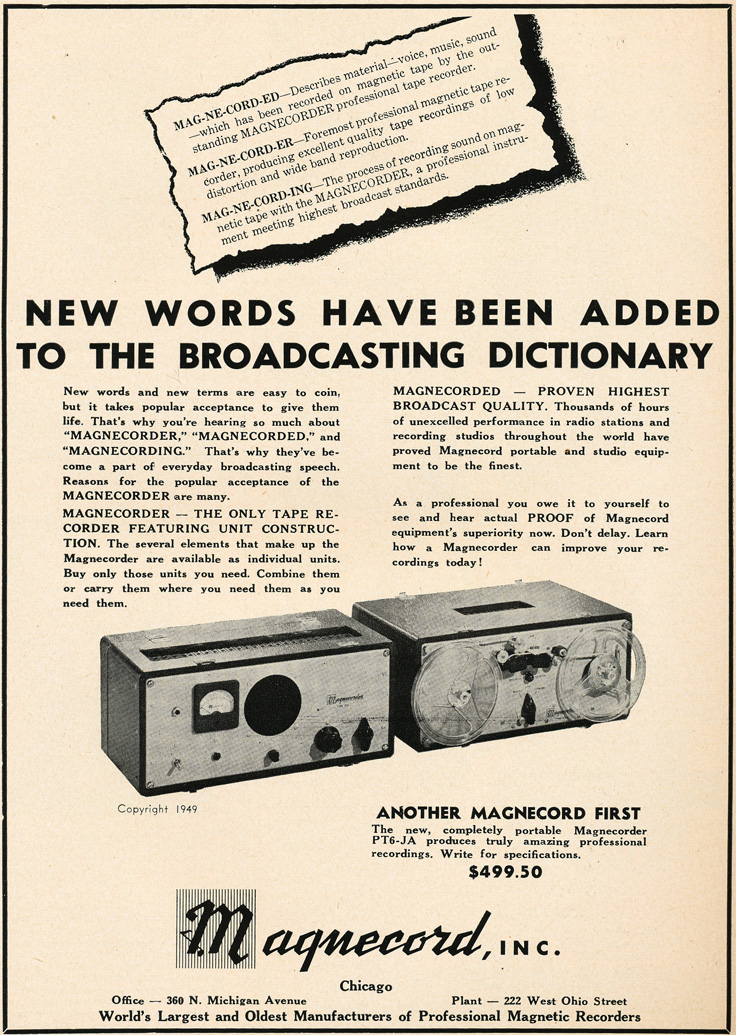
|
1949

|
1949
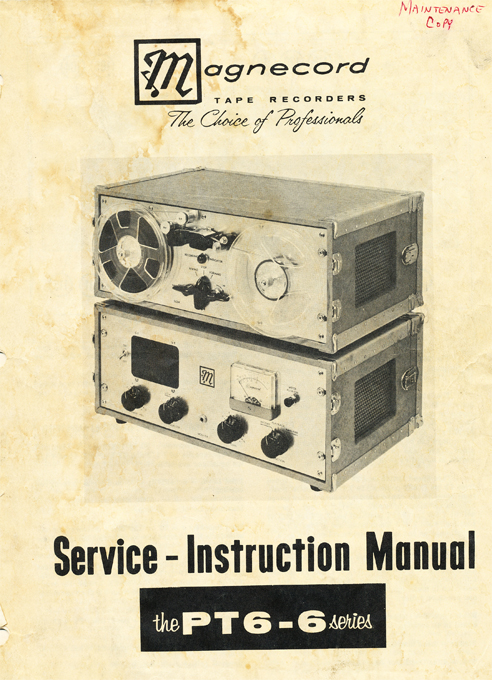
|
1949

|
1949
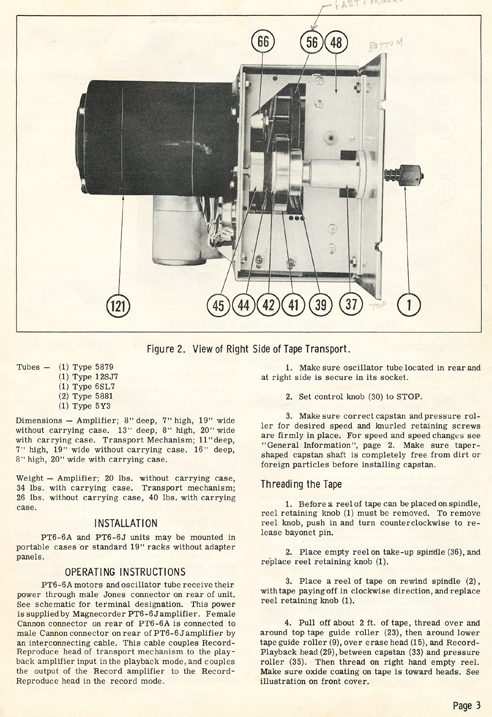
|
1949

|
1950

|
1950

|
1950
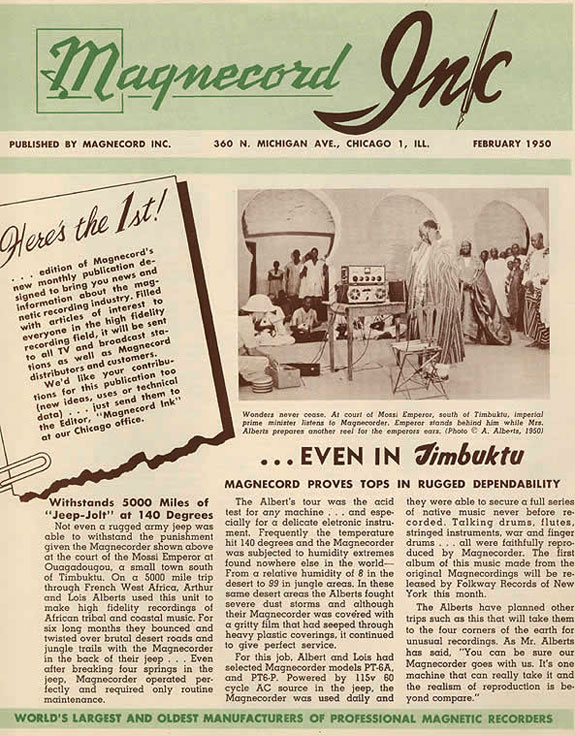
|
1950

|
1950
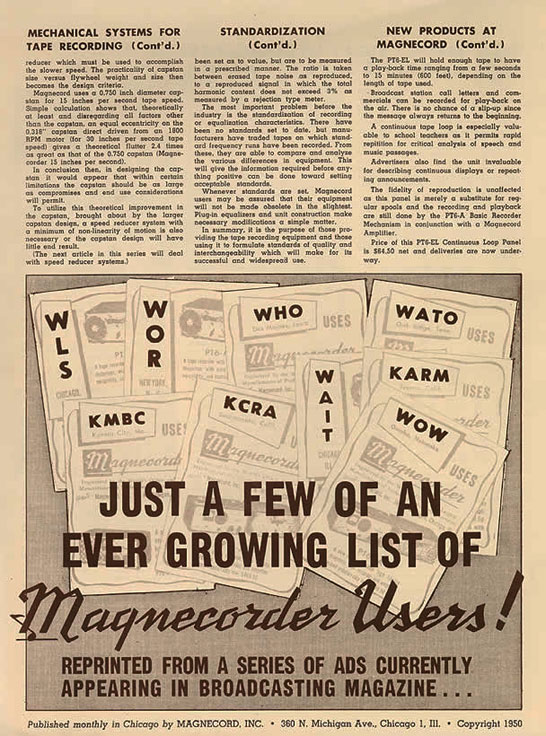
|
1950
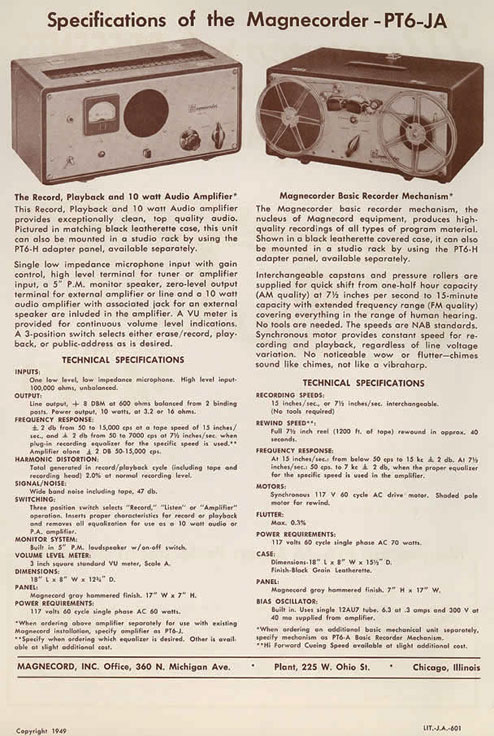
|
1950
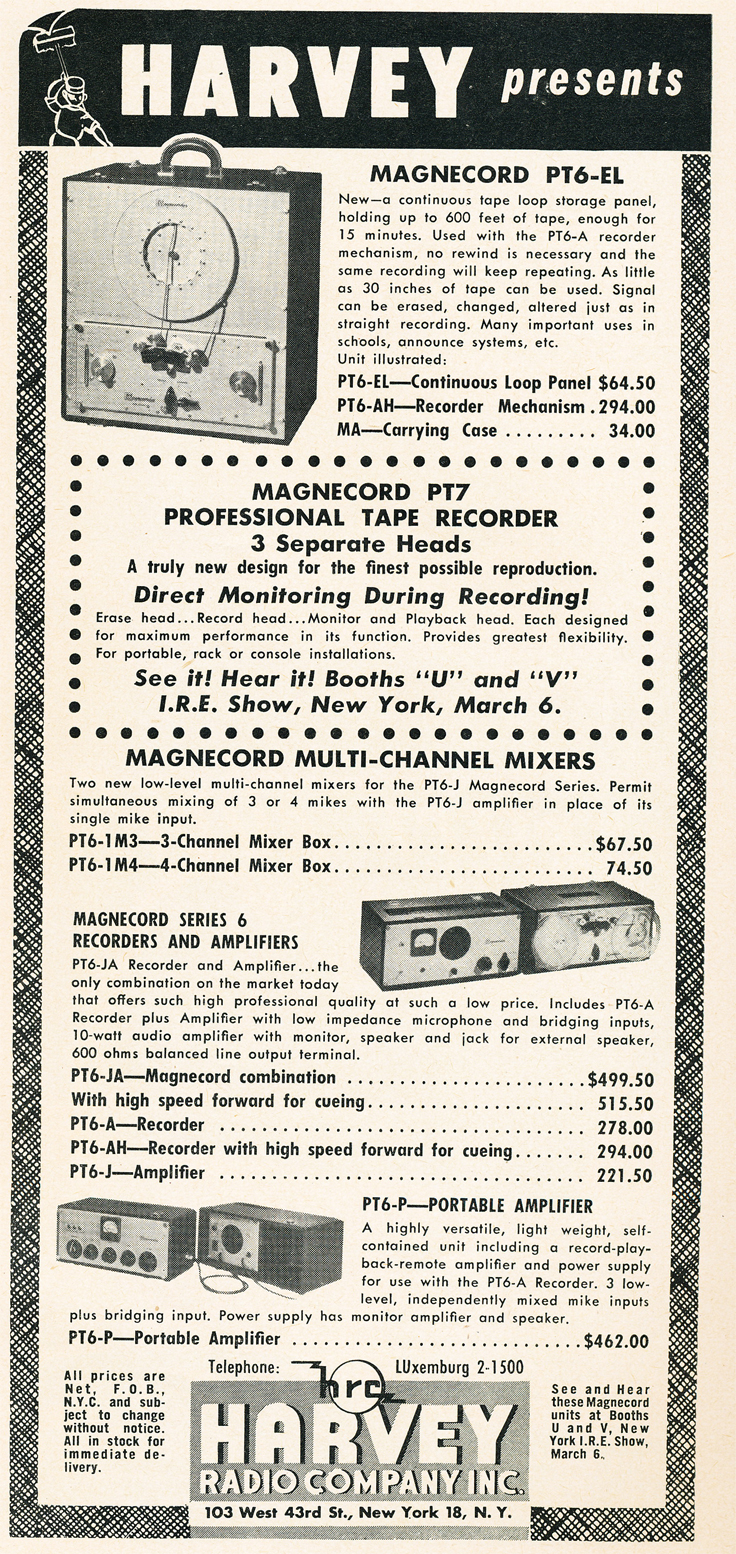
|
1950
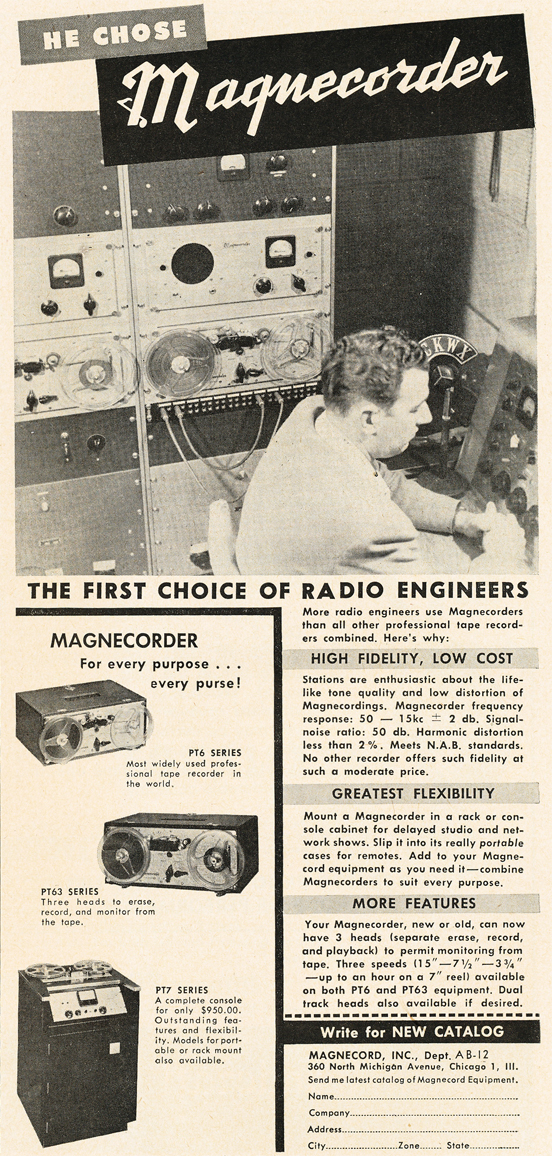
|
1950
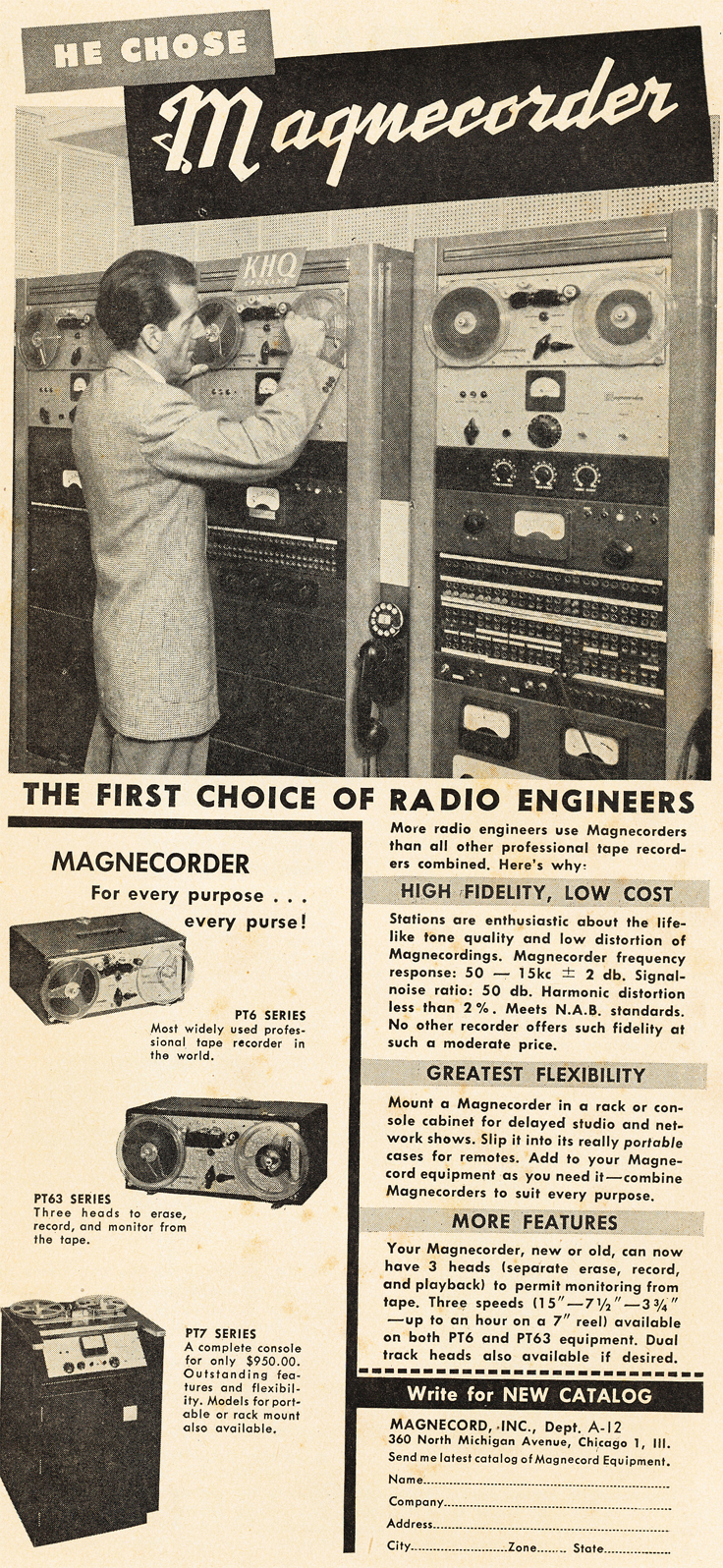
|
1950
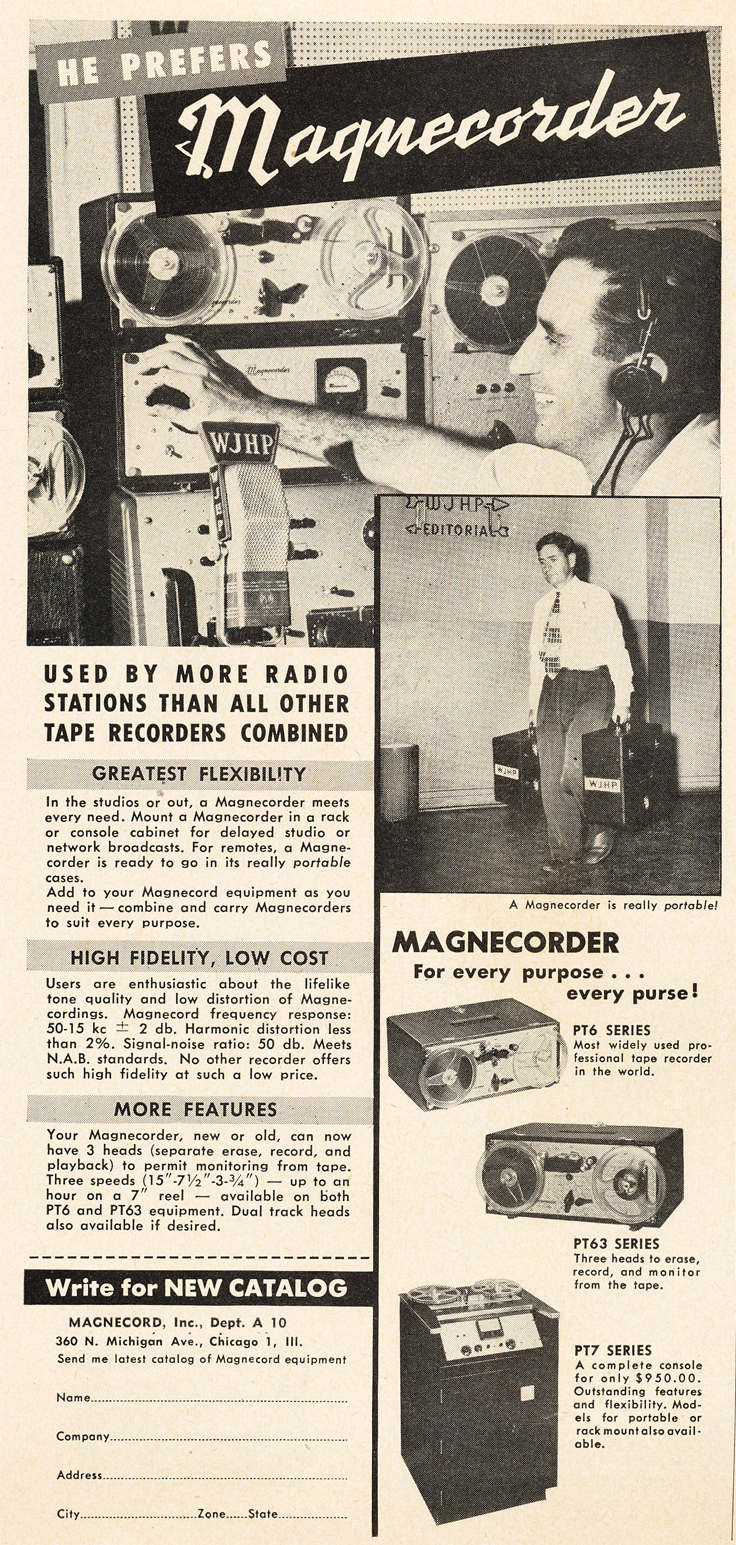
|
1950
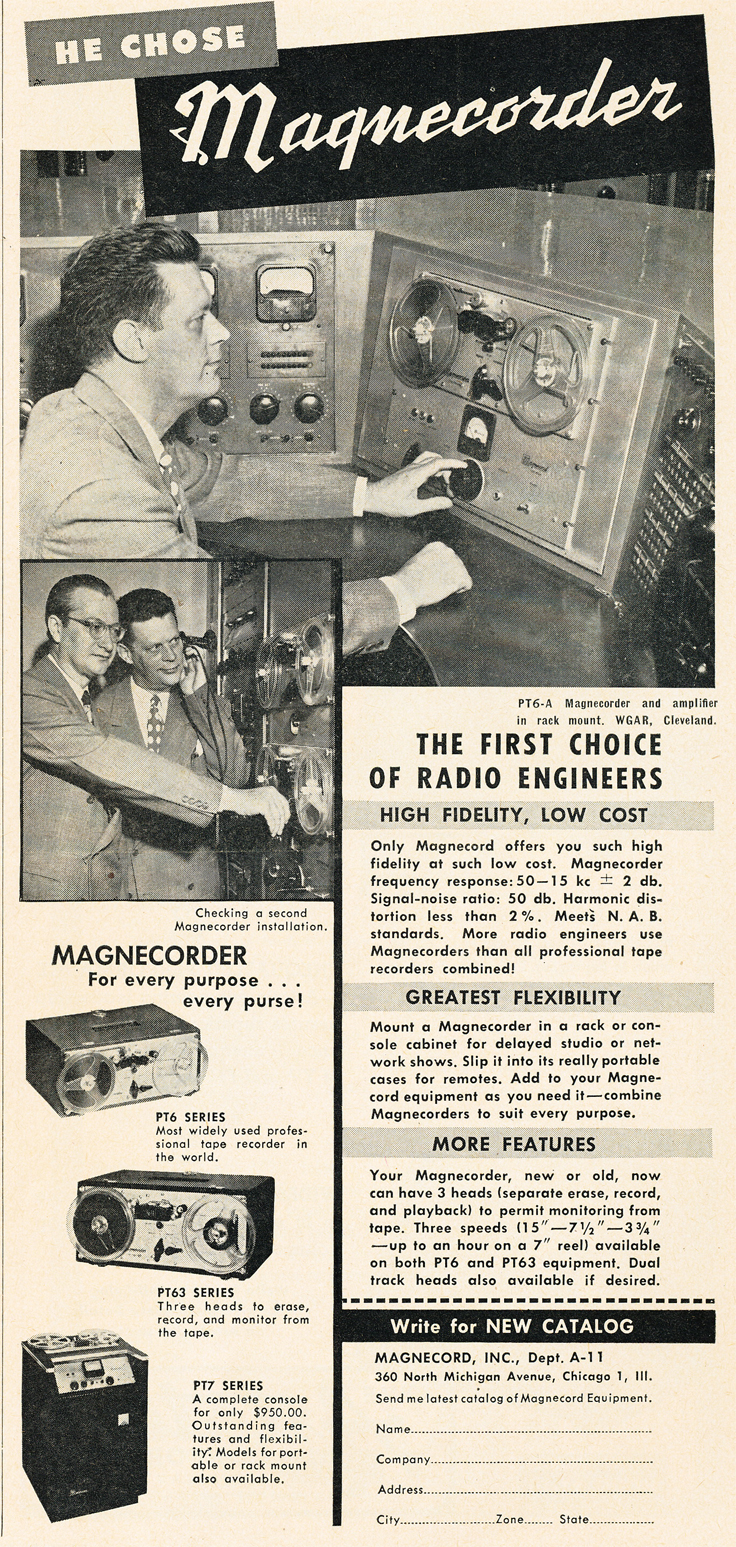
|
1950

|
1950

|
1950

|
1950
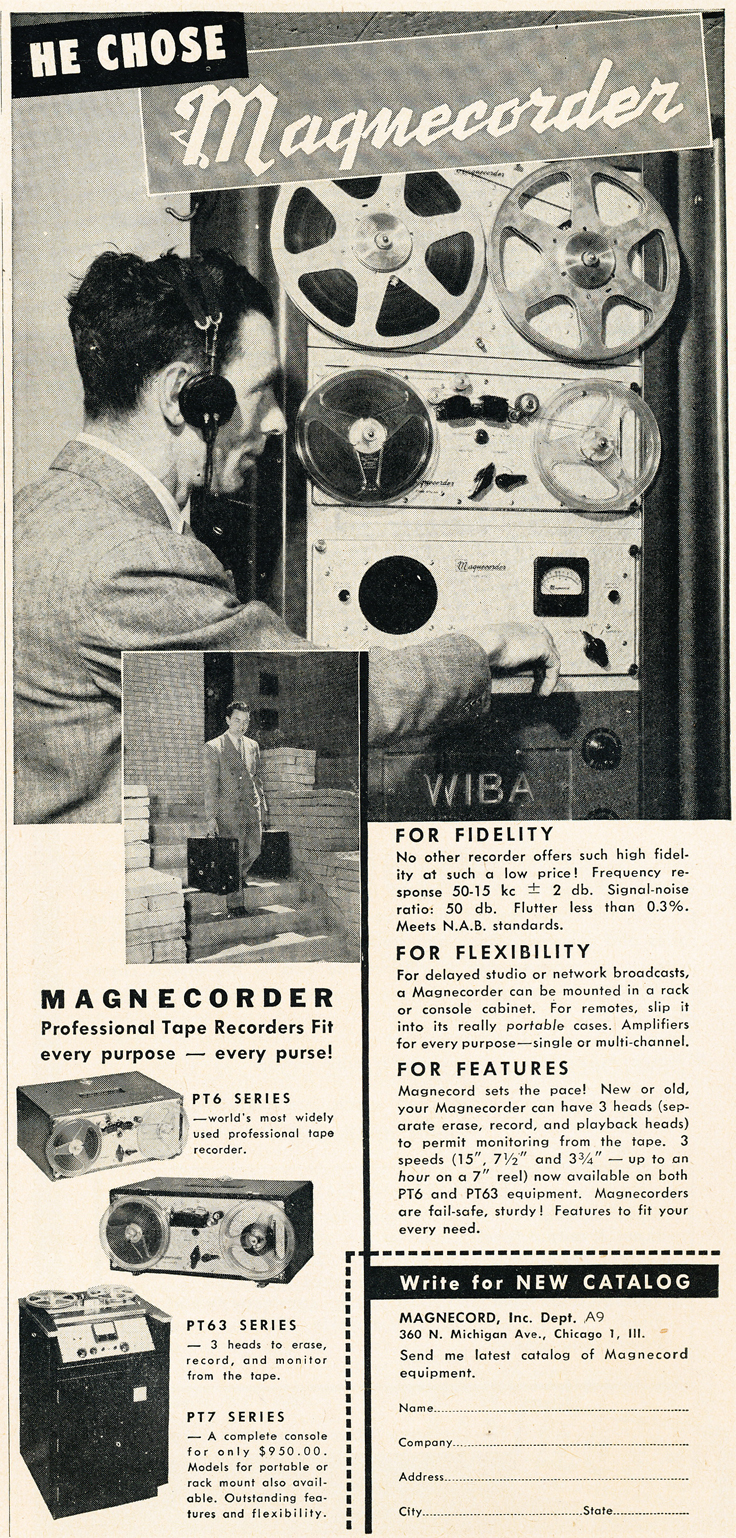
|
1950
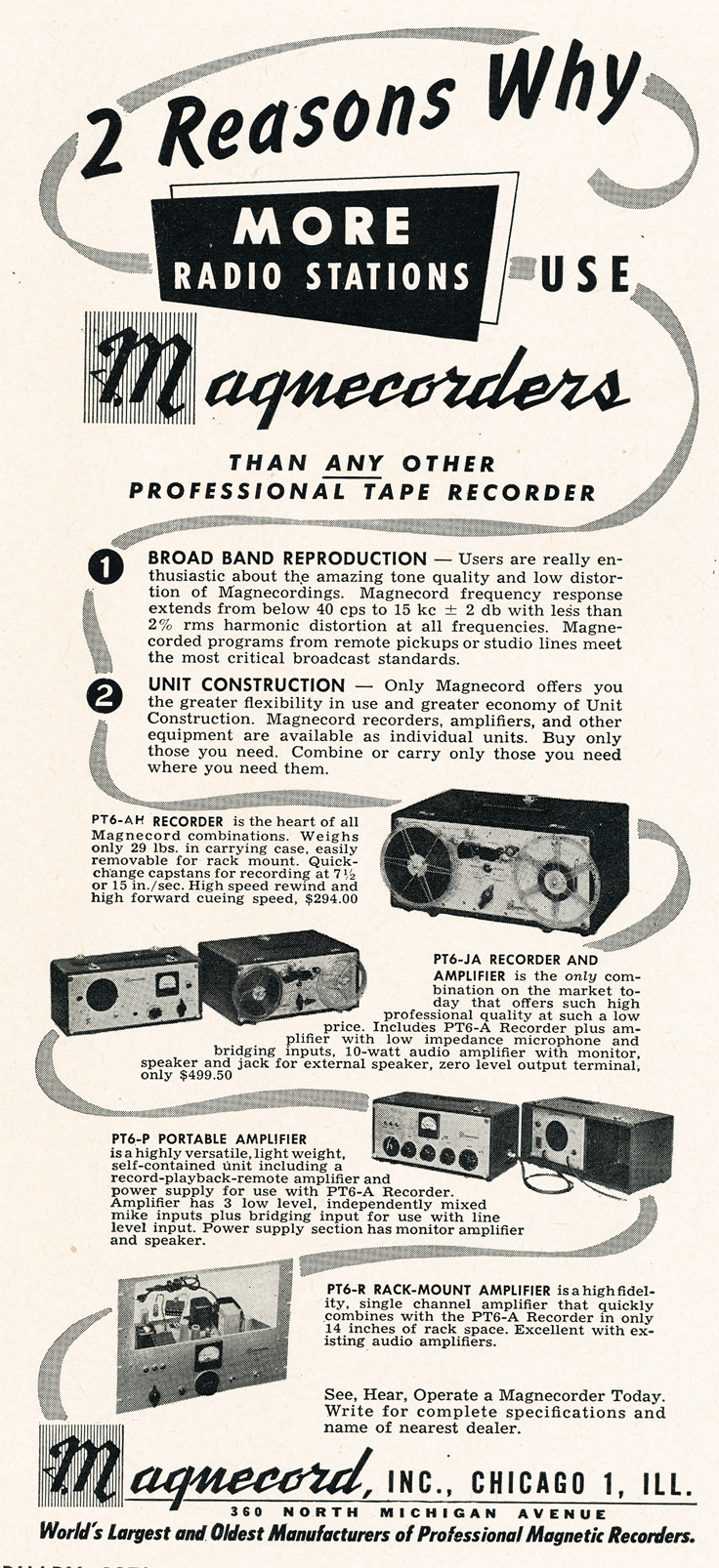 
|
1950

|
1950
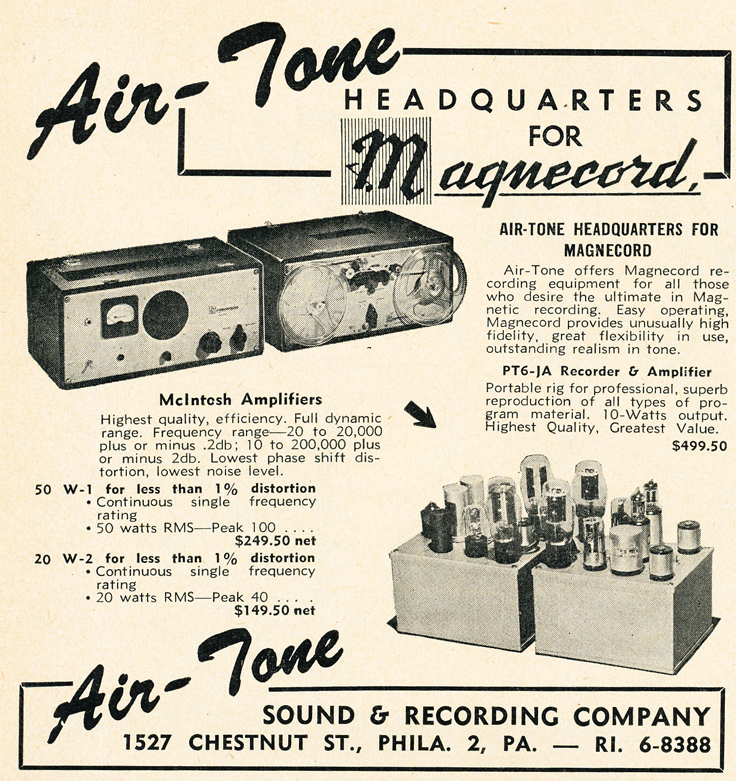
|
1950
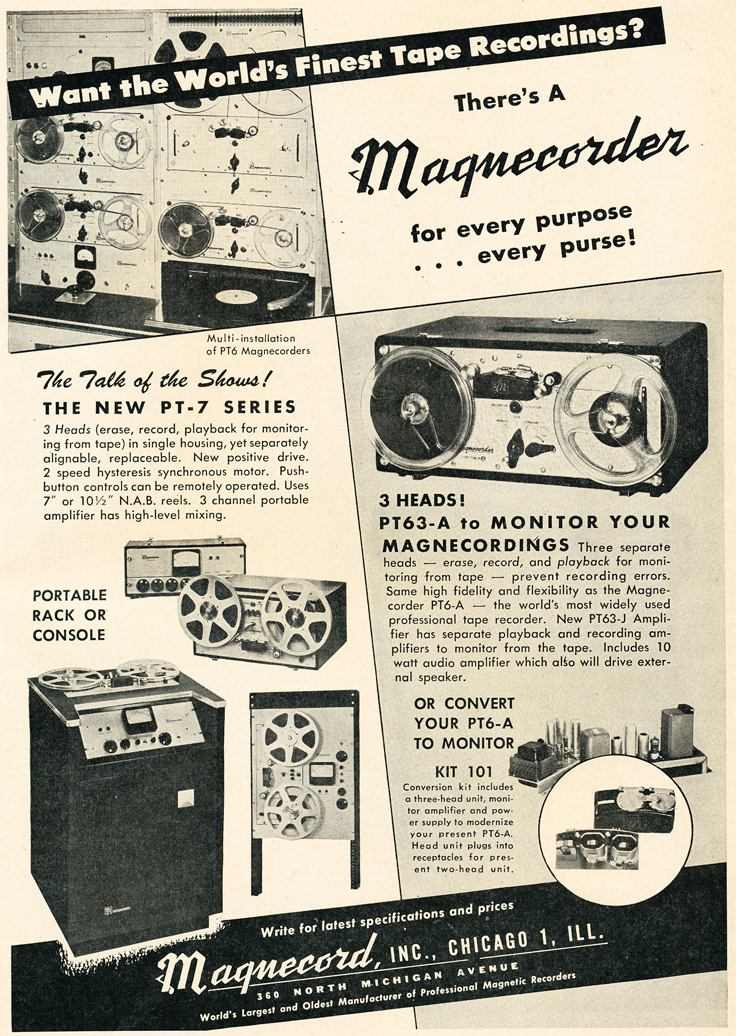
|
1950
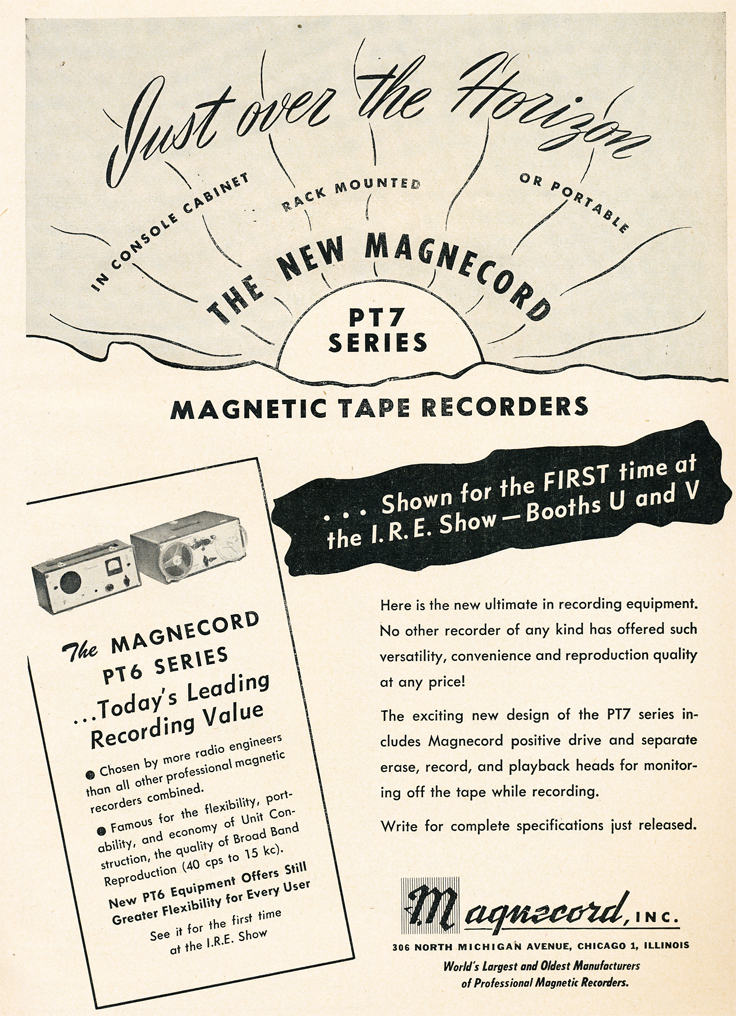
|
1950

|
1950
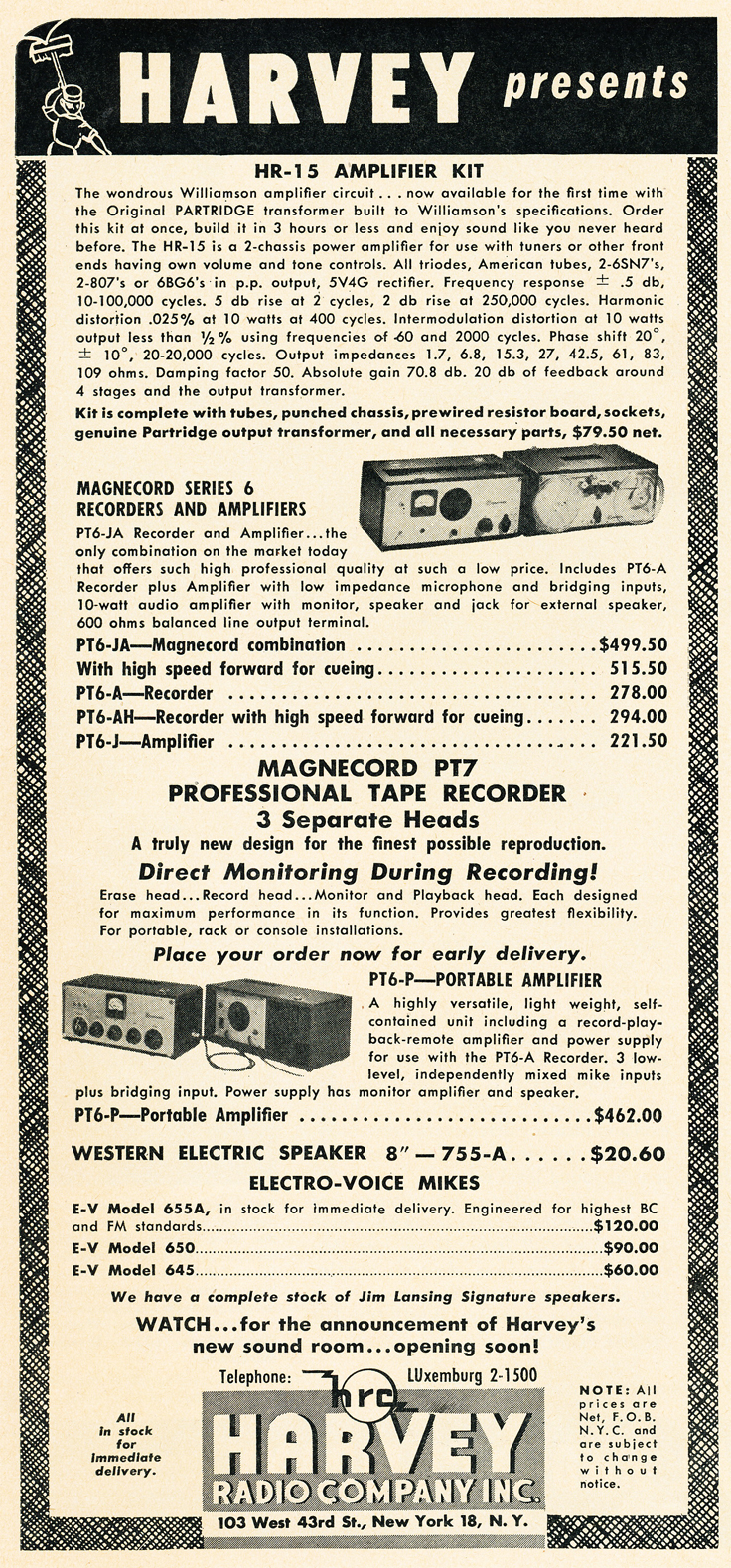
|
1951
 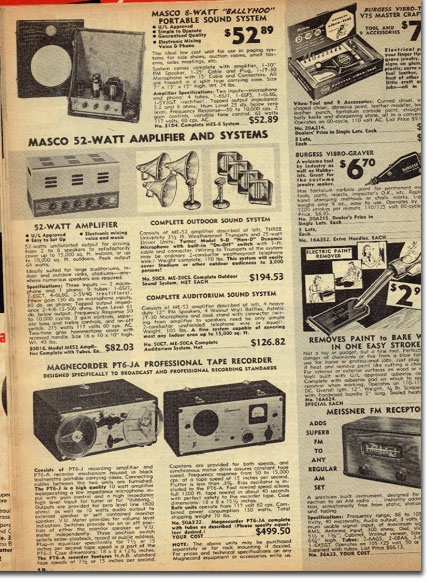
|
1951

|
1951
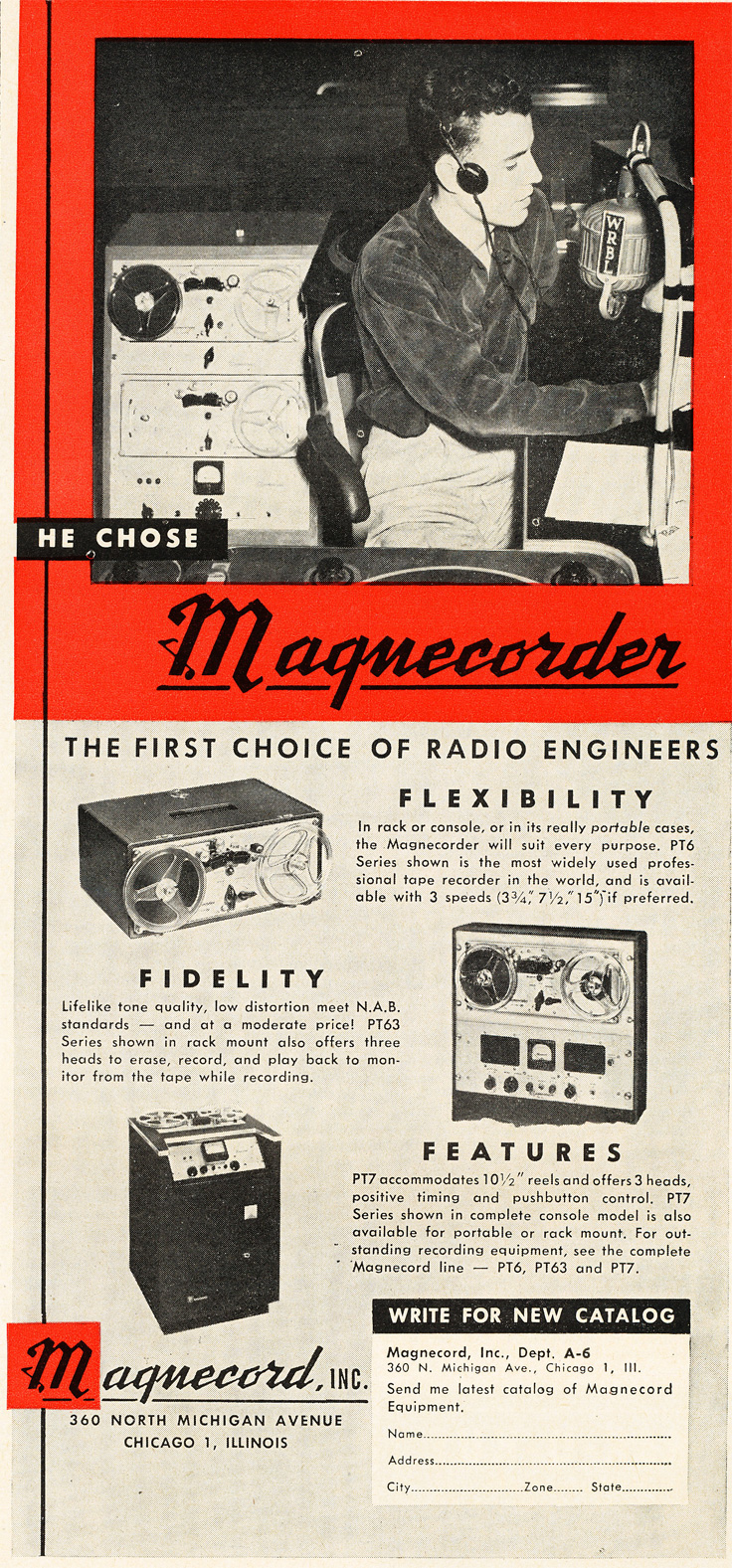
|
1951
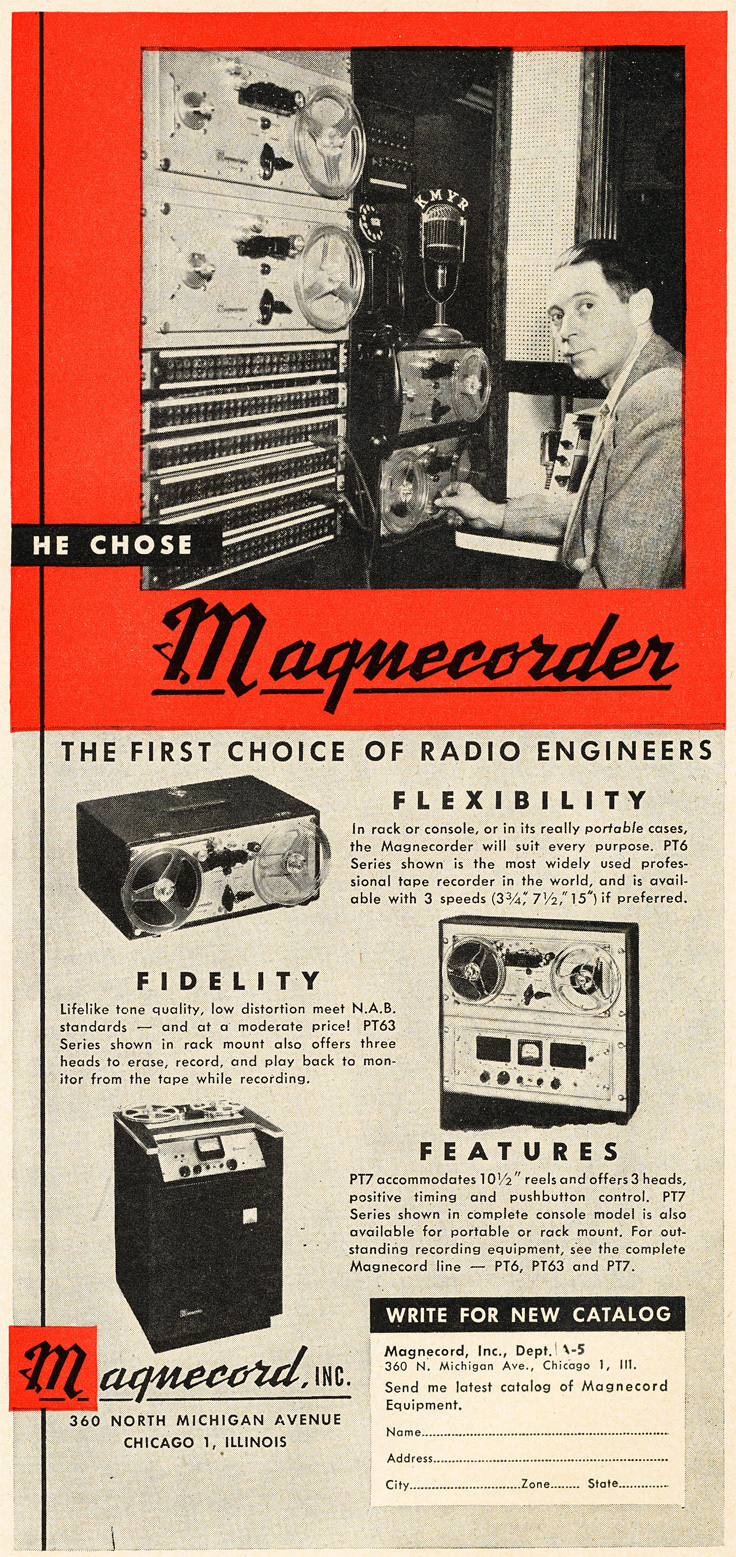
|
1951
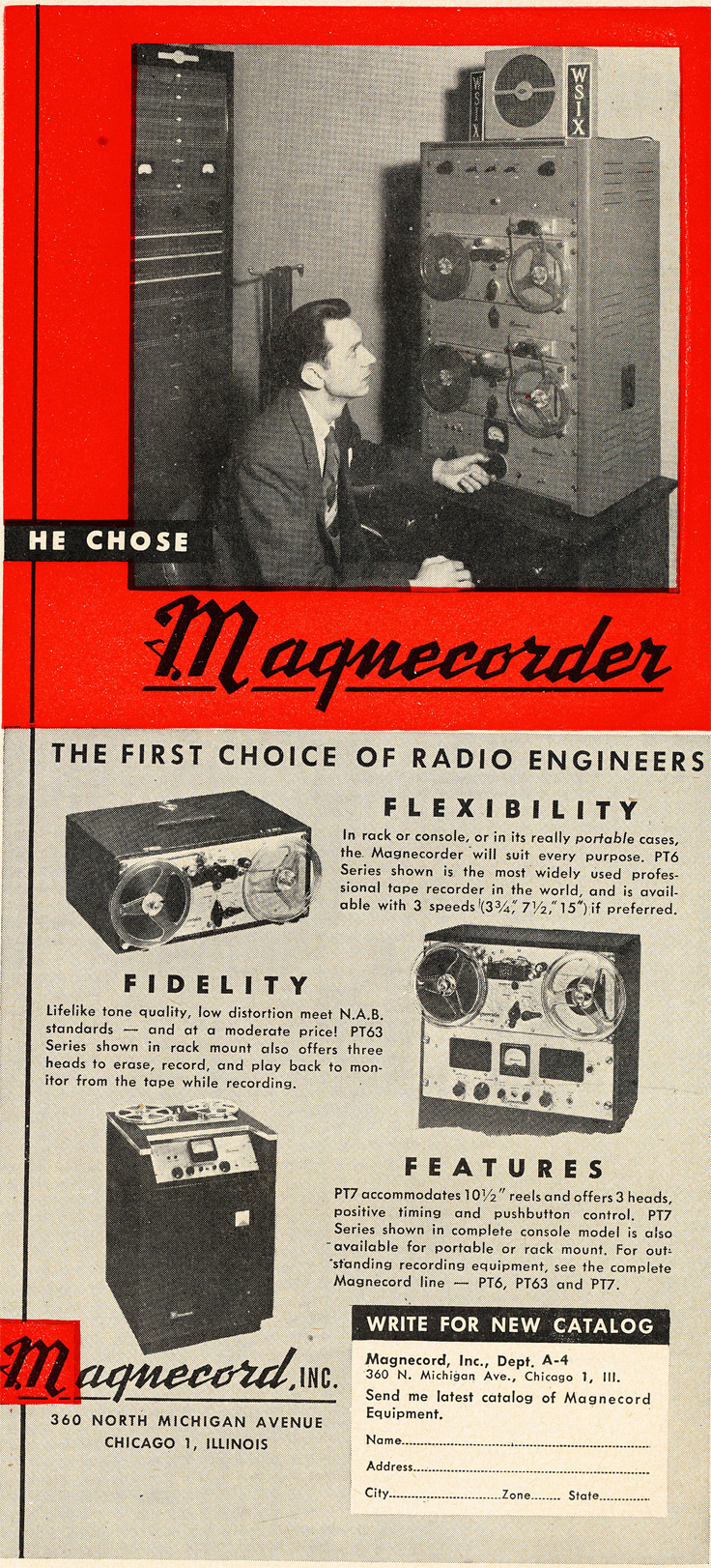
|
1951

|
1951
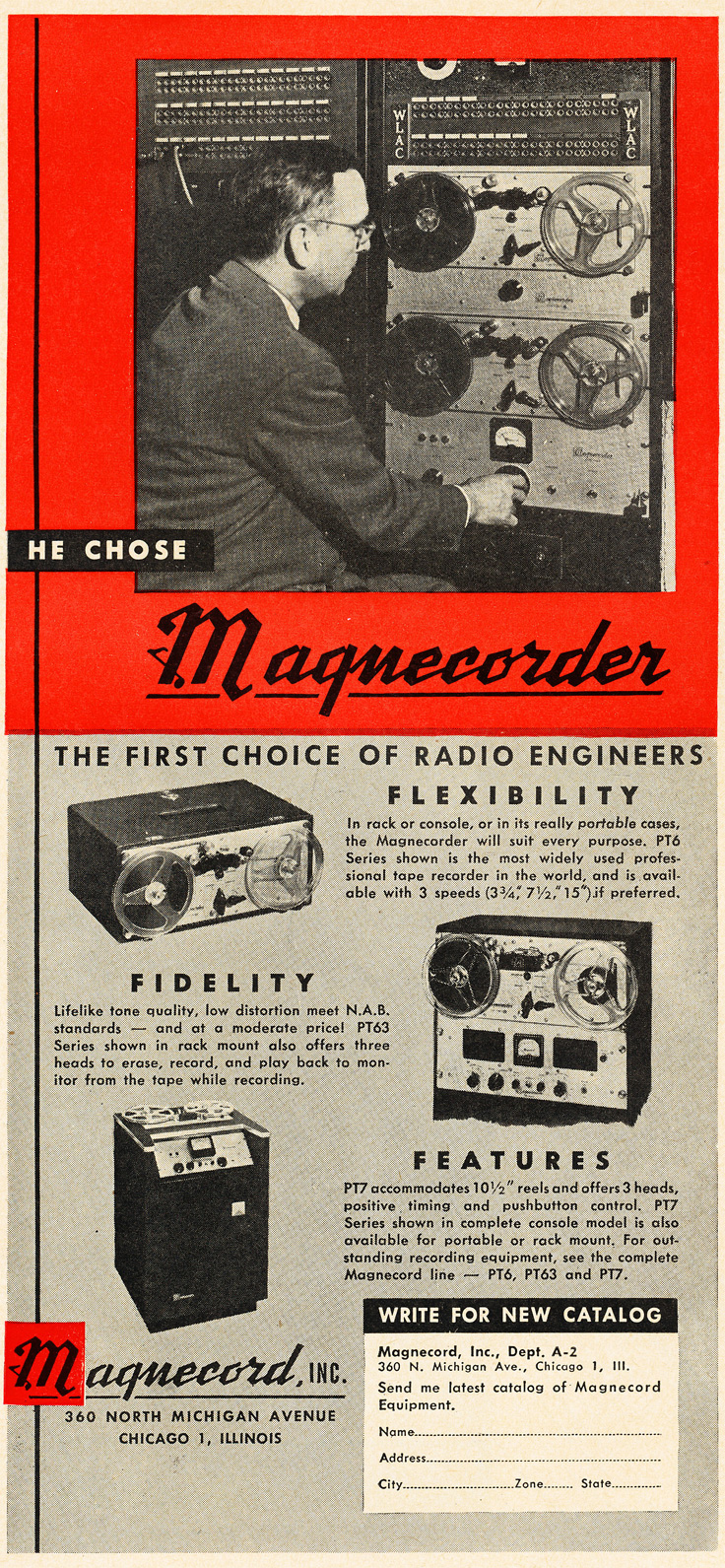
|
1951
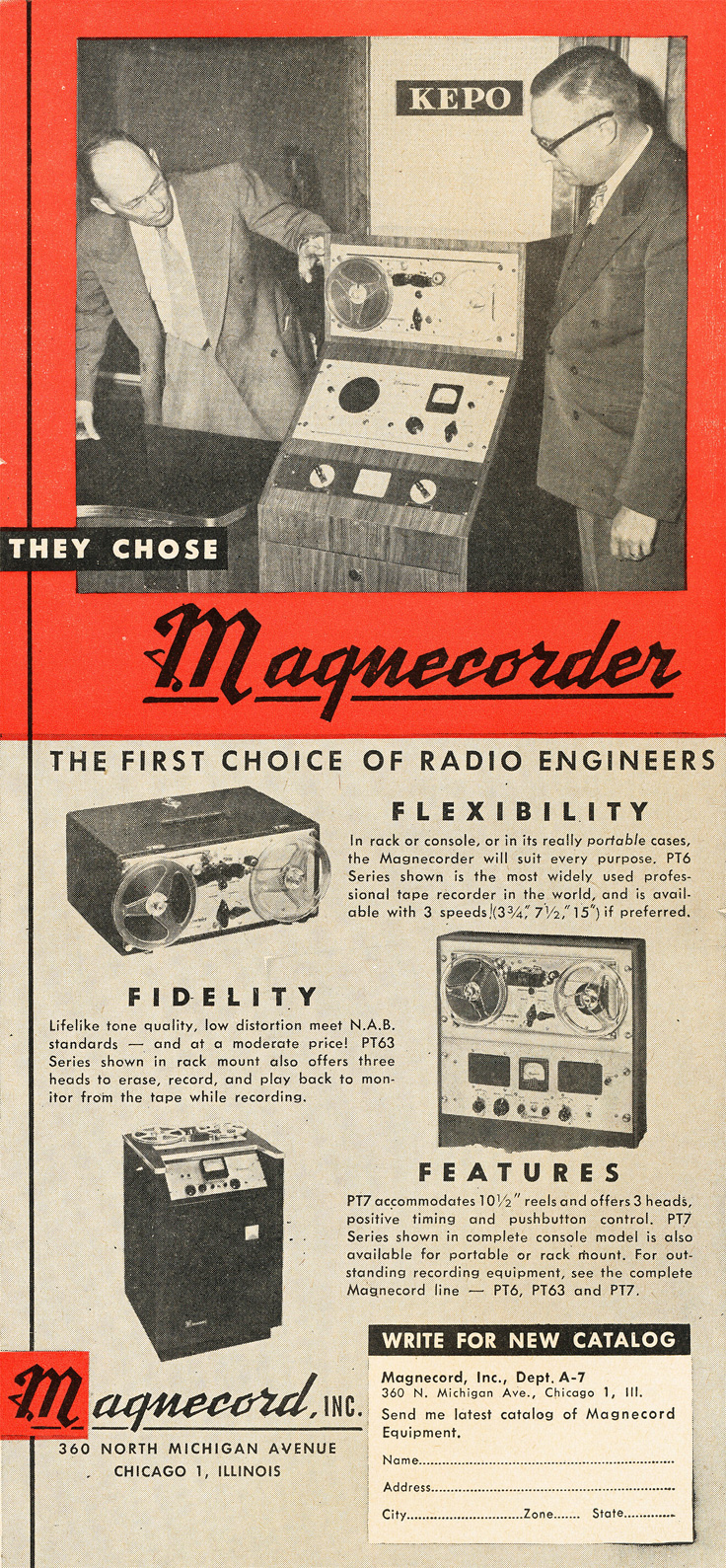
|
1951

|
1951
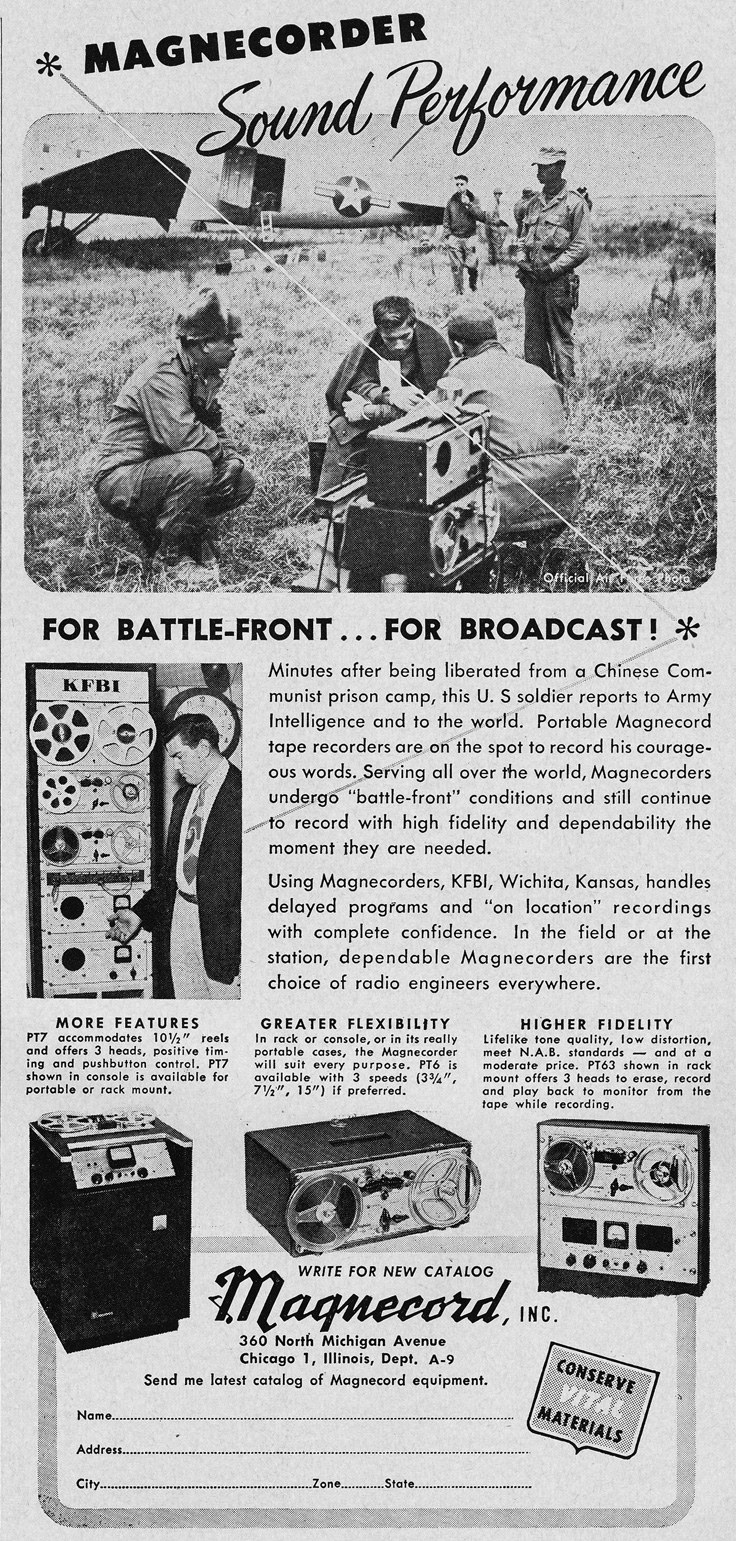
|
1951
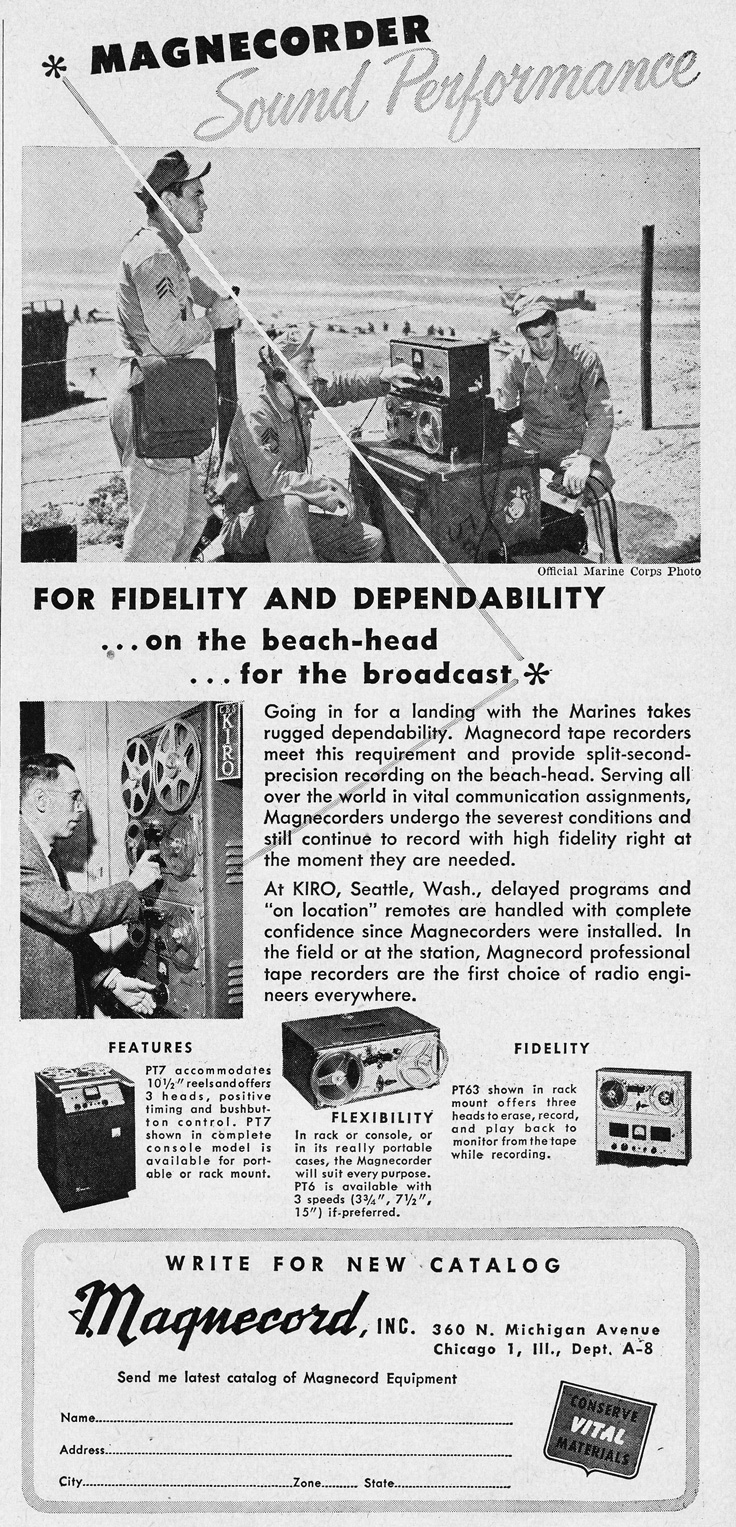
|
1952

|
1952

|
1952

|
1952
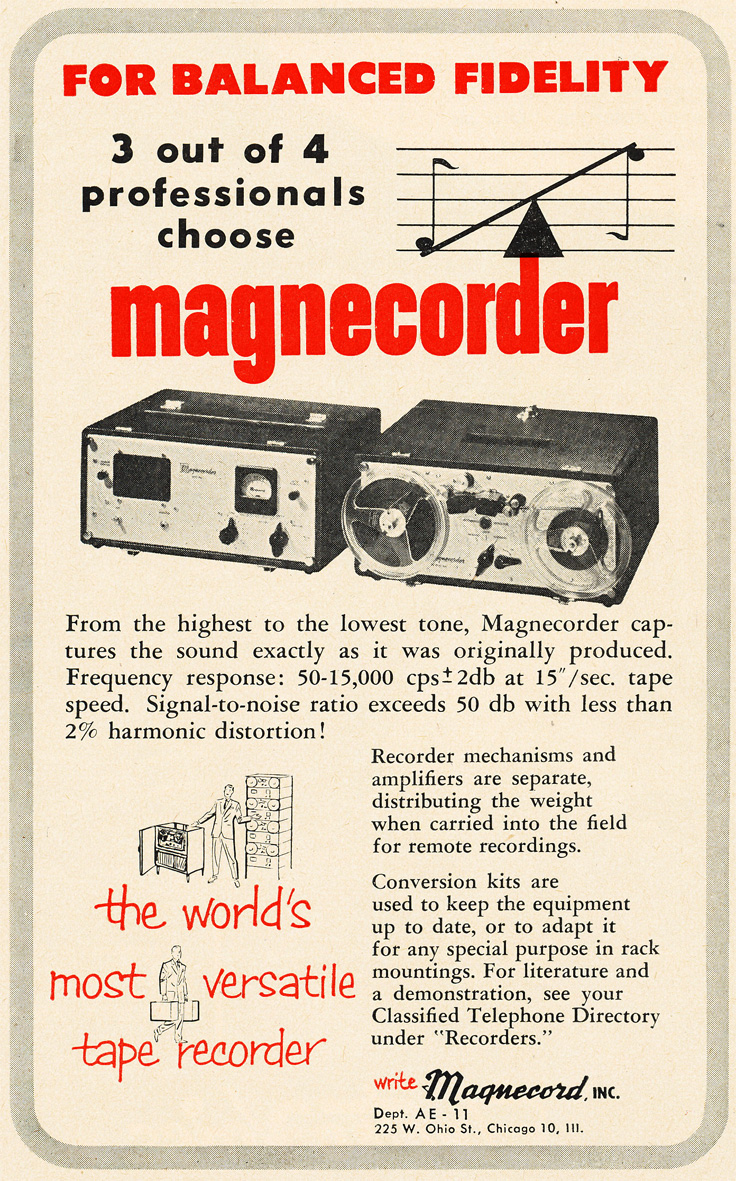
|
1952
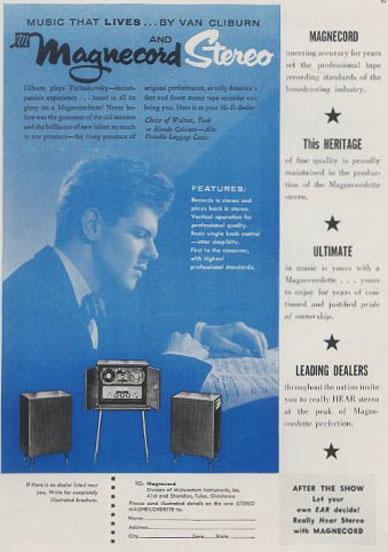
|
1952
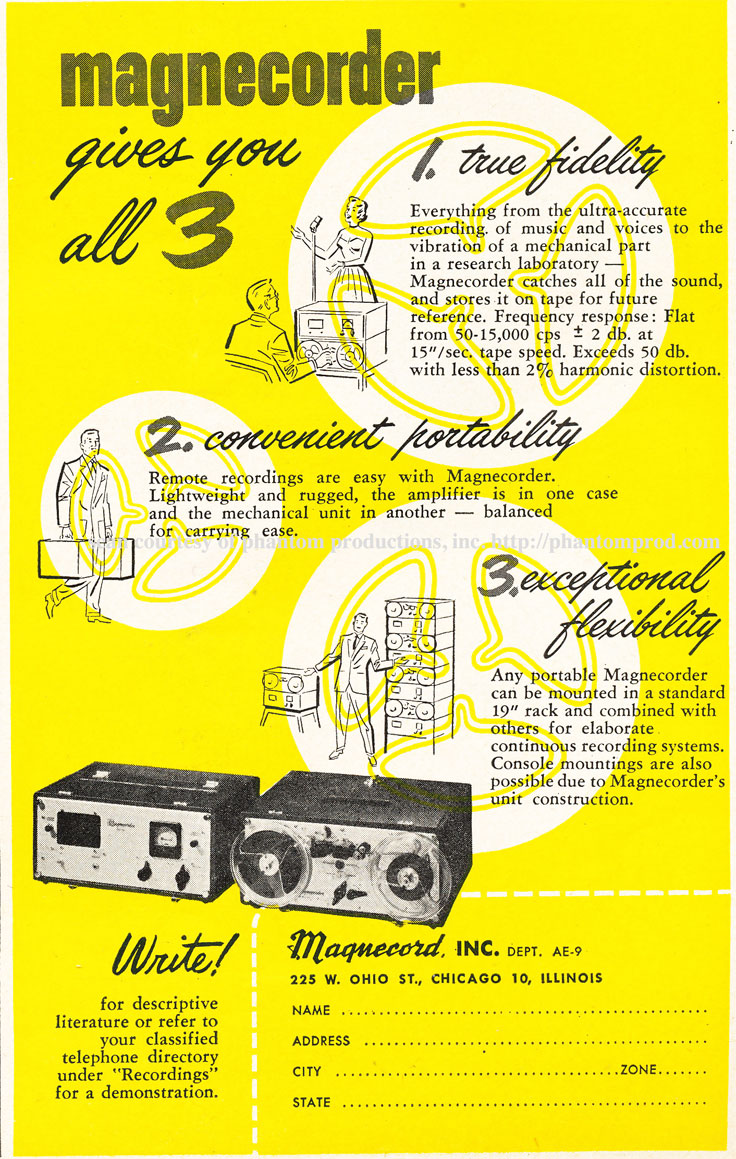
|
1952

|
1952
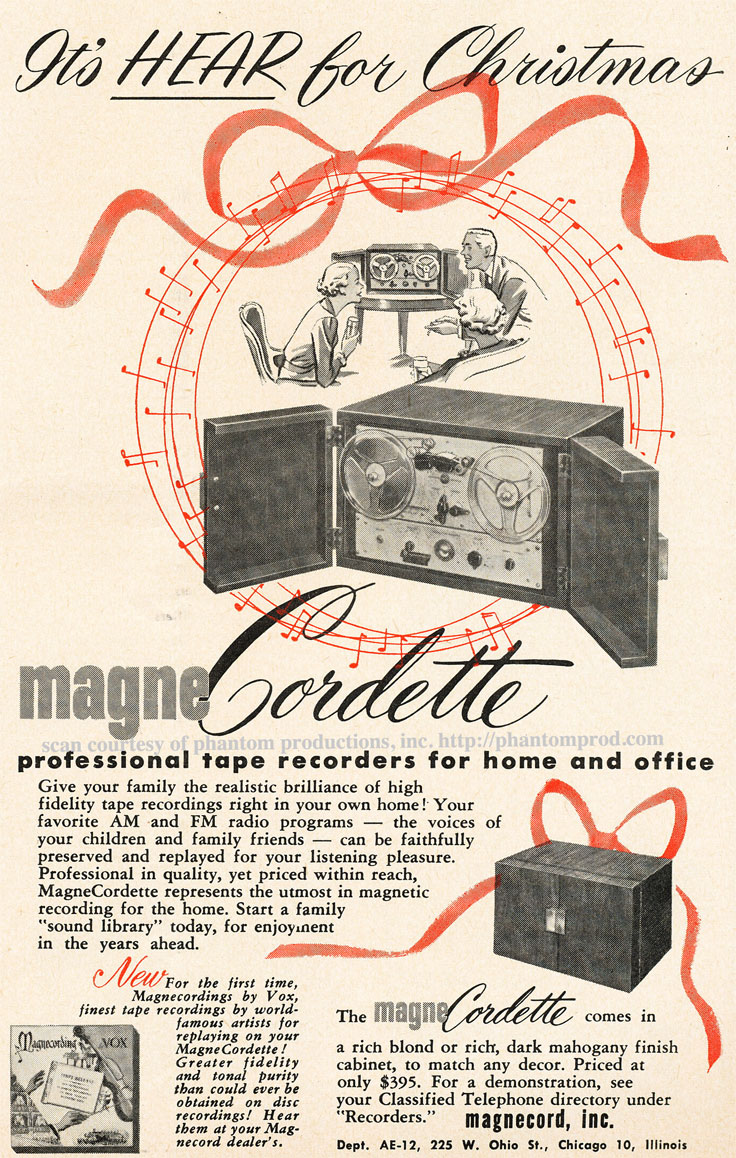
|
1952
 
|
1952
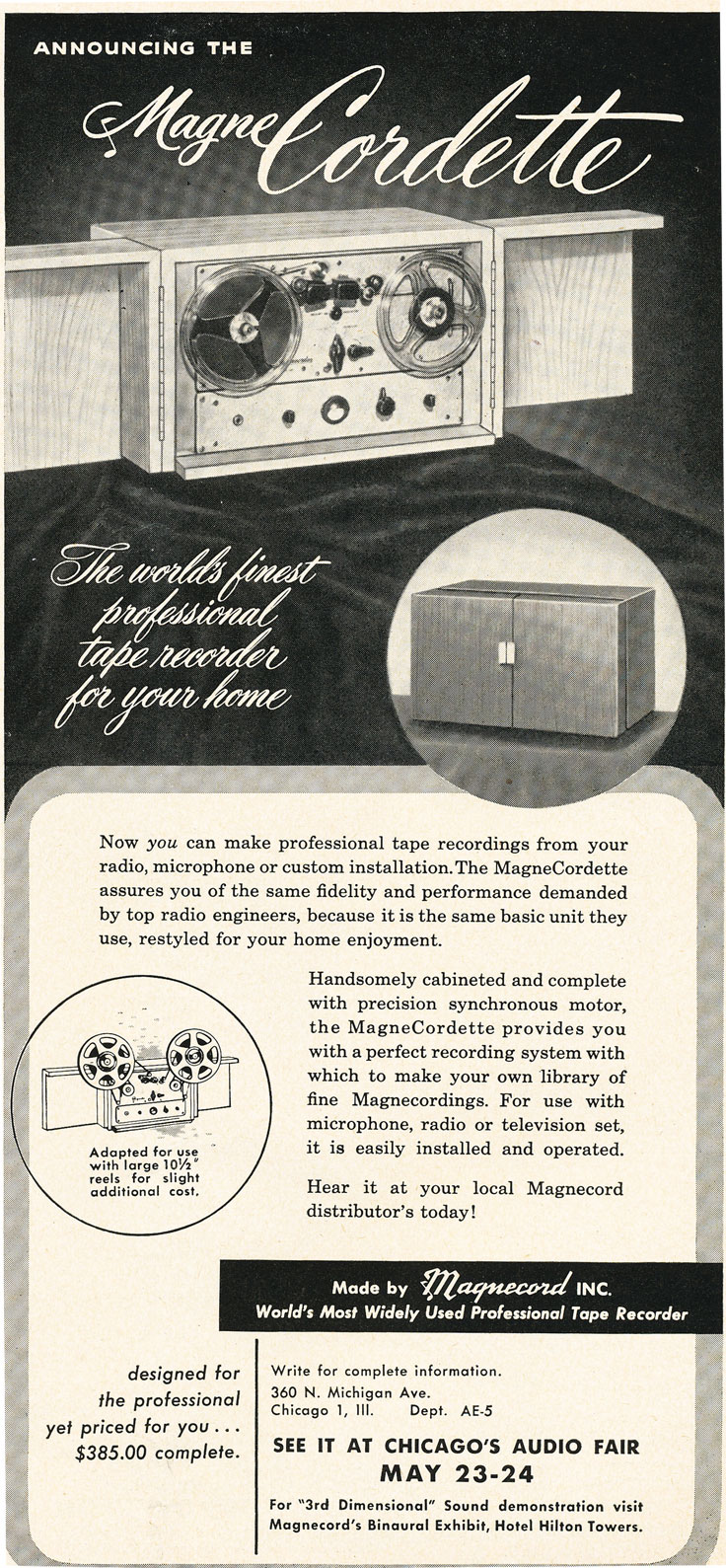
|
1952

|
1952
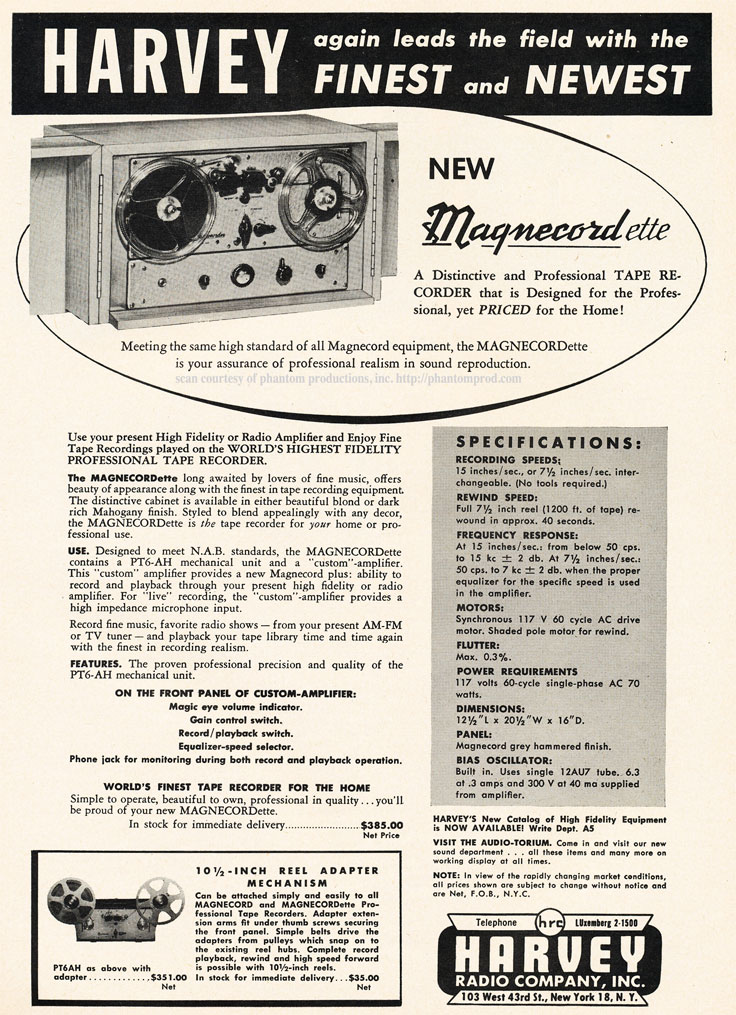
|
1952
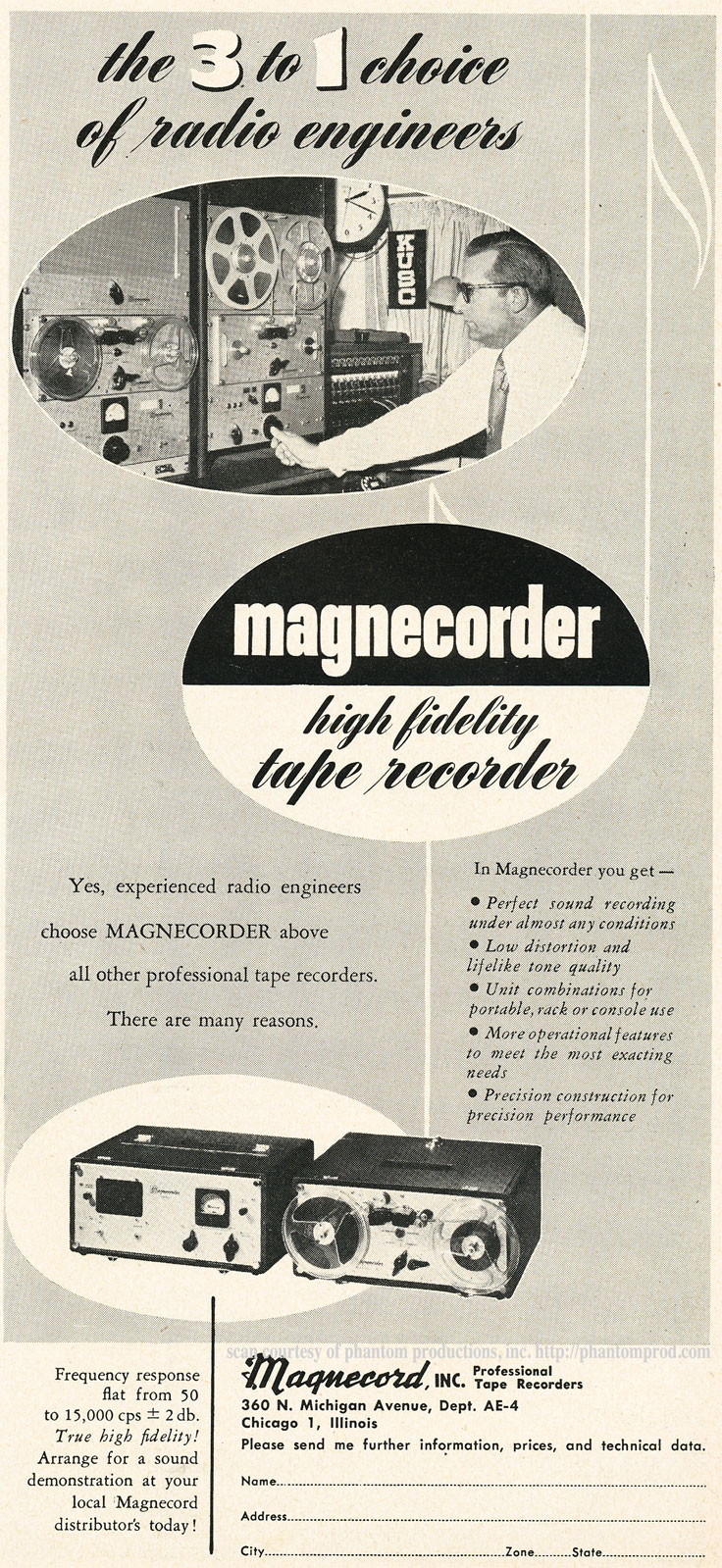
|
1952

|
1952
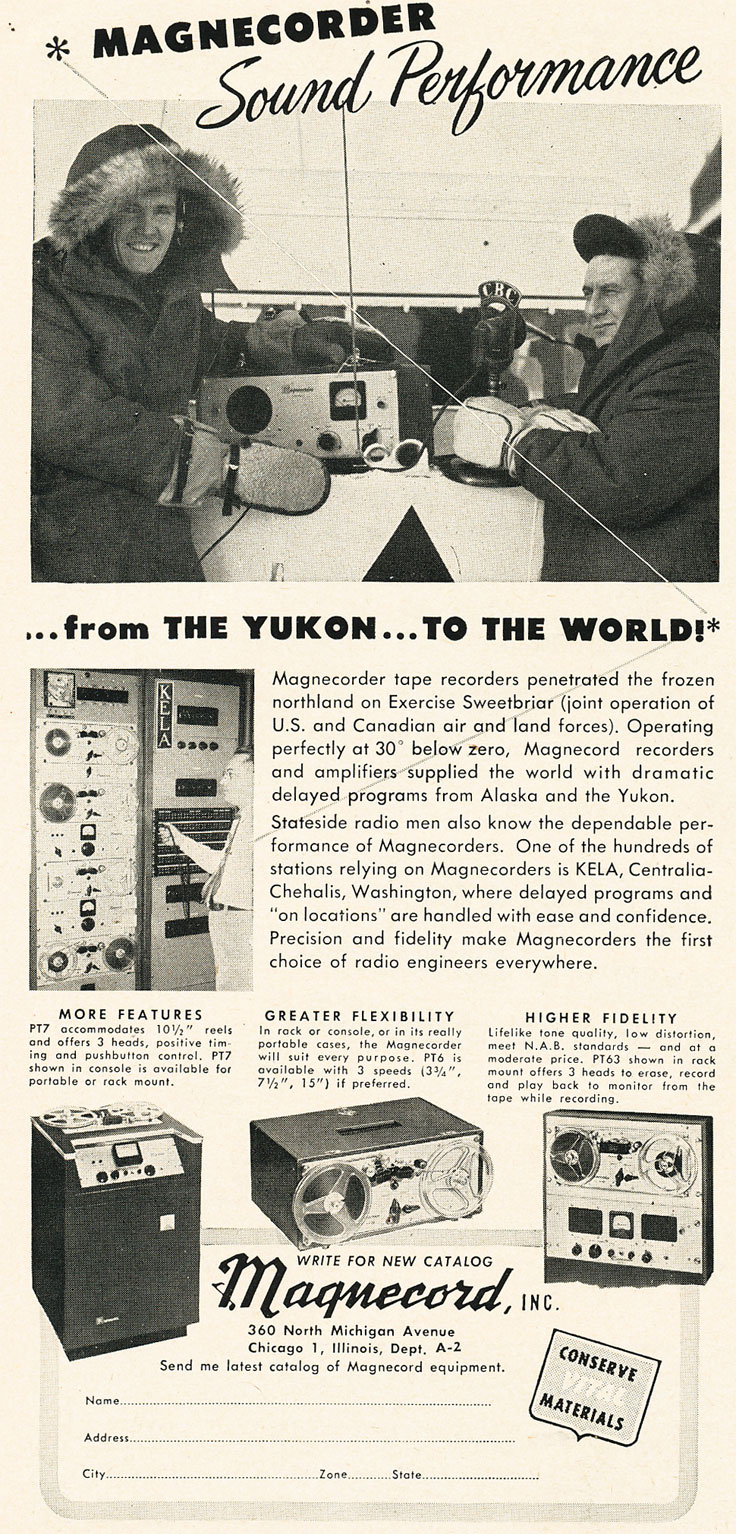
|
1952

|
1953
 
|
1953
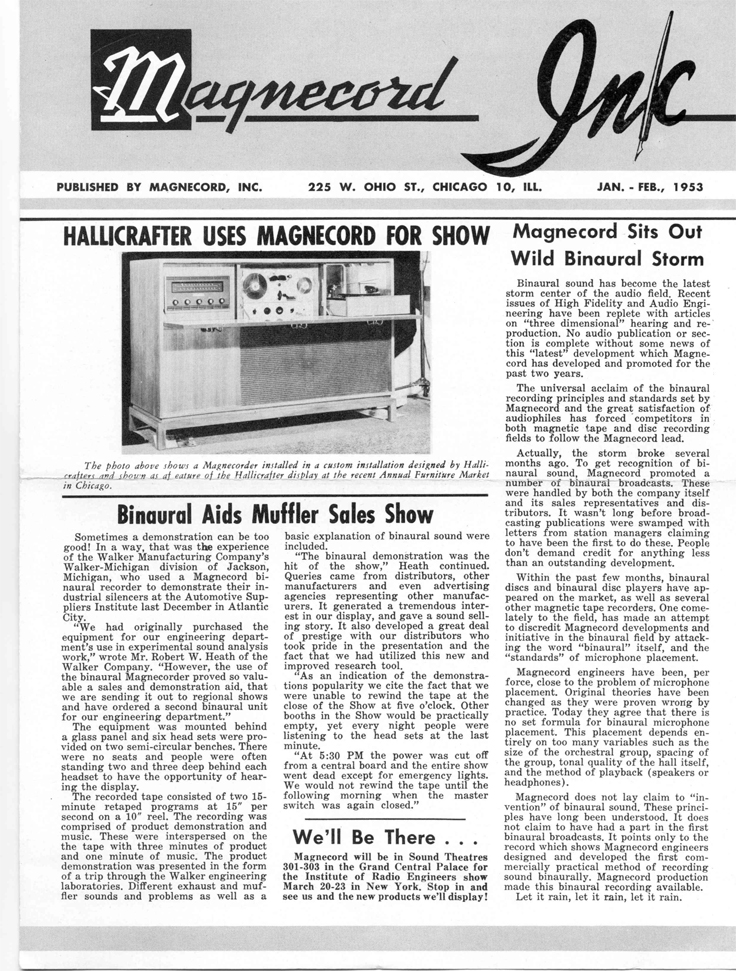
|
1953

|
1953

|
1953

|
1953
 |
1953
 |
1953
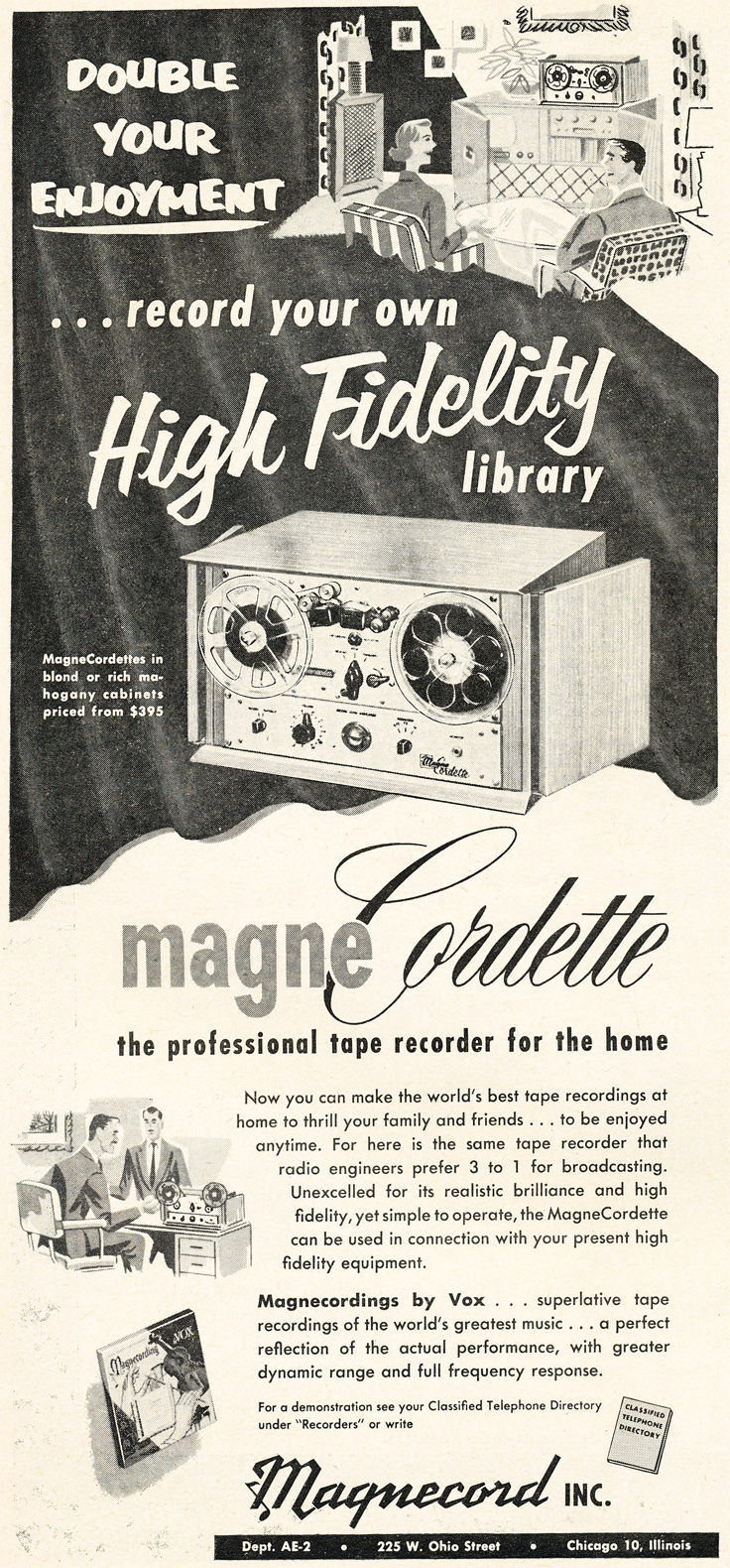 |
1953
 |
1953
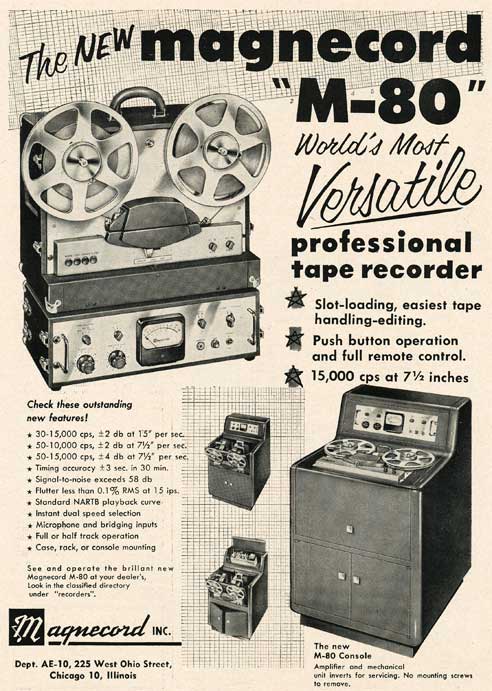 |
1953
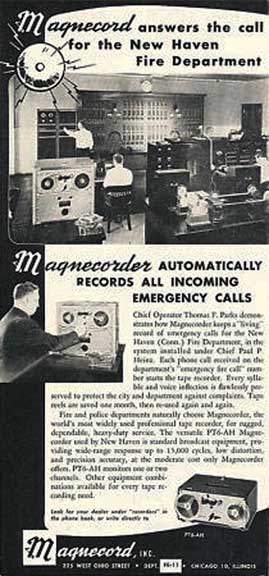 |
1953
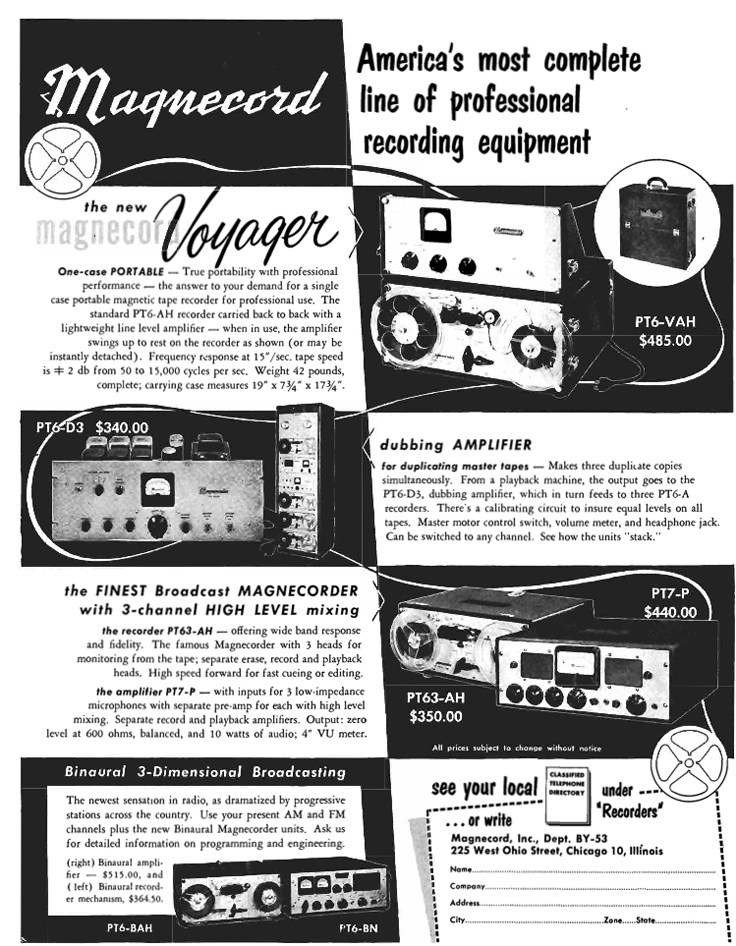 |
1953
 |
1954
 |
1954
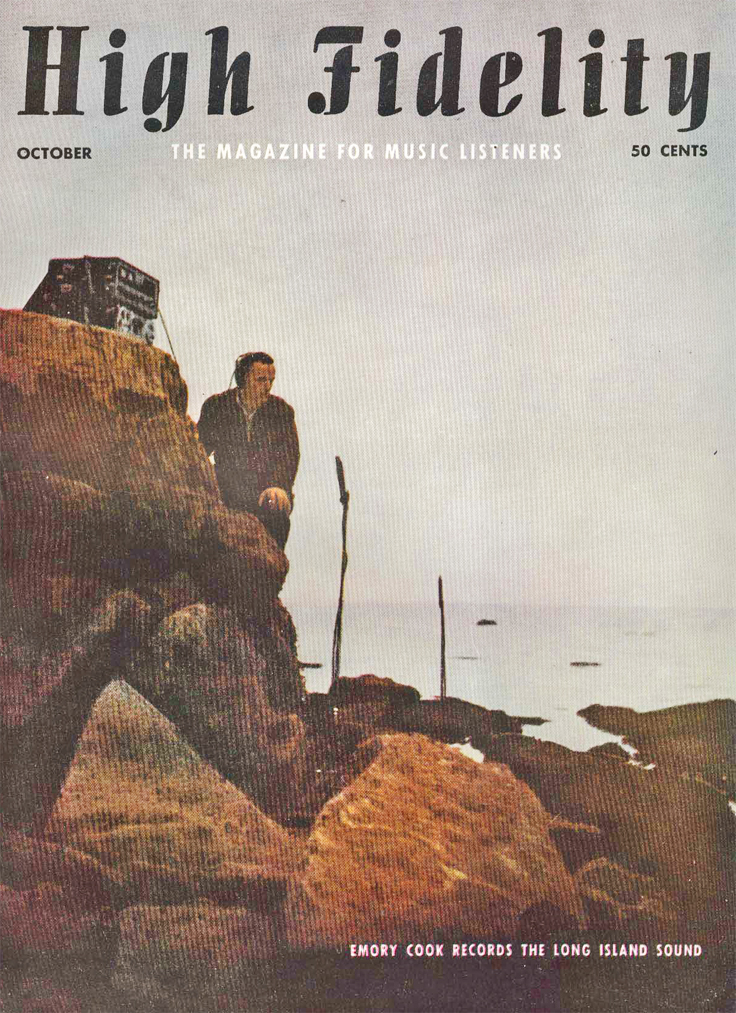 |
1954
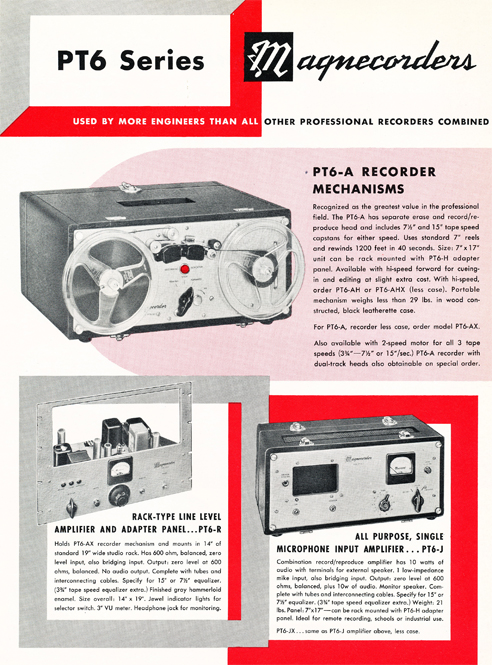 |
1954
 |
1954
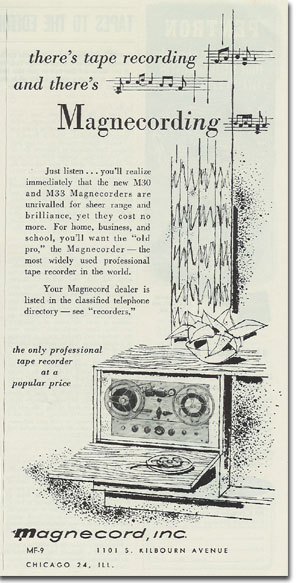 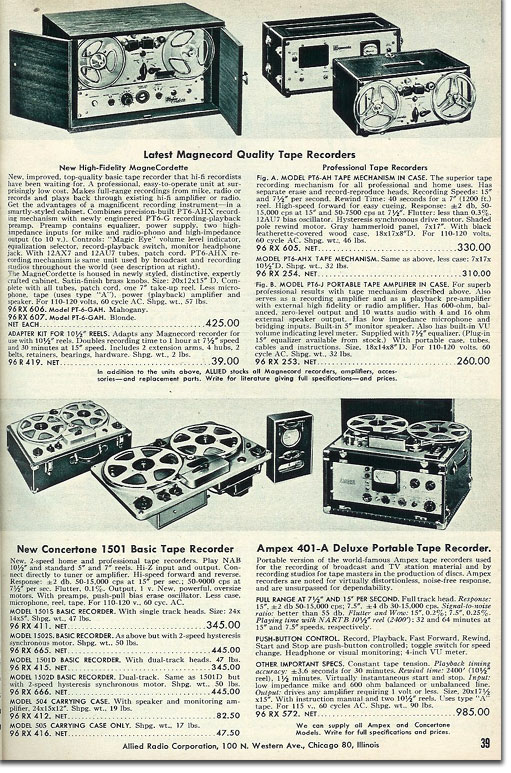 |
1954
 |
1954
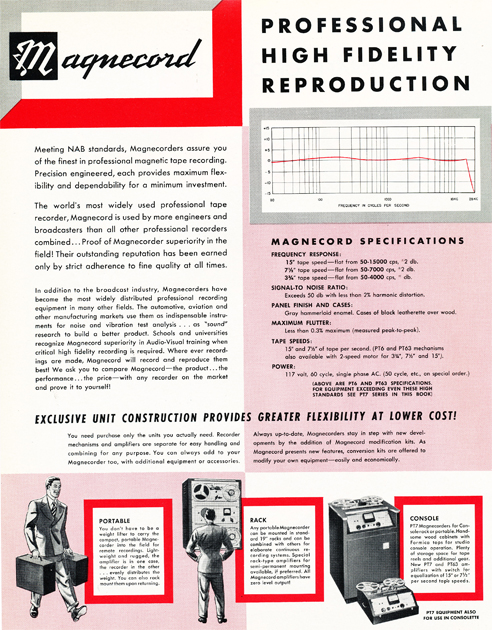 |
1954
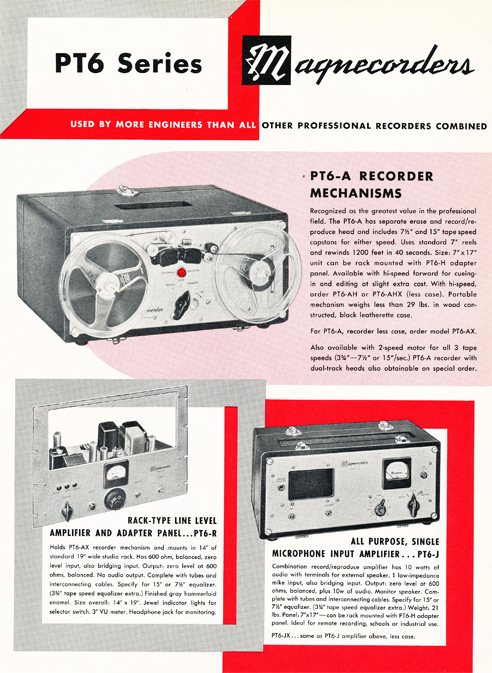 |
1954
 |
1954
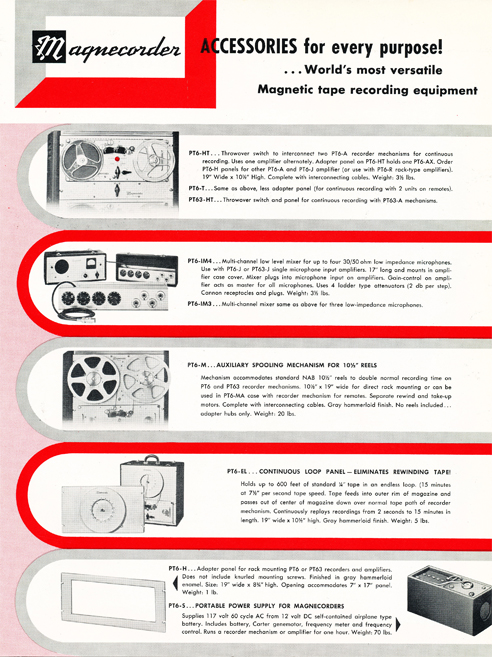 |
1954
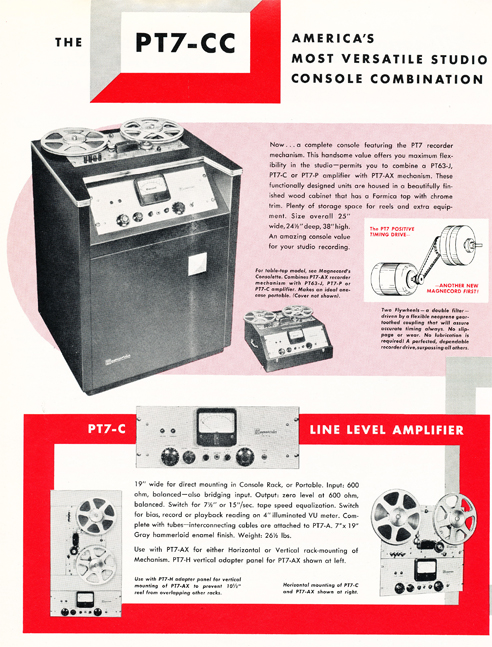 |
1954
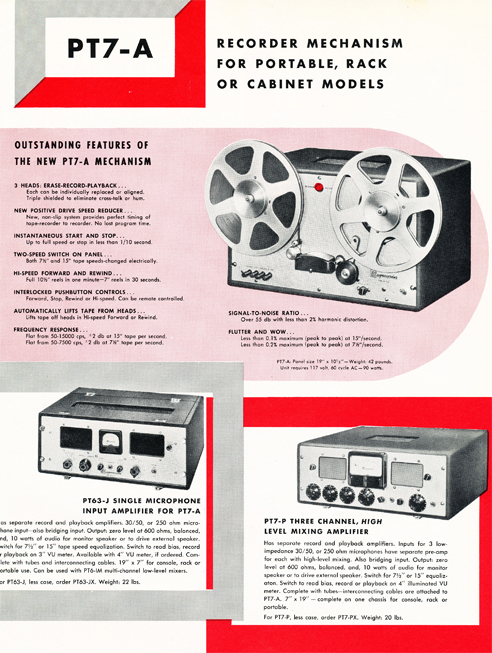 |
1954
 |
1954
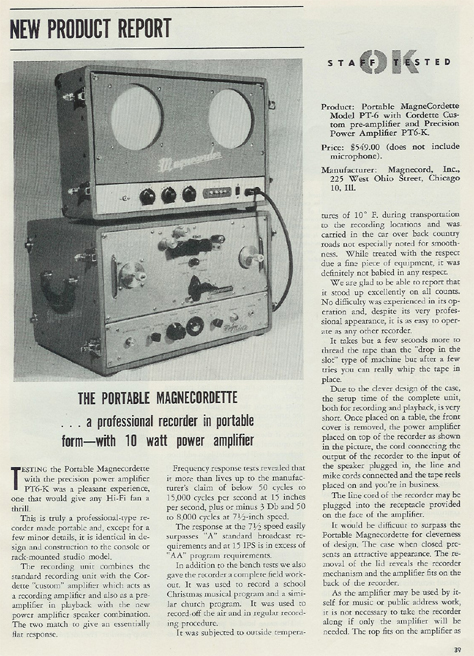 |
1954
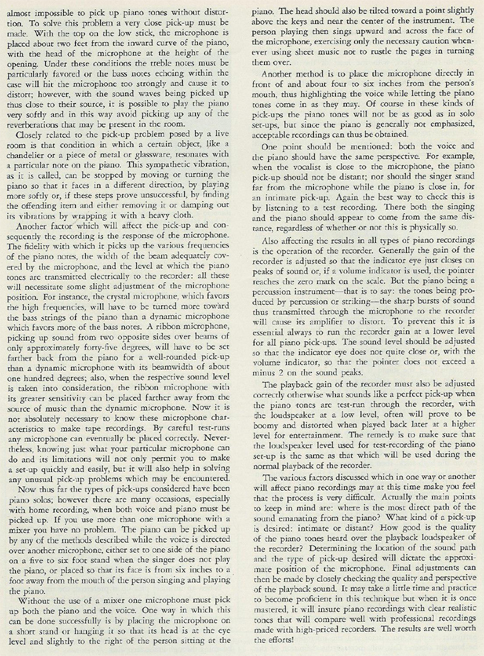 |
1954
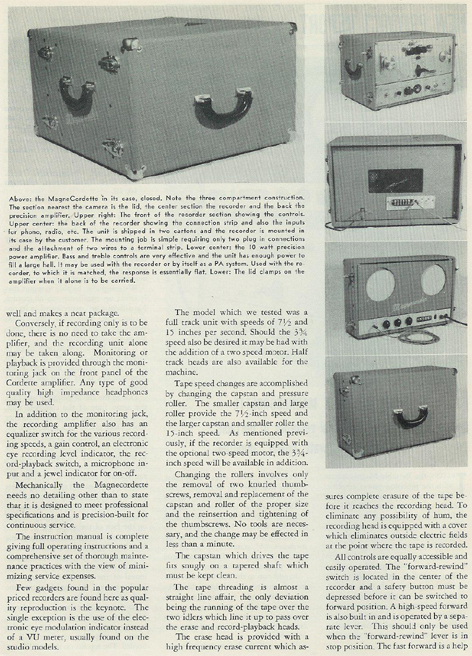 |
1954
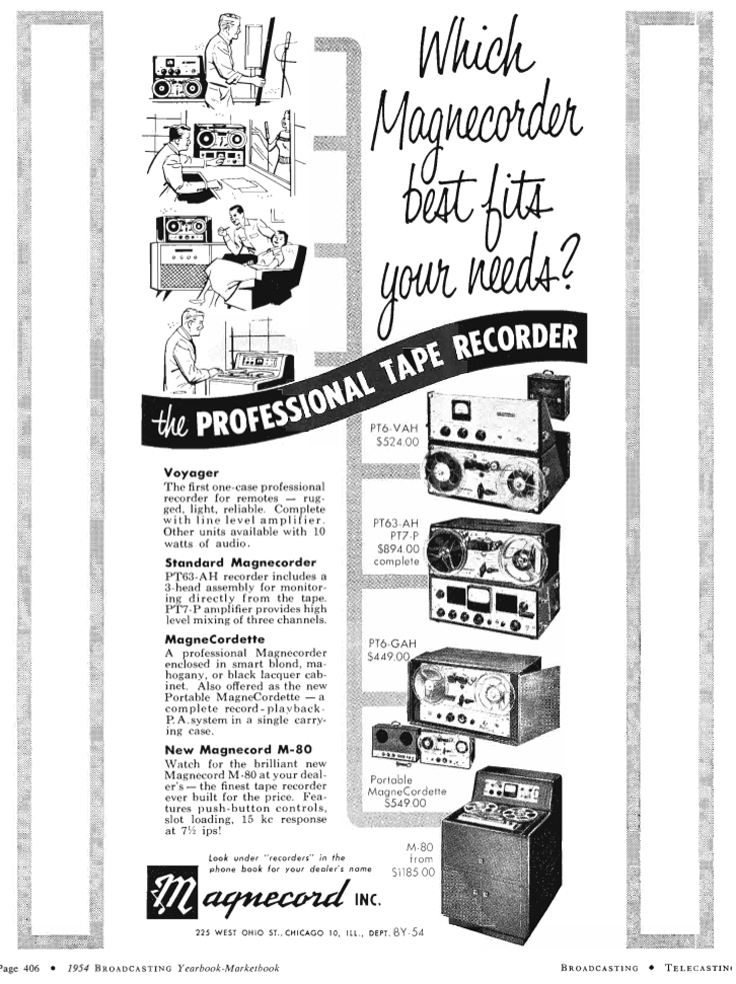 |
1954
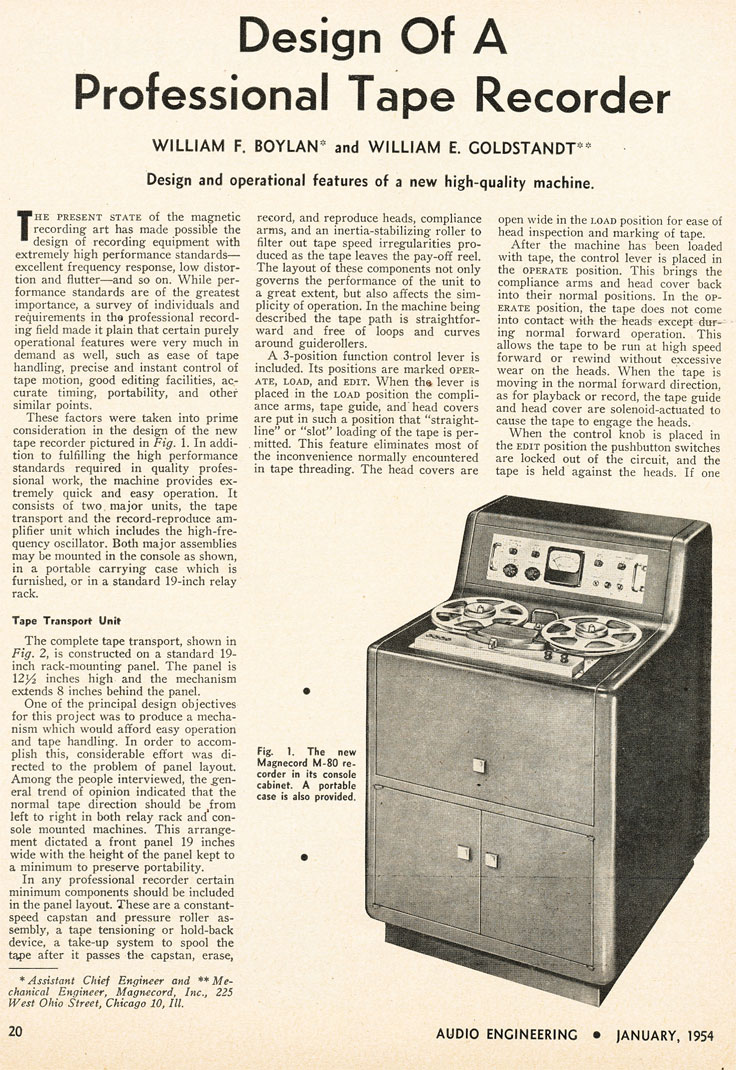 |
1954
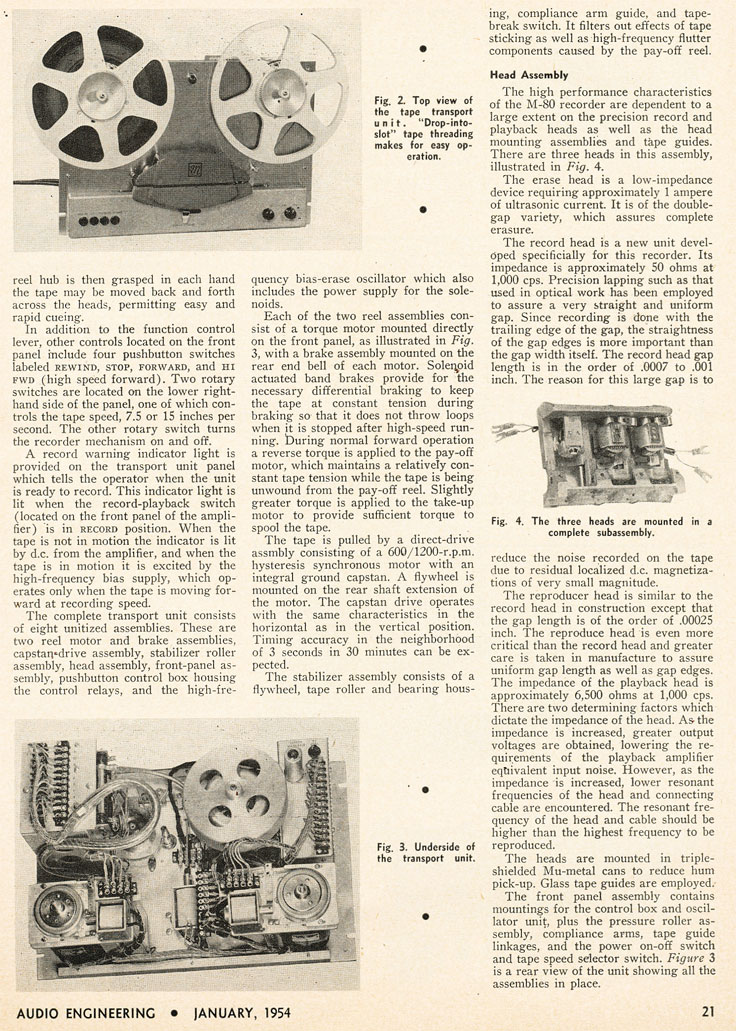 |
1954
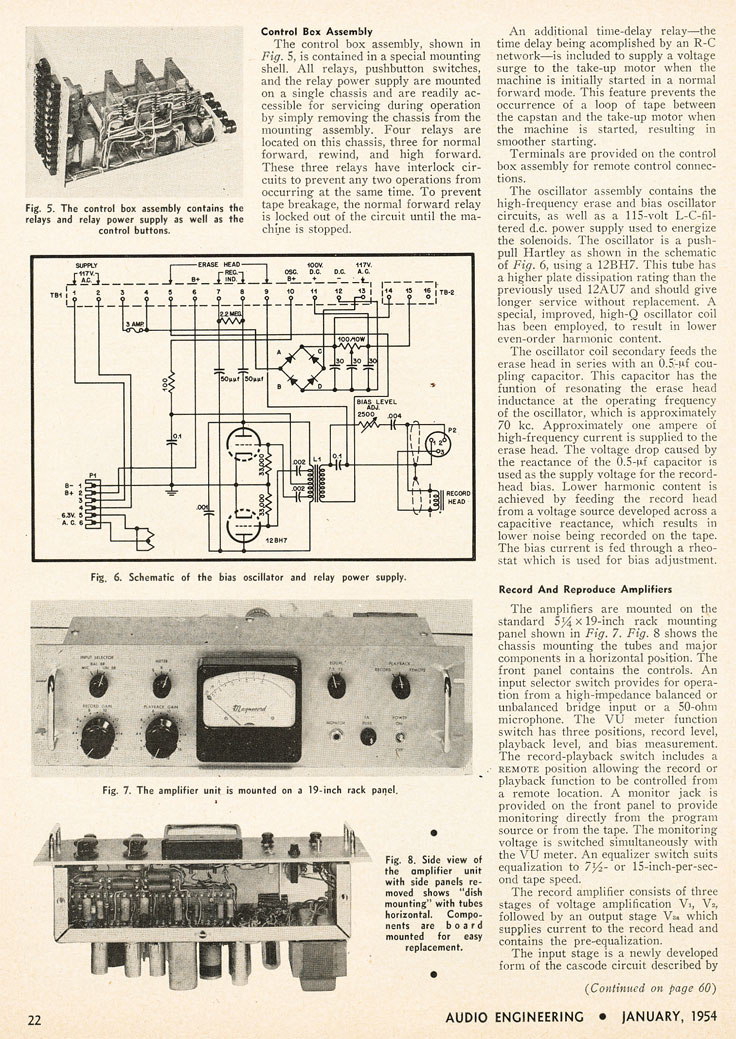  |
1954
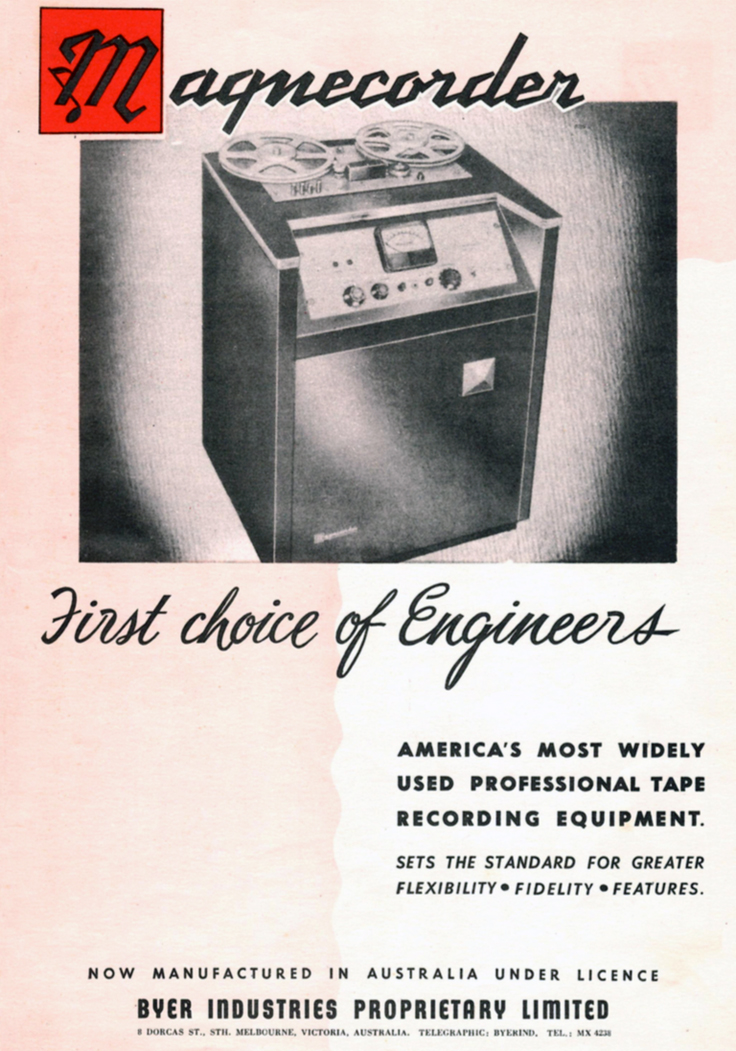
Magnecord Australia - click pic to view full pdf
|
1954
 |
1954
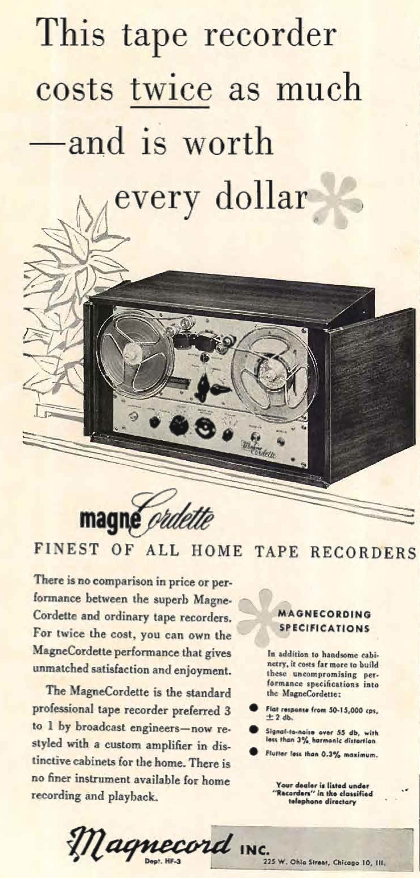 |
1955
 |
1955
 |
1955
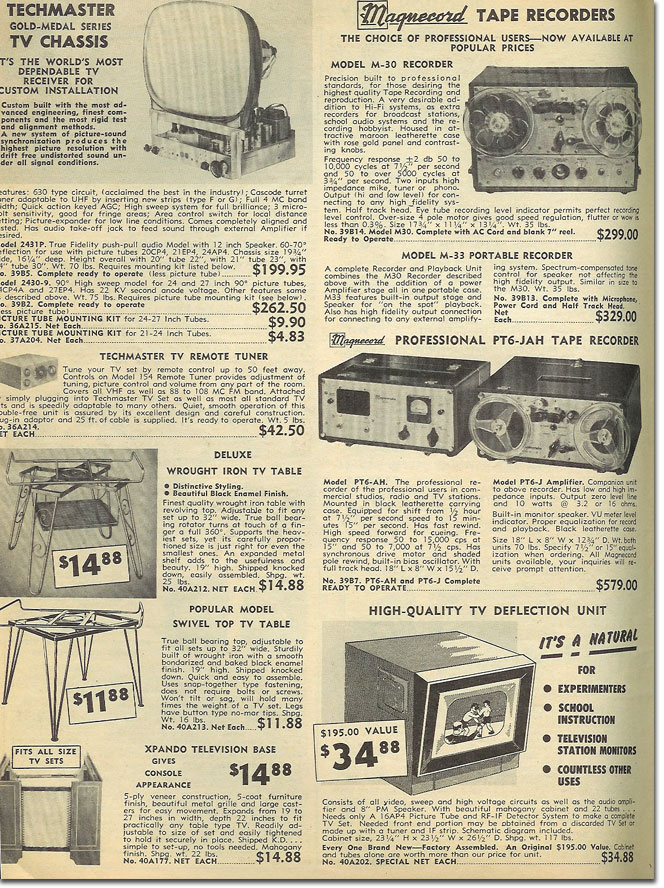
|
1955

|
1956
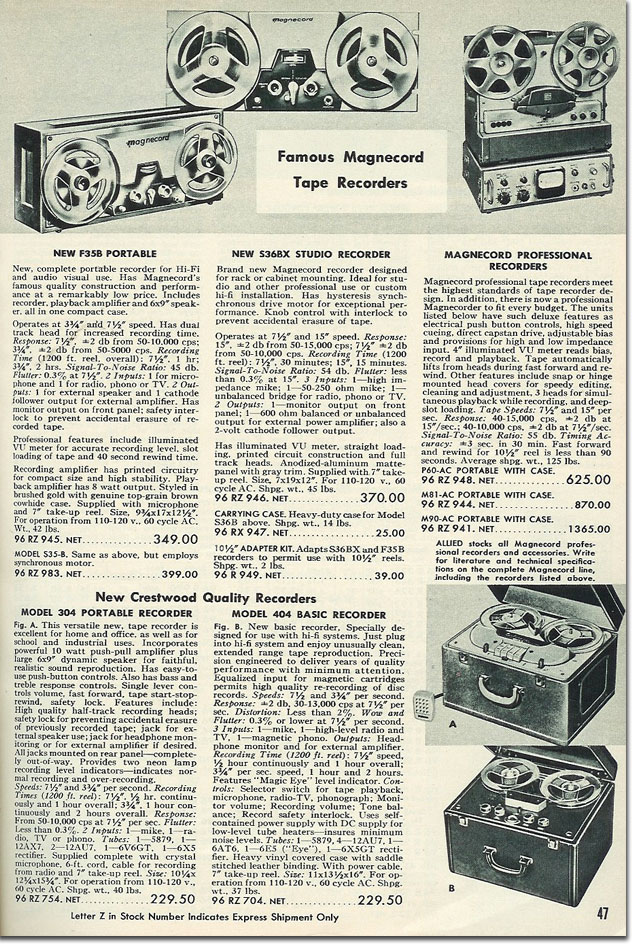 |
1956
 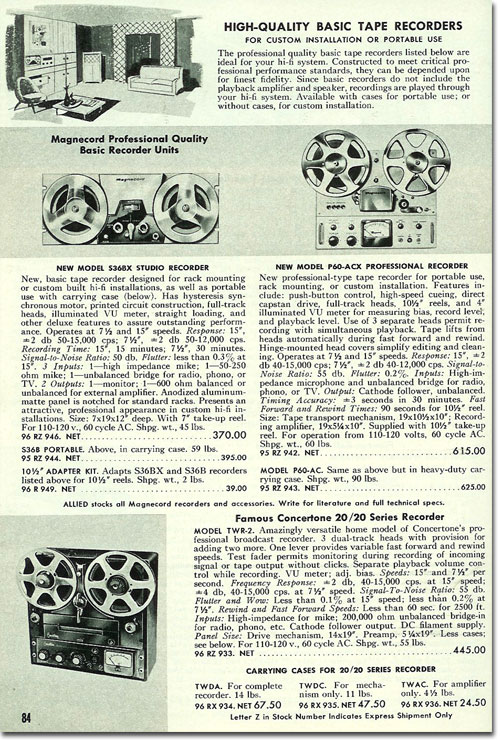 |
1956
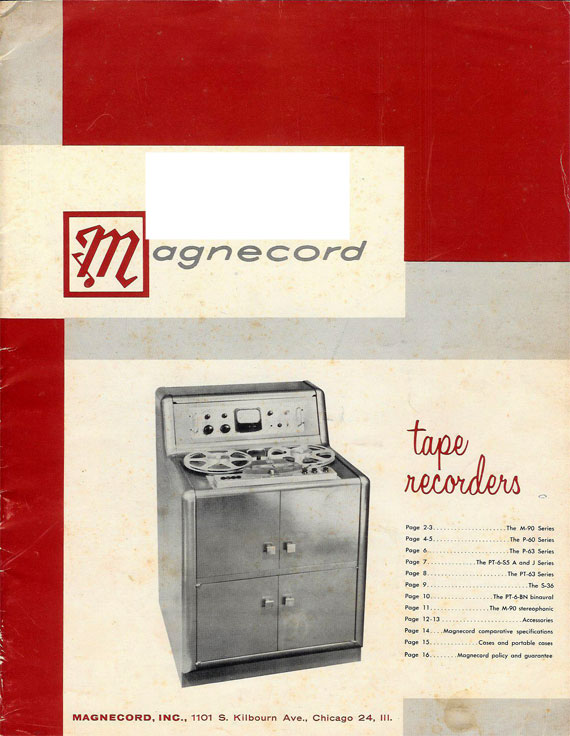 |
vinAd56Magn
1956
 e |
1956
 e |
1956
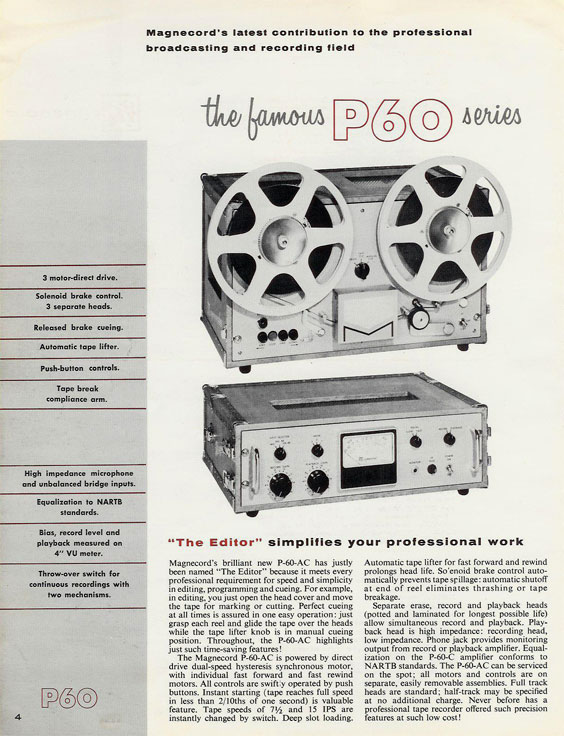 e |
1956
 |
1956
 |
1956
 |
1956
 |
1956
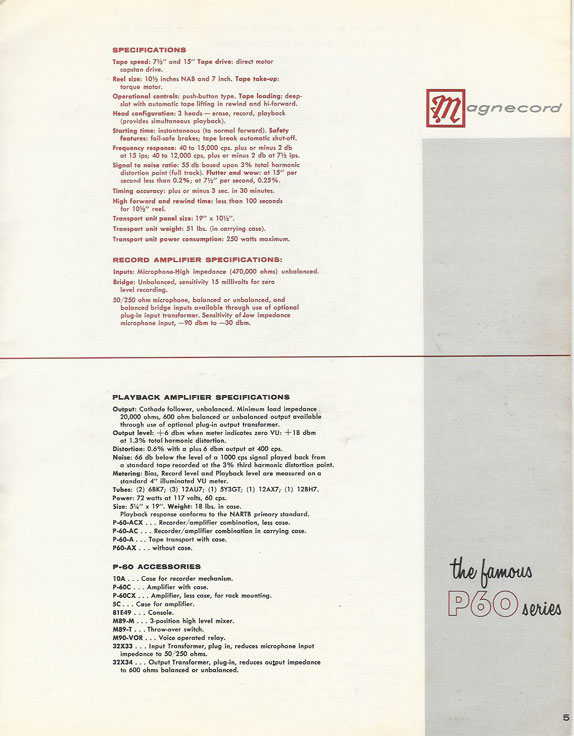 |
1956
 |
1956
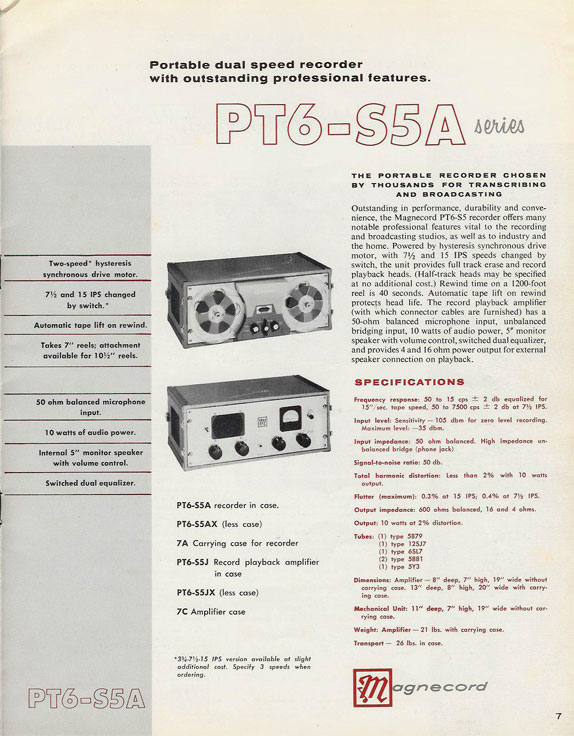 |
1956
 |
1956
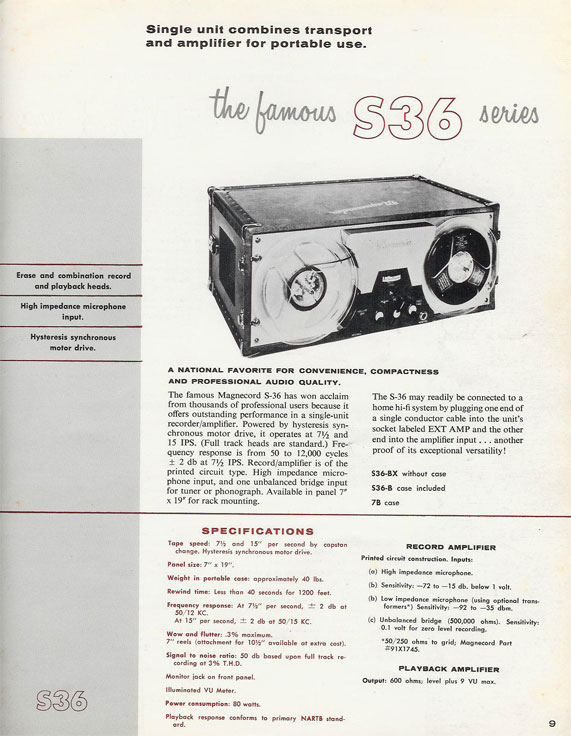 |
1956
 |
1956
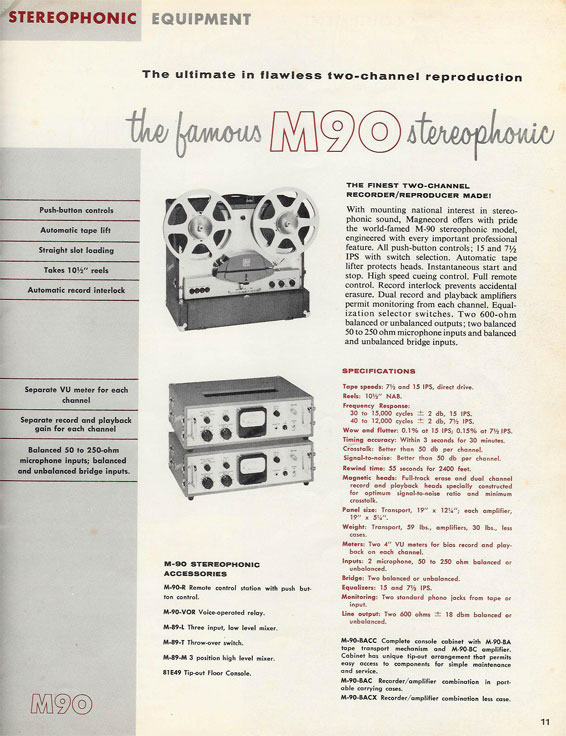 |
1956
 |
1956
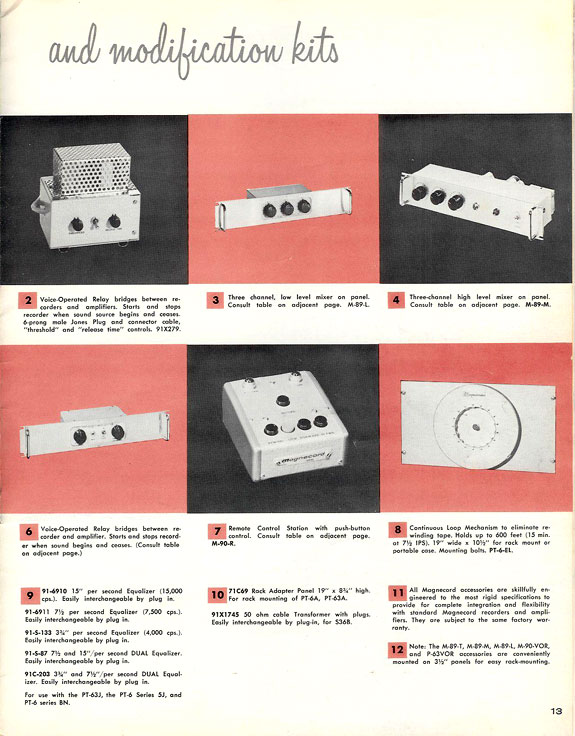 |
1956
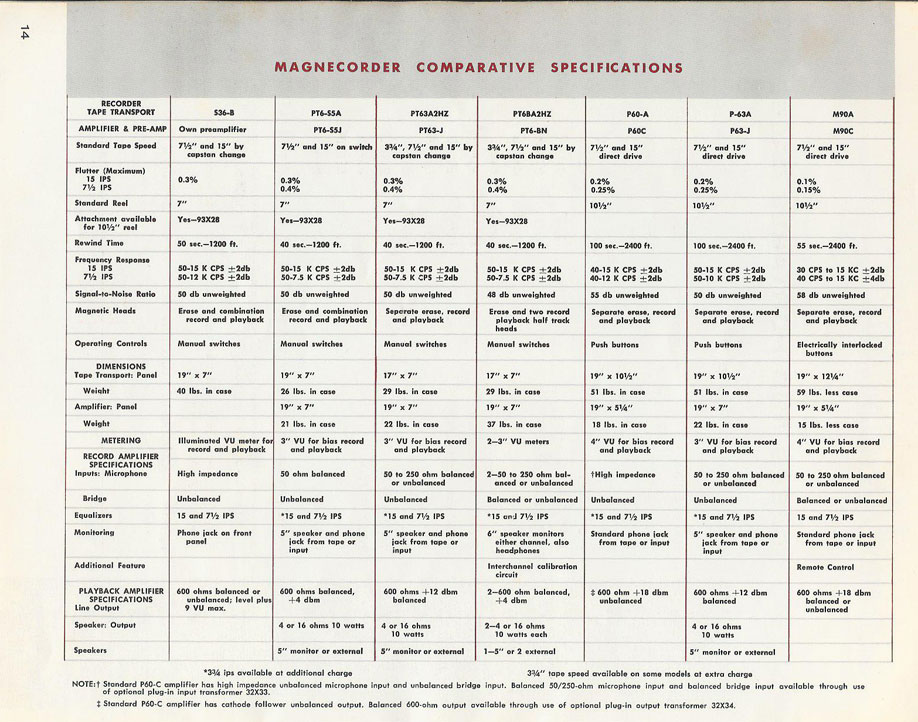 |
1956
 |
1956
 |
1956
 |
1956
 |
1956
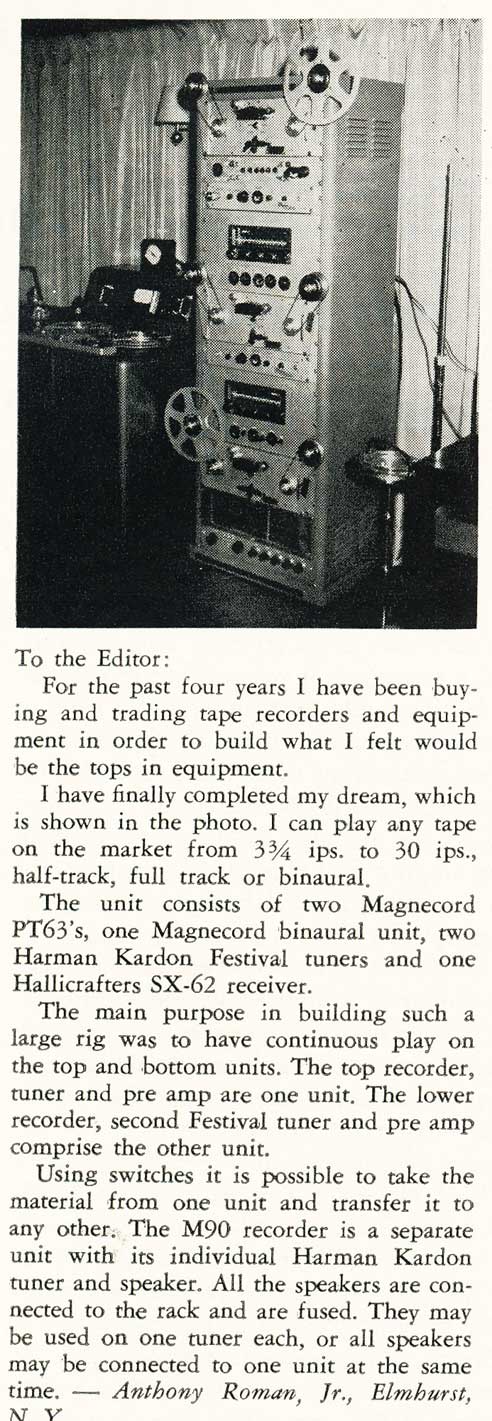 |
1957
 |
1958
 |
1958
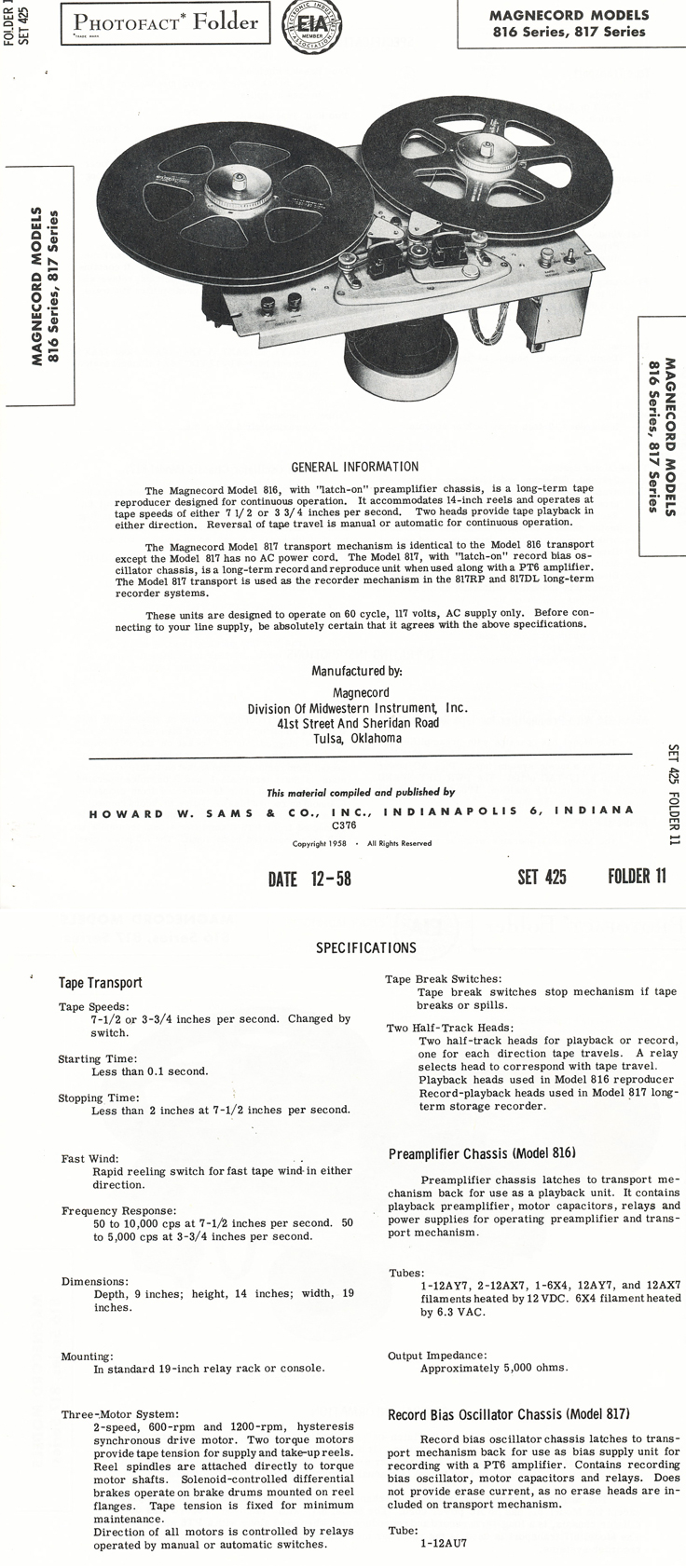 e 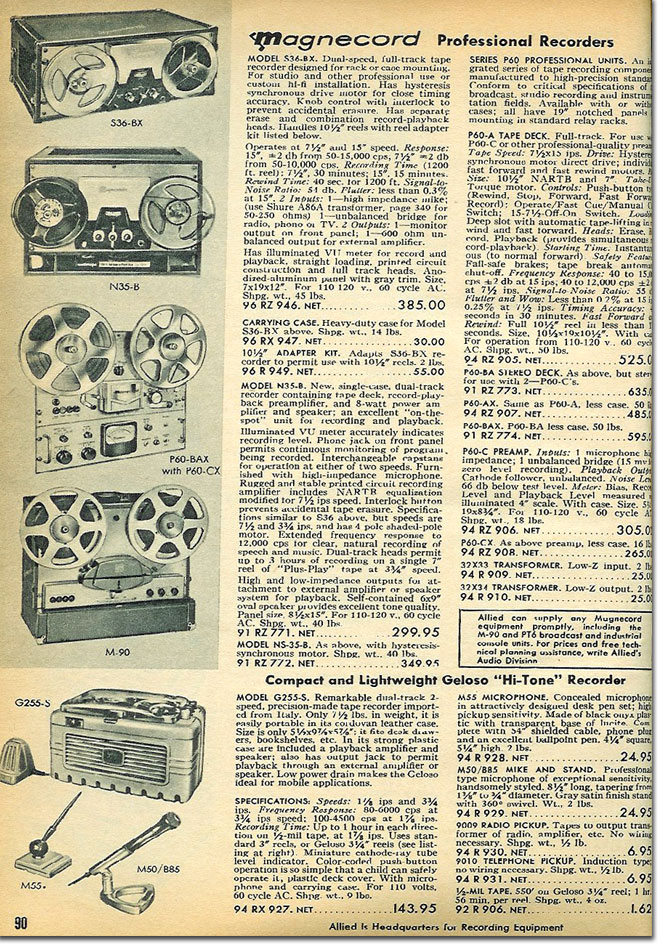 |
1958
 |
1958
 |
1958
 |
1958
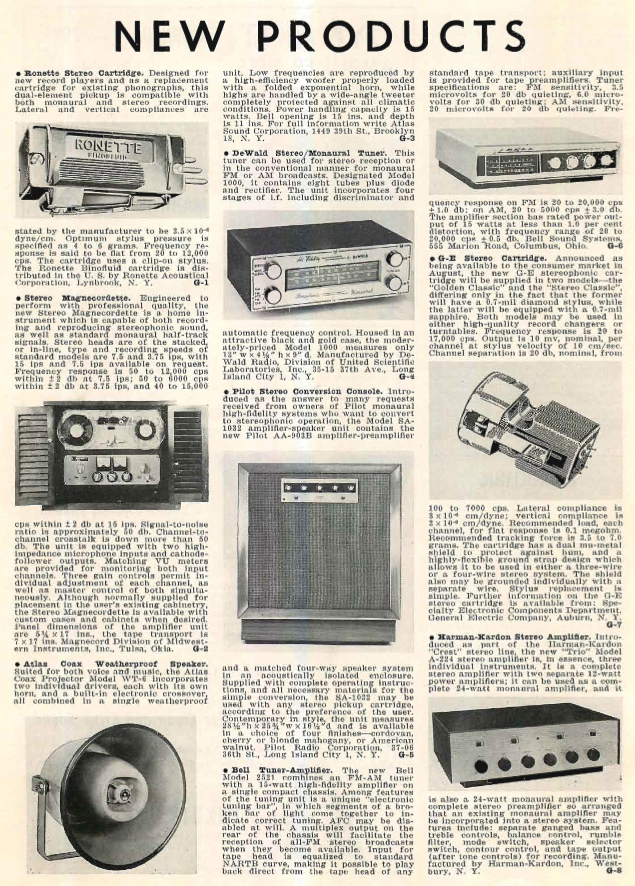 |
1959
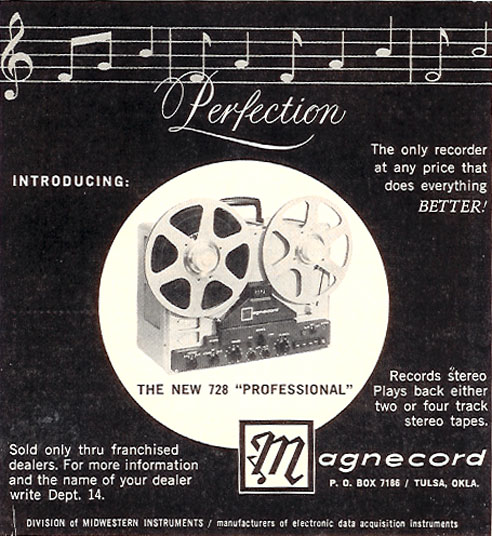 |
1959
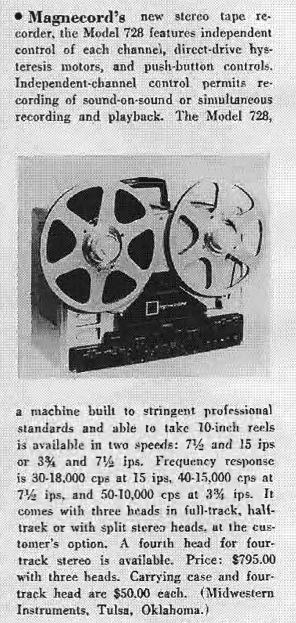 v  |
1959
 e 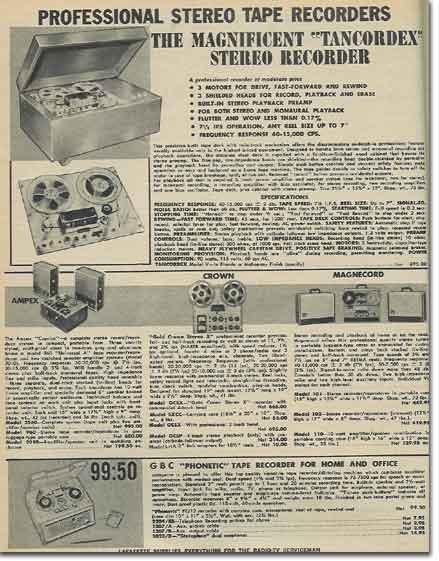 |
1960
  |
1960
  |
1960
 |
1960
 |
1961
 |
1961
 |
1961
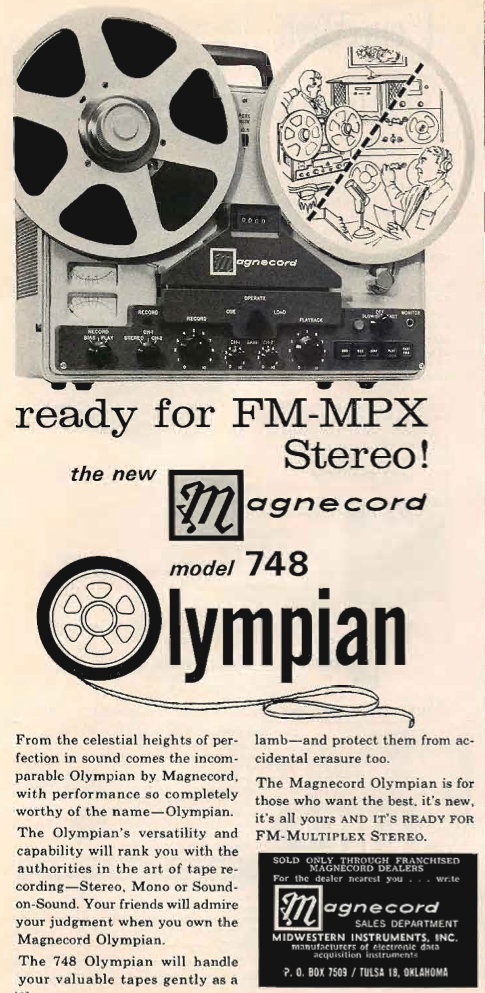 |
1962
 |
1962
 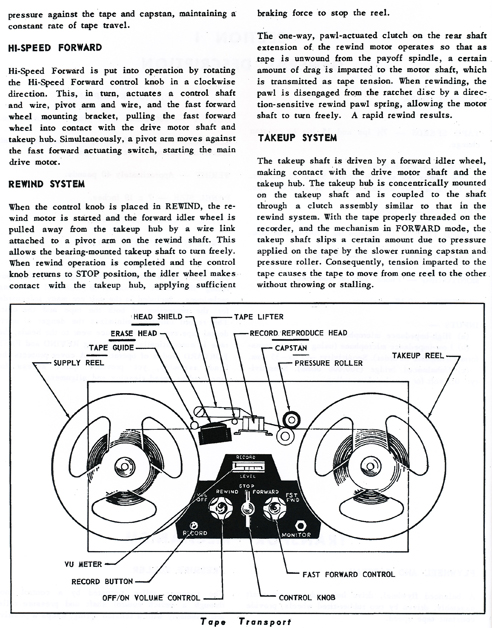 |
1962
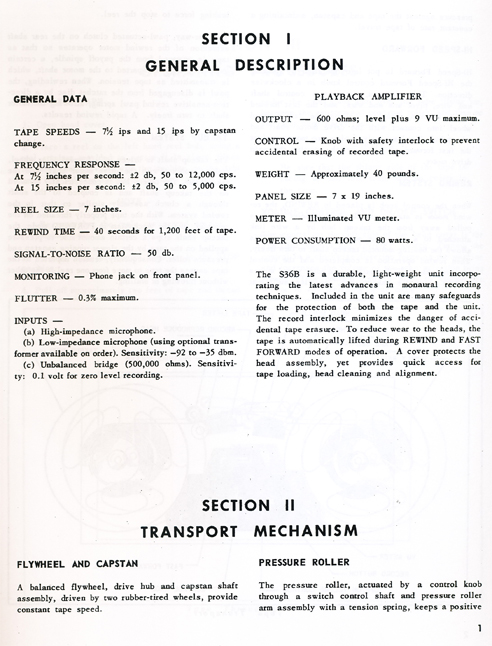 |
1962

|
1963

|
1964
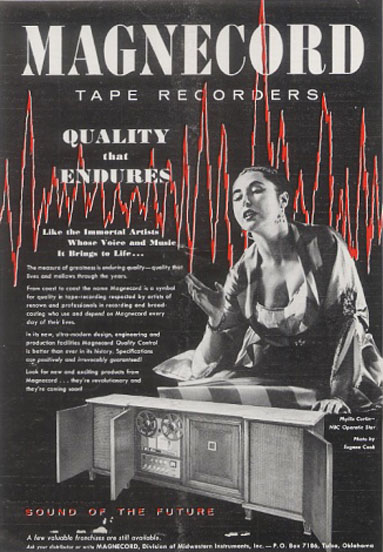 |
1965
 |
1965
 |
1965
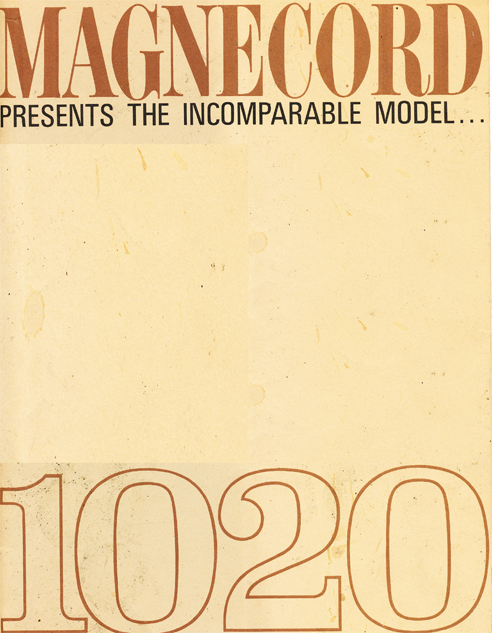 |
1965
 |
1965
 |
1965
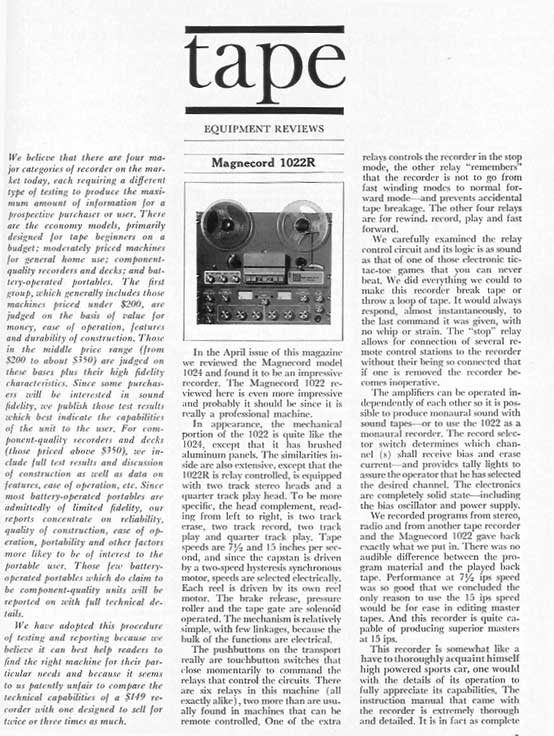 |
1965
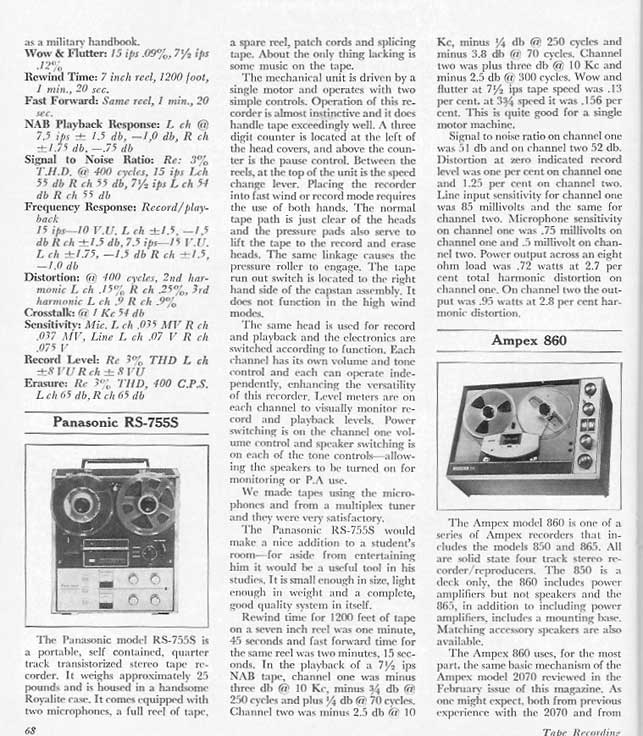 |
1965
 |
1965
 |
1965
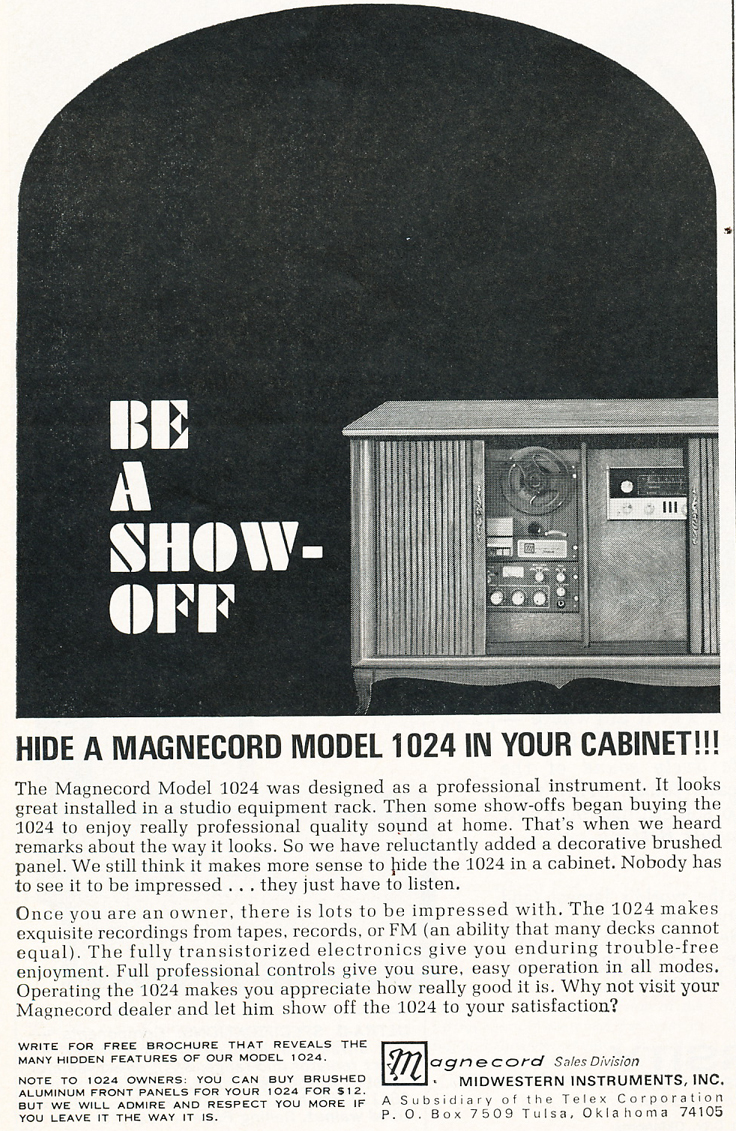 |
1965
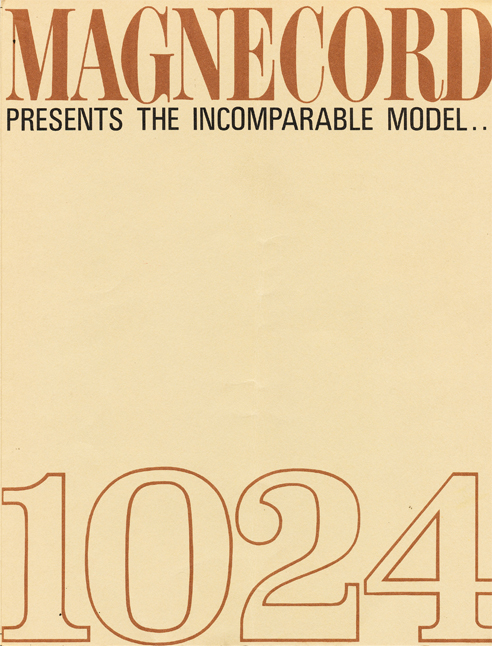 |
1965
 |
1965
 |
1966
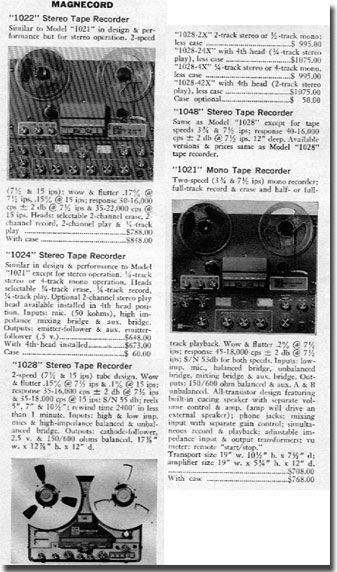 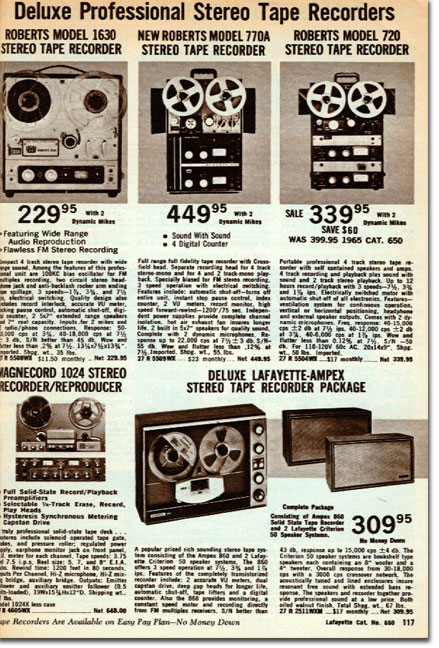 |
1966
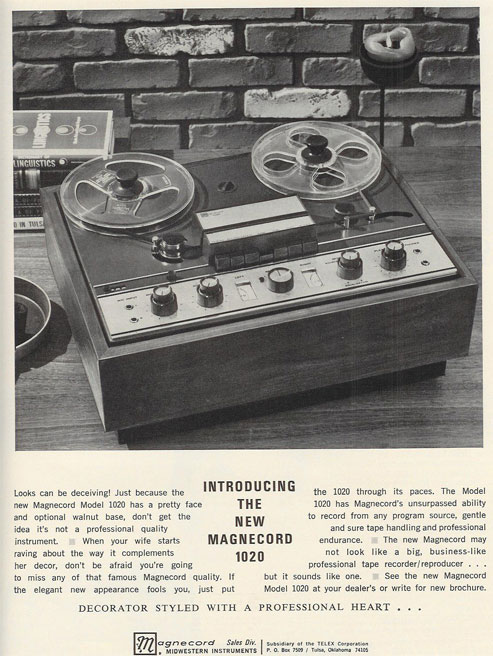 |
1966
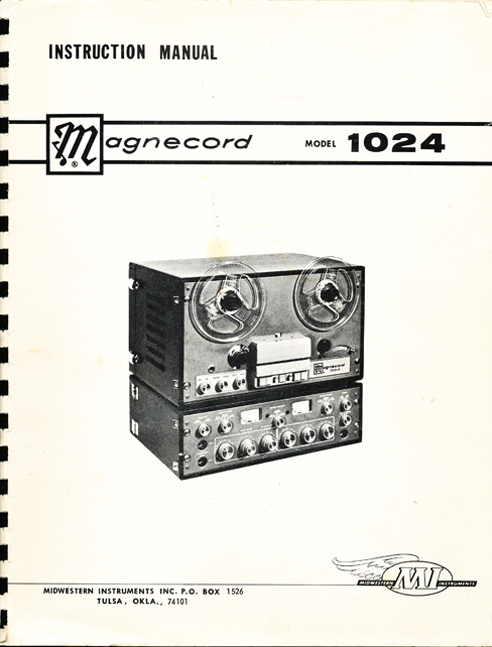 |
1966
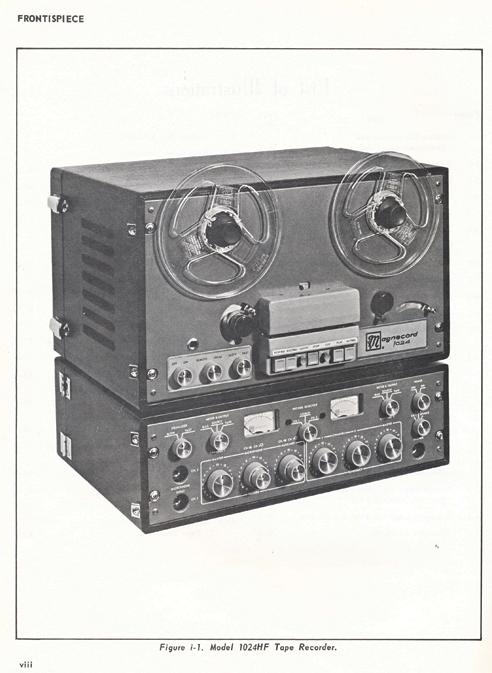 |
1966
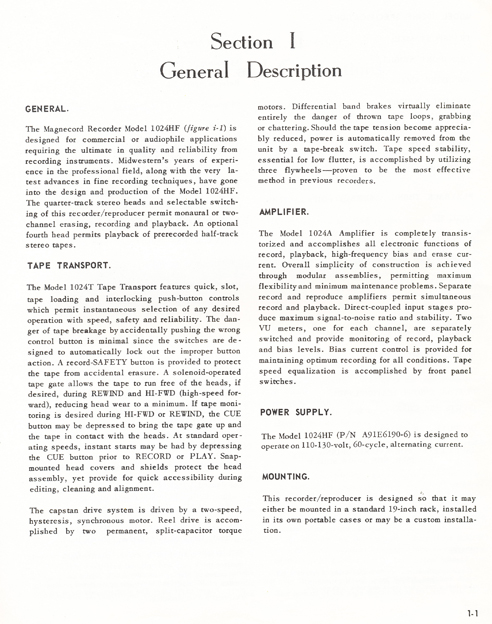 |
1966
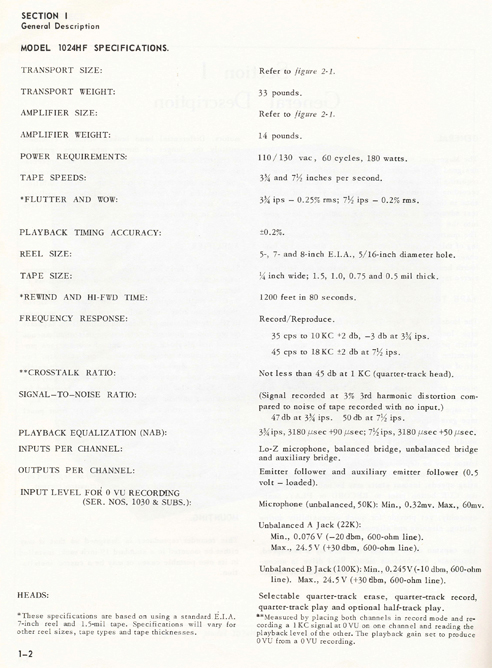 |
1966
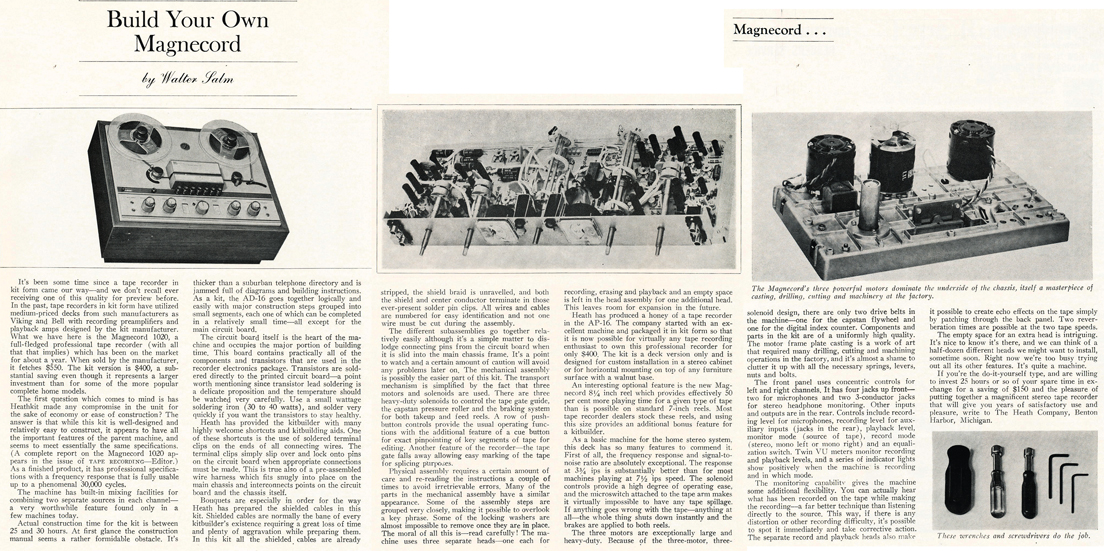 |
1967
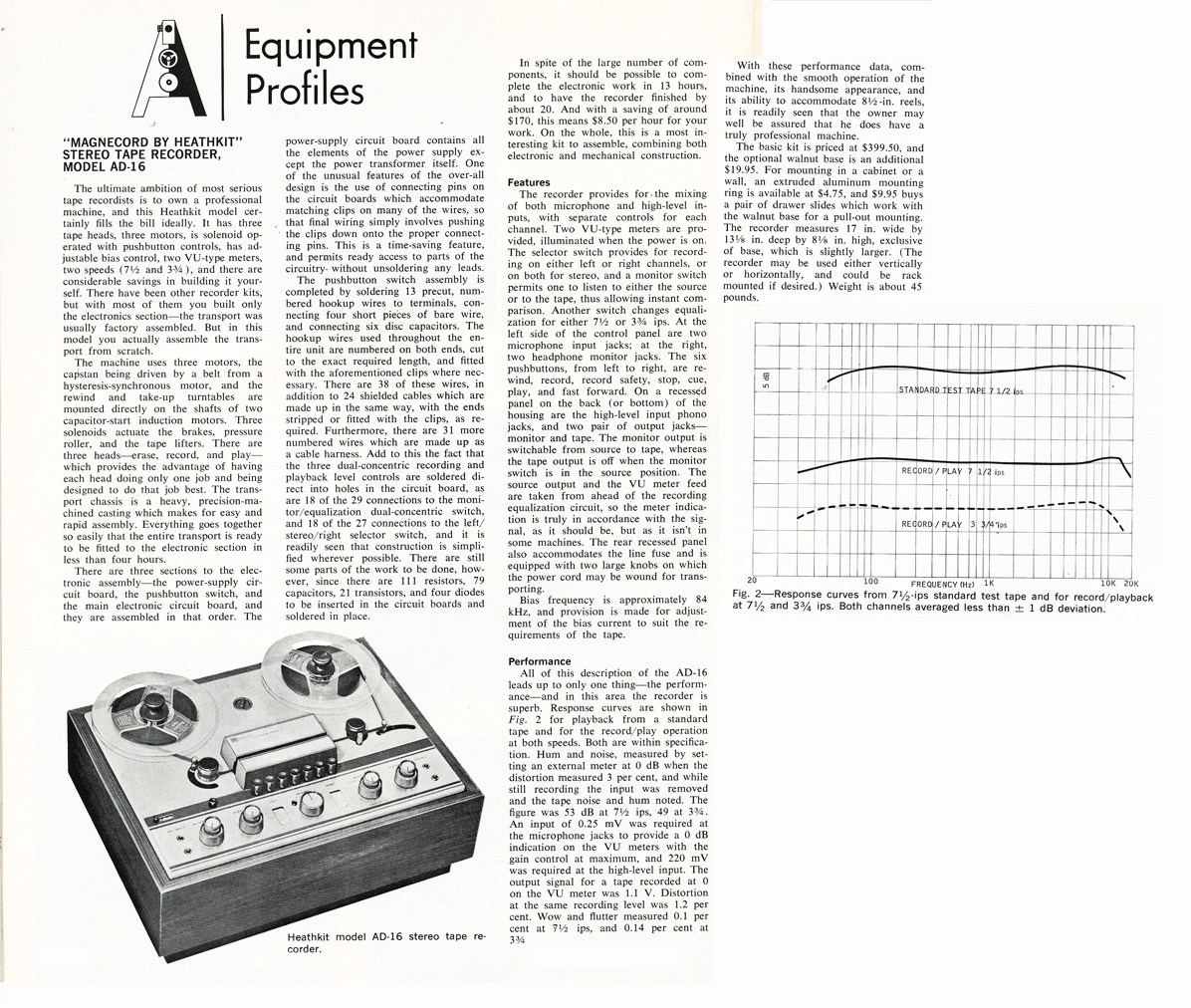 |
1967
 |
1967
 |
1968
 |
1970
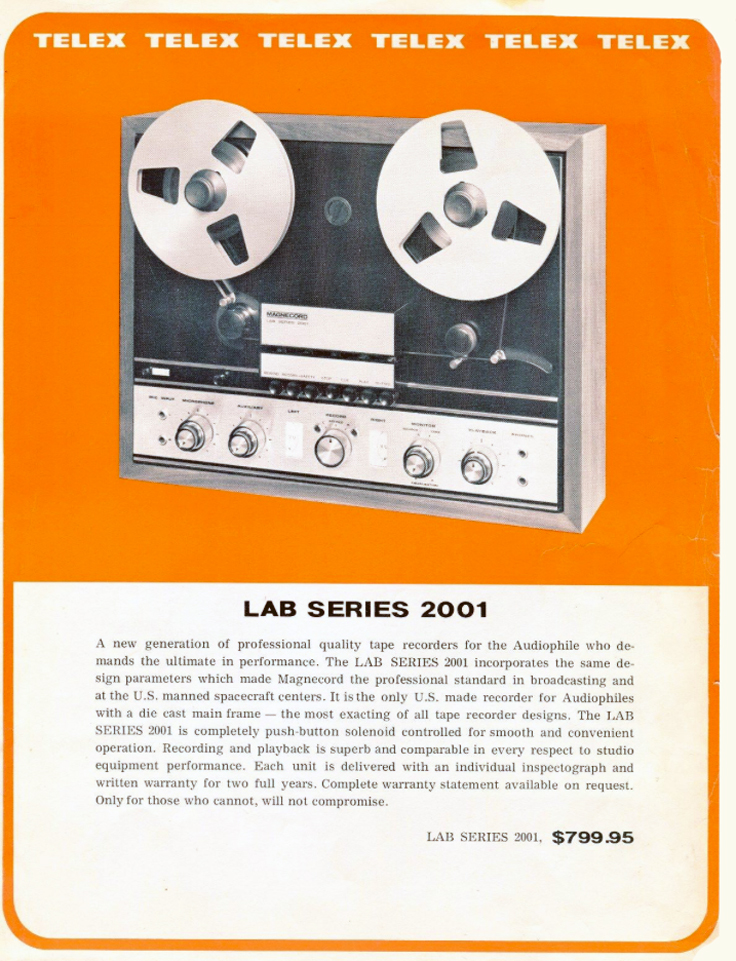
|
1970

|
1970

|
|
|
1977

|
1979

|
1979
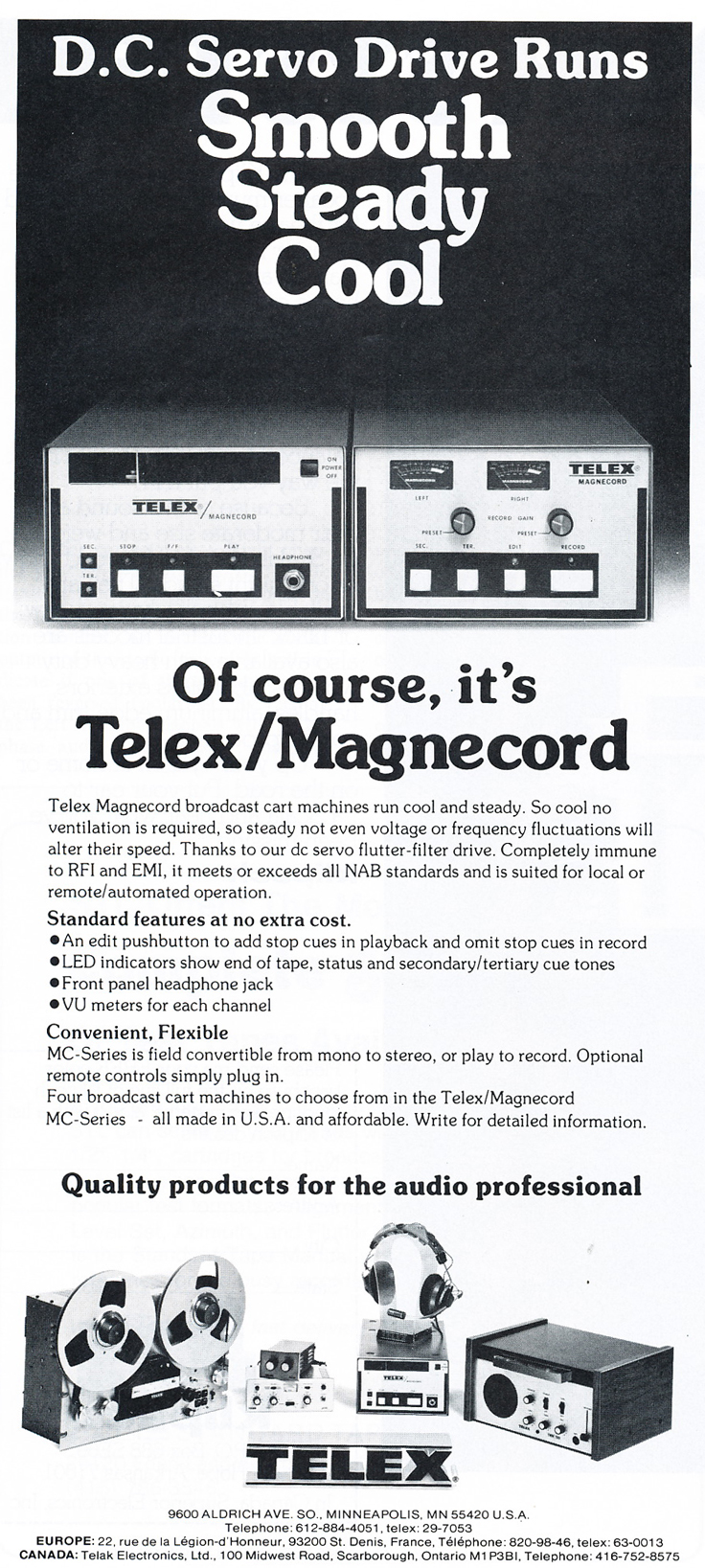
|
1979

|
|
|
|
|
|
Magnecord photos from third parties
We appreciate all photos sent to our museum. We hope to successfully preserve the sound recording history. If we have not credited a photo, we do not know its origin if it was not taken by the contributor. Please let us know if a photo on our site belongs to you and is not credited. We will be happy to give you credit, or remove it if you so choose.
Magnecord timer unit

|
|
|
|
|
|
|
|
|
Magnecord P 63
|
|
|
|
|
|
|
|
|
Magnecord PT-6 Amplifier
|
Magnecord PT-6 |
|
|
|
|
|
Magnecord PT-6 & PT-6A
|
|
|
|
|
MagnecorDETTE |
|
|
|
|
Magnecord M 728
|
|
|
|
|
|
|
|
|
|
|
|
|
|
|
|
|
Magnecord Cordette
|
Magnecord Heathkit |
|
|
|
|
|
Magnecord BiAmp
|
|
|
|
|
Magnecord 100C |
|
|
|
|
Magnecord 1022 |
|
|
|
|
|
|
|
|
Magnecord 1024A Deck & 1024T Pre Amp
|
|
|
|
|
|
|
|
|
Magnecord Phonolo |
|
|
|
|
|
|
|
|
MagnecorD/telex 3000 |
|
|
|
|
Phonola Magnecord photo by Nilesh Matade |
|
|
|
|
|
|
|
|
|

